inbox@english-medieval-antiques.com ©English Medieval Antiques

Self evidently the back of an oak carving, this is a twelfth century English full length figure of King Stephen. Known provenance leads to the expectation that this is from Furness Abbey in Cumbria which was founded by Stephen in 1123.
Rarity of such early English figure sculpture, most particularly of an identifiable person, verges on the non-existent. His deeply dried surface points to protective immuration for centuries.
He most worthily occupies pride of place on the Homepage.
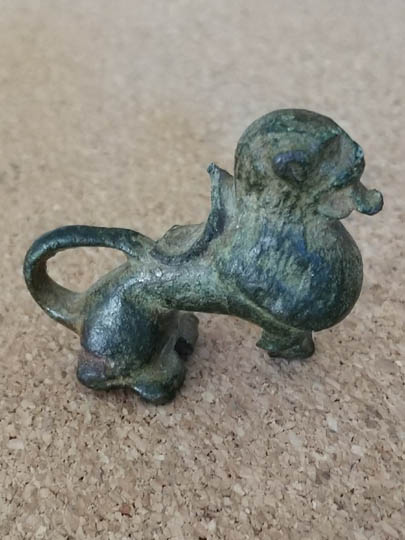
The 1 1/2 x 1 1/4 x 3/4" Lion is complete and in good order except for damage to its right lower leg, loss of the Candlestick-bearing figure of Henry, and extensive degradation of the gilding. Incised, highly symbolic decoration depicts Henry with his deceased brother William, many wild animals, and other images of functional objects. The Lion and its decoration were formed by a miniaturist who, despite their minutely small size, rendered the images so skillfully that they are identifiable by use of appropriately enlarged photographs or magnification.
The brothers William and Henry are depicted side-by-side : with facial features and distinguishing crowns enabling comparative recognition of each of them from period manuscript depictions. At William's right side is a letter 'W' that has the feathered end of an arrow projecting from it : this in allusion to the manner of his death. To his left is Henry, and to Henry's left is depicted a Fox : a rebus relating to his brother who by then already was known as 'William the Red' or 'William Rufus'.
Incised around the Lion are many images of animals. Henry later created the first zoo in the country by constructing a seven-mile long wall around the Royal Park at Woodstock, Blenheim, Oxfordshire : by which to constrain and retain the menagerie formed by his father William The Conqueror and continued by Henry's brother. That the Lion was decorated in allusion to the menagerie affirmed pride of ownership therein. Other non-anthropomorphic and non-zoomorphic images created on the Lion include a shield decorated with a Cross of St. George and a tripod-footed Cross of a design that appears otherwise unrecorded.
The Lion was recovered in 2019 from a field just South of the small, formerly Anglo-Saxon settlement of Thame, Oxfordshire. Rycote Palace in Thame was one of the many properties owned by Geoffrey de Mandeville : one of William The Conqueror's most respected and rewarded supporters who he had appointed 'Constable' of the Tower of London.
William 11 was shot to death with an arrow whilst hunting on 2nd. August 1100, and Henry ascended the Throne three days thereafter. Co-incidentally, it is recorded that Geoffrey died later in that same year. Much has been written about William's death and the succession : including the charge that Henry was complicit in the hunting accident experienced by his brother.
The form and decoration of the Lion shows it to have been of considerable commemorative and sentimental significance. Making the circumstantial but evidenced assumption that the Lion was commissioned by Henry as a memorial gift to Geoffrey, his father's close confidante, Henry might have been affirming his lack of complicity in William's death : their depiction together on the Lion inferentially proclaiming so. There is precedent for the depiction of lions (also of people) with their tongues extended. This being so with the Lion portrays neither aggression nor humour : but an invocation to avoid 'the sins of the tongue'. Henry might thereby have been decrying to Geoffrey the believing of rumour implicating Henry in his brother's death : and affirming innocence thereof.
Although of later date, there is at least one other reference to a king riding 'The King of Beasts' : from the mid-14th century Bohun Psalter showing Edward 111 so mounted.
Four other design characteristics of the Lion are of note. The practical and much-used handle, the stabilising base beneath the rear feet, and the vertical channel just forward of the saddle on the left side are confirmative that, when mounted, Henry was adjacent to a pricket candleholder that he was holding : there otherwise being no functional or aesthetic reason for these design features. There is a near-identical placement of a candleholder shown in the drawing of a 12th century mounted horse now in the Louvre. Positioning of the candleholder shows Henry to have been left-handed : this confirmed within a manuscript of the period showing Henry with nothing in his right hand but a sceptre in his left. Also, in either dry humour or mockery, the maker portrayed an image of himself (head only) in a position only now visible following loss of the figure of Henry. His impudence (and irreverence in context) in so doing was further enhanced as his tongue is sticking out.
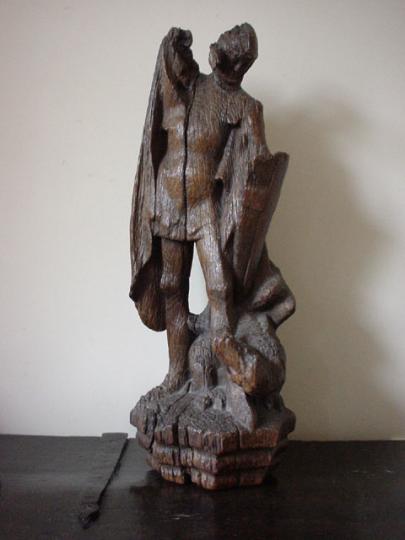
Whilst two-dimensional images of Saint George slaying the Dragon are almost commonplace, an English medieval image in the round is a different matter.
The manner in which this 26" high oak figure is made shows that he was positioned in the true upper right register of the archivolt of a doorway.
The story of Saint George is handed down from third century Rome. It was not however until the late medieval period that he began to be depicted as in this composition as the Patron Saint of England slaying a dragon.
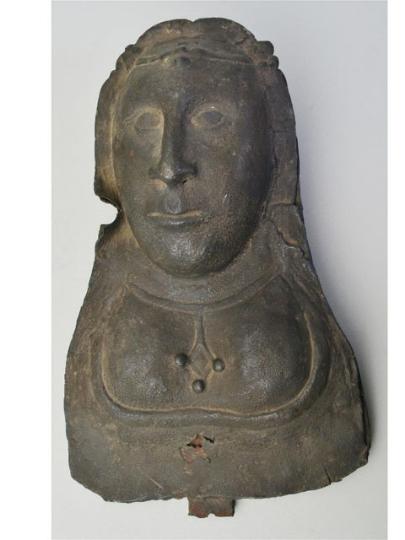
This is an iron, fifteenth century bifacial Maryan Guild processional image or sign which will, as indicated by the mounting tab, have been carried on a staff in procession or ( much more probably in view of the bullet hole complete with burning ) have been displayed as a sign outside a Guild Hall. The appearance suggests having been treated with a tarry preservative material which has now resulted in a compacted, very stable patinated surface.
It is known with certainty to have formerly been in the ownership ( collection of? ) Matthew Boulton ( 1728-1809 ) : the renowned metalworking industrialist and business partner of James Watt.
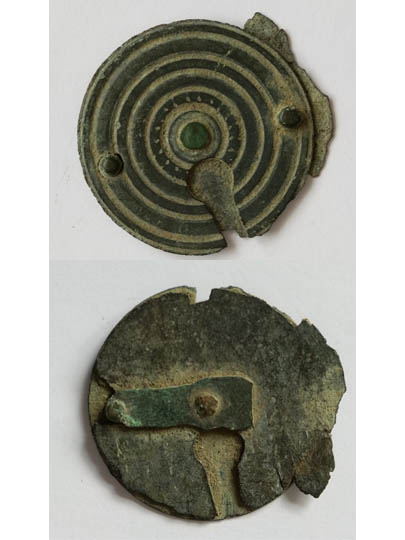
A fixed or portable sundial, of ancient origin, can be used to display the time of day by reference to the Sun. The essentially portable Nocturnal, when deployed in the northern hemisphere, enables determination, within a quarter of an hour, of the time of night : by sighting of the North Star and its positioning relative to other celestial bodies.
Made from fine copper alloy plate and approximately 1 1/4" x 1/8" this near-complete Nocturnal was recovered during a 'Detectorist's Rally' held close to Doncaster and is similar to the seven such recorded on the British Museum-managed Portable Antiquities Scheme database. Whilst there may well be others known, unlike as with sundials few appear to have survived. This tends to confirm that few were made during the medieval period as the earliest records of their existence are from only shortly before the Reformation.
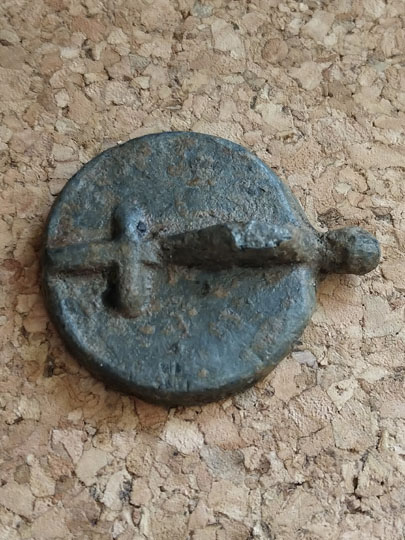
More easily recognised and understood than the Nocturnal on the previous page, the Sundial is clearly portable at its diameter of only 1 1/8" when excluding the 1/4" handle. Made from a small cast billet of lead, it has been wrought : except for the plain, flat back that utilised one unmodified face thereof.
Undamaged and in complete working order, it had limited functionality in enabling determination only of the canonical time of sext at midday.
There were monasteries close to Wentbridge in West Yorkshire from where the Sundial was excavated but, whilst its design confirms its monastic origin, it is not possible to determine the monastery from which its owner came.
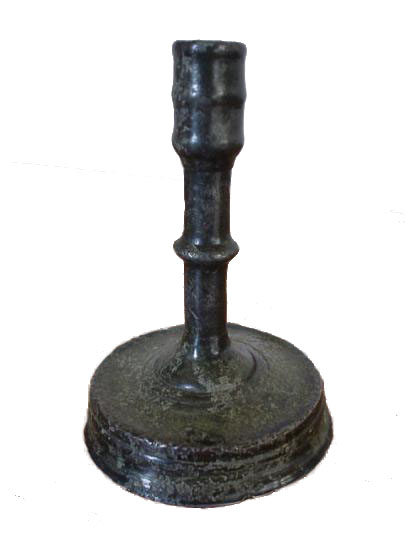
Writing in the 1950's, Mackay Thomas first used the rather well coined phrase 'first stabilised English form' in order to codify this form of candlestick which we colloquially call the 'bunsen burner'.
At first sight there appear to be quite a few of these extant but, on eliminating both the vaguely similar French sticks and later reproductions and fakes, there really aren't many to be seen. Of those, all but four are made of copper alloy and there is one such in the Collection. The four which are not made of copper alloy are each made of tin alloy ( pewter ) : one in the Museum of London, the second with Stirling Castle Museum and two including this one in private collections.
With a height of 4.6" and diameter of 3", it is not only rare as a candlestick but also as a piece of English medieval pewter of any type.
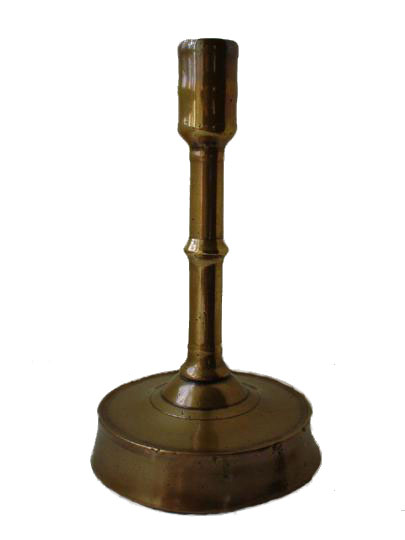
As in the preceding page, this also is a bunsen burner type candlestick but made, more usually, of copper alloy ( bronze ). It is interesting to note that many fragments of stems and sockets of this type are available on the market which enable comparison with the relatively few surviving complete sticks. For reason(s ) difficult to deduce however, almost no bases of this type are found in isolation by archaeological investigation.
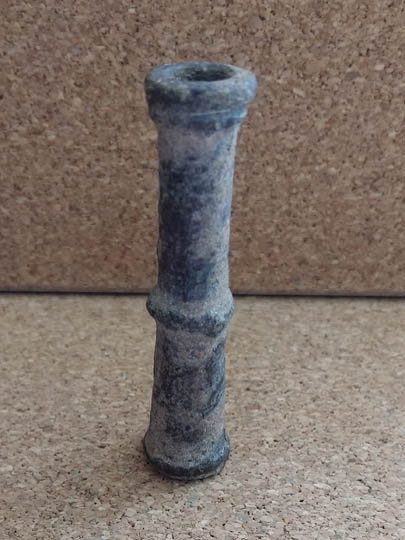
Despite the observation made on the previous page as to the relatively plentiful survival of Bunsen Burner type candlestick stems, apparently only two extant are in pewter : this being one of them. Whilst notable for reason of scarcity, this also is materially smaller at 2 1/8 x 1/2" (maximum) than other Bunsen Burner candlestick stems : showing the complete candlestick from which it originated also apparently to have been incomparably small.
Not only are Bunsen Burners considered to be specifically from England but, from the medieval period, manufacture from pewter and the absence of an aperture in the socket also is confirmatory of such origin. Perhaps academically controversial, upon handling aspects of its making strongly suggest that it dates from the Anglo-Saxon period.This should not be unexpected, as the general form can be seen not least in a surviving sixth century Norse wooden candlestick.
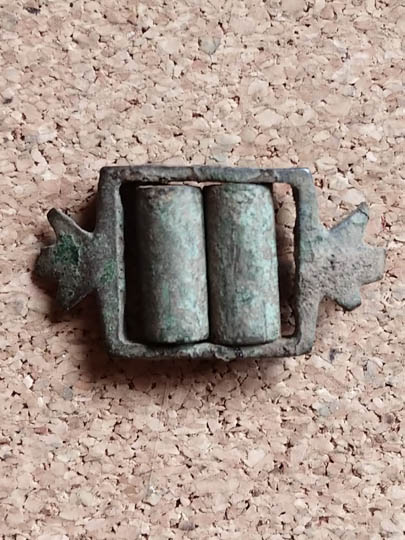
This was used to make wicks from the pith of rushes that then were enrobed in wax to make 'rush candles'. These are not to be confused with fast-burning 'rushlights' that were made from long rushes dipped into fat from cooking. Rushes used for making rushlights were dried and peeled of most of their outer stem : the pith and remaining supporting stem then being dipped into fat. When making wicks for rush candles, however, all of the outer stem was removed and a short section of pith fed between the rollers in order to consolidate/flatten it prior to enrobing with wax.
Made of copper alloy and measuring 1 1/8 x 5/8", it is in complete good order except that one roller now is not held securely in place.
In even the most modest of homes the production of rushlights will have been an extensive and lengthy routine family task. By contrast, the Wick Maker's small size and impracticability of use indicate that it will have been used briefly and infrequently for the making of rush candles. Whether this was a traditional form of tool is unknown : but perhaps is unlikely as no other examples appear to be recorded. This might be explained either by rush candles not being favoured or that devices as small as this one have gone unfound/unrecognised.
Acquired from the detectorist finder (who is to be commended for its safe finding/keeping complete with the 'loose' roller), this was recovered from West Bridgford, Nottinghamshire in October, 2019.
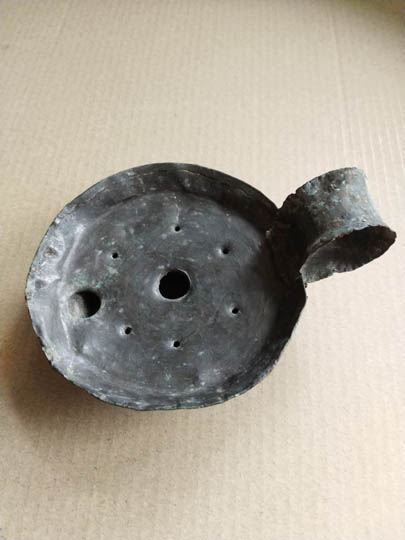
Different types of lantern, variously for use inside and outside, with their inherent protection against being extinguished by draughts or wind, were commonplace in the Medieval Period. This has not been reflected however in the survival of apparently only seven (including a Roman one) additional to this example : each being fragmentary and six of which are retained within museum collections. As a result of this dearth, knowledge of lanterns is derived mainly from extensive period depiction of them.
This example comprised two discrete elements : the base that is in complete, original good order, and the dome, now lost, that also was a complete entity. The base will, on occasion, have been used without the dome and, at other times, with that fitted into place by insertion of its six feet into the hexagonally positioned small apertures in the base. The aperture outside the footprint of the dome, of similar size to that which held the candle centrally, will have held either a lit candle used to light other candles, or one unlit kept in reserve for use within the Lantern.
The 3 1/2" diameter base (excluding the handle) has been fabricated in an apparently simple but actually highly workmanlike manner from three flat pieces of tin-rich pewter. If the cover had been designed to fit into or onto the base in any other way, that its six feet were each extensions of stanchions into which were slotted finely-shaved horn windows might not have gone unrecognised. However achieved within the design of the dome, whether or not by use of a lid, apertures enabled ventilation : and hence combustion. The handle was formed by bending a 3/4" wide strip of tin and upturning its sides to fit with finger and thumb. At its lower end the strip finishes in a tightly rolled hollow tube spanning the width of the handle and 1/8" in diameter. This held a taper (probably a short length of wick) that when lit possibly was used to enable passing of flame between the Lantern's 'external' candle and other candles. An original piece of this lighting material, clearly delineated from the tube, has solidified to remain evidentially in place.
The form of the Lantern in part bears comparison with that of one of the other extant seven : the impressively well conserved example in wood from the wreck of the Elizabethan vessel Mary Rose.
No more is known of the provenance than that the Lantern came from an English collection formed during the 1980's.
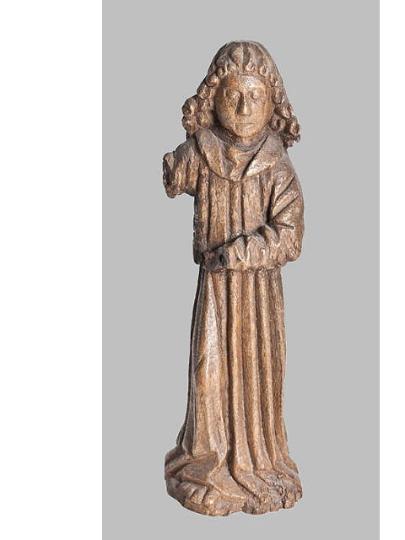
Of a traditional form, albeit infrequently found when English, the 17" high oak candle-bearing angel is from Devon. Fortunately, the dignity of the figure is undiminished by the absence of the long-gone candlestick : formerly held as though being presented.
There is an interesting matter to note concerning his present condition. Whilst a small amount of wax has been applied to the front ( prior to joining the Collection ), the back has been left unpolished. It could be said that this has enabled co-residence of idealism and pragmatism.
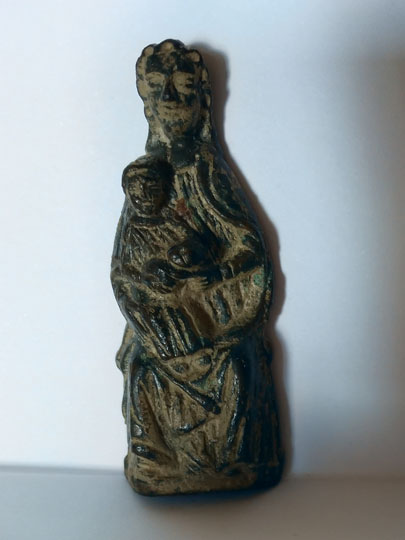
Respecting that they were devotional objects of significance to individuals and communities, it cannot be missed that the market has been awash in recent years with large, crude, often late-dated, repeatedly over-painted Continental wooden figures of Mary. This does not apply to all. Memory of a beautiful, large, 15th century Nottingham alabaster of Mary from fifteen years ago, and another Romanesque French Mary in oak, approximately contemporary with King Stephen on this Homepage, offered recently in Paris, provide reassuring exceptions.
Being late Romanesque circa 1300, made of copper alloy, hollow-backed and measuring 21/2"x1", this 'group' is far removed from such Continental examples. It is highly detailed with, for instance, each of the four hands and the (presumed) pomegranate being held by Christ the subject of considerable care in making.
By reason of size, it clearly is a personal, devotional object : or is it? The contemporary, extensive deposit of a 'concreted substance' attached to the back has it appearing to have been attached to some solid structure of stone or metal. During a number of different periods, to have been known to own such an image in England would have invited virulent opprobrium at the least.
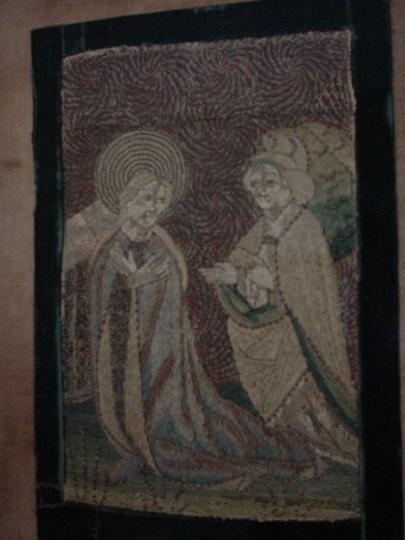
Apparently in the majestic Athelhampton House, Dorset until 1957, the subject of this late medieval needlework is that of the Angel Gabriel visiting Elizabeth to tell of the impending birth of her son John the Baptist.
What a contrast between this positive image and the many surviving gruesome depictions in both two and three-dimensional form of the head of John lying on a plate : by which this alone Herod's daughter Salome seems to be remembered.
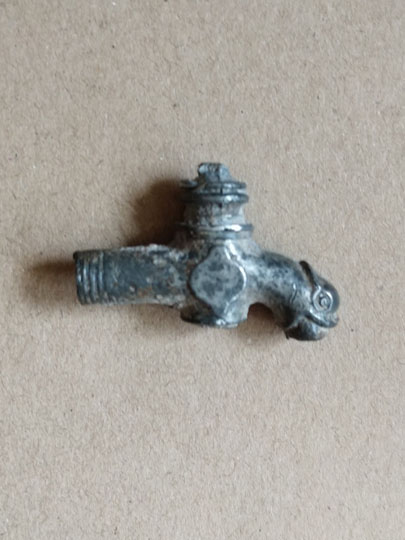
Aquamanilia held water for the washing of hands : initially in ecclesiastical environments and later, more broadly, within wealthy society. Typically zoomorphic, but occasionally anthropomorphic, they were of such visual appeal and sufficiently durable that examples have survived in large numbers. As can be seen in the collections of a number of major museums, almost all are Continental and lack the aesthetic appeal of the 12th century English example in the British Museum. Many aquamanilia were lifted in order to pour water from the spout, but some were left standing : water being accessed from a tap protruding from the chest. Most probably, provision of such tap was in response to the effect upon the size and weight of the vessel at a larger capacity. Typically made of copper alloy and later, often highly attractively, of ceramic, it is known from period references that also some examples were made of silver, but none are known to have survived.
Recovered during the 1950s from Street End, Canterbury, and measuring 1 1/8" x 3/4", the Tap appears to be a sole English survivor : not just in silver, but in any material.
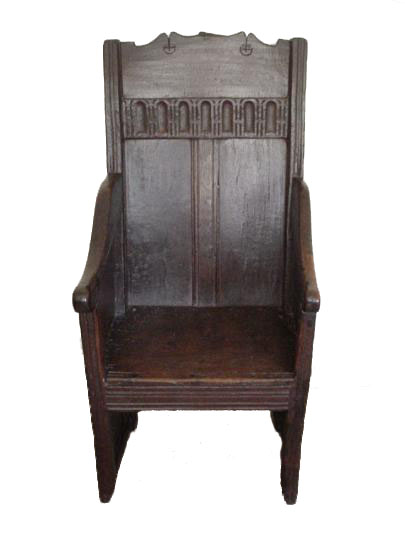
Increased wealth of a part of seventeenth century English society gave rise to ownership of much oak furniture of the day and this is still evidenced by the many extant exuberantly-decorated armed chairs. Earlier pre-Elizabethan chairs are both plainer and materially rarer and pre-Reformation chairs such as this are next to non-existent.
Unlike the other early chair from the Collection shown on a different page which required detailed description to enable understanding, this chair speaks for itself : excepting perhaps inviting just one question. Is its distinctive form designed for comfort or as a means of displaying the sitter? Whilst not uncomfortable, experience of it would favour the latter : not an unimportant matter to the furniture historian.
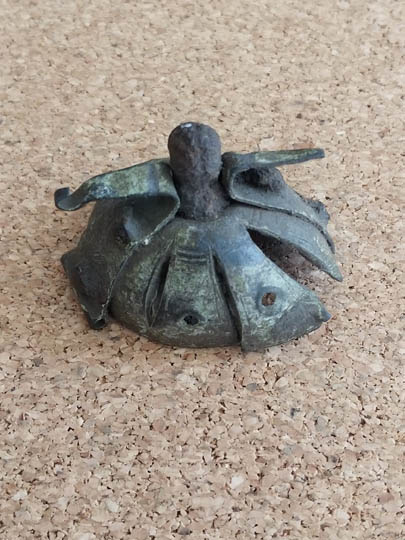
Horse Racing is today recognised as the 'Sport of Kings' but before and during the medieval period, Falconry held that position. Whilst disquiet may be felt at the wildlife implications, Falconry is rooted in the relationship between man and bird.
When not flying but prepared for such, the (say) Falcon is kept calm by having a hood placed over her head : the design of which is tailored for comfort and to enable easy placement and removal.
Hoods have traditionally been made of leather, and one of the two medieval examples in the collection of London's V&A Museum can be seen online to be made of leather which (reportedly) is very stiff : although unlikely so when made. By contrast, however, this (formerly) leather-lined, copper alloy, Helmeted Hood will always have been so and, whilst probably being made with care to fit precisely, will inevitably have accepted the compromises of display above comfort. The owner of the wearer clearly will have wished the apparel of his bird to match that of himself.
Measuring 1 3/8" x 7/8" x 1" and weighing one quarter of an ounce, the Hood was found in deep silt in 1976 (a year of extreme drought in England) at Stamford Bridge, Yorkshire (location of the battle in 1066 between King Harold of England and King Harald of Norway, days before Harold was defeated in Hastings by William the Conqueror). The late finder was a long-experienced dealer/collector of antiquities from whose extensive collection also has come one of the two Anglo-Saxon Page Markers in this Collection. An item dating from the eleventh century, as this has been seen to be, could be Anglo-Saxon, Viking or Norman but, based upon design, a cultural source has been nominated : albeit potentially open to revision.
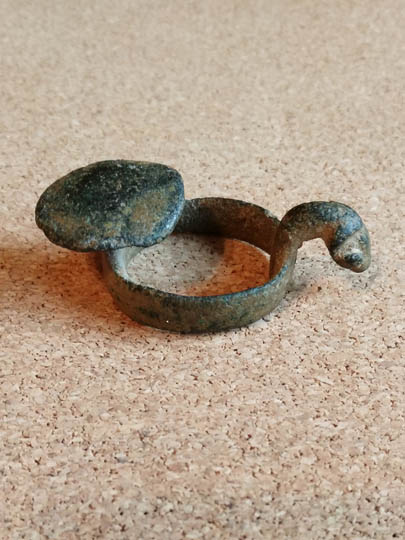
When tethered inside, falcons stood on perches within a 'mews' : when outside, they were attached to a gauntleted hand or standing on a temporary perch. One form, an example of which is shown in a period depiction, was a small, round table top with a pole through its centre that formed both a leg and (above the top) a tethering post. When perching on the table top, the Falcon was tethered by connecting the short, thin, light leather straps (jesses) around her legs to the post or to a leash attached to the table leg or post. In either position, a ring of this type enabled a jess or leash to be wound around the ring's capstan : so tethering the Falcon with a greater or lesser degree of freedom to move as chosen by the falconer. When the ring was placed around the leg prior to it being inserted into the ground, by being constrained by the top and the ground the Falcon could not dislodge it. When however the ring was placed around the post, the intrusive positioning of the capstan on the ring rendered impracticable the raising and removal of it other than by accurate, vertical lifting.
Unlike any of the other few recorded tethering rings, this one is figurative and represents a serpent with the head of a ram : as depicted on other high-status artefacts in association with the figure of the Celtic God Cernunnos. The most notable example of this is shown around one of the greatest Celtic treasures : the Gundestrup Cauldron, that now is in the British Museum.
The traditional grouping together of the few rings of this type with the many strap-junction 'baldric rings' is, at best, uninformative. Whilst of elegant design and making, this method of tethering appears not to have been favoured with longevity : being only from the Celtic Period. Its demise might have resulted from conception of the so-called 'falconer's knot' : that could be tied with one hand.

Interest in determining the earliest date of Falconry in Britain led to theses on the subject : discovery/identification of related items such as this adding incrementally to that knowledge and record.
The Silver Vervel measures 1 x 1/2 x 1/4" and prioritises not burdening the bird in flight above durability : by it weighing only one eighth of an ounce. Used by a professional trainer, the Vervel was attached to a young bird by a fine cord around the leg that passed through the lower loop. A similarly fine leash was threaded through the loop at the top : so enabling restraint. Each bird was identified by the specific 'ring and dot' format on the shield. The seeming incongruity of the loops being offset from a central position enabled unencumbered close attachment to the leg. Following removal of the temporary Vervel just prior to later ownership, its functions were then met by the permanent fixing of a leg-encircling, owner-identifying Vervel Ring, and by the use of anklets around the legs for attachment of leather restraining Jesses. Whether this form of vervel typically was used during the early stages of training a bird during the Anglo-Saxon period might be determinable from the possible finding of other like examples or, less likely, from identifiable manuscript depictions of such.
During the period (and later), falconry was engaged in by those of high status and therefore became a well-resourced, high-value business. Experienced training of birds led to them being ascribed considerable monetary value. Distasteful though Falconry might be to some, its fostering of the relationship between bird and carer perhaps has merit in its own right.

This was found during the 1980s in Low Moor : some three-quarters of a mile from the dynastic de Lacy Family's Clitheroe Castle.
When attached to the leg of a falcon, the Vervel enabled both identification of the bird's owner and constraint of the bird : by placing the slot in a leather jess over and around the finial.
Cast and wrought from silver, the 1 1/8 x 1/2" Vervel is enamelled throughout in purple upon which is applied a lion rampant in gold : 'gold on purple' being a reversal of the 'purple on gold' of the traditional de Lacy Coat of Arms. Except for loss of part of the strap retainer on the back, partial loss of gold from the front, and the spurious green accretion, it is in good order.
The finial is formed as an image of the head of a dog. Interesting to note is the extent to which one side has been abraded by chafing of the attached jess.
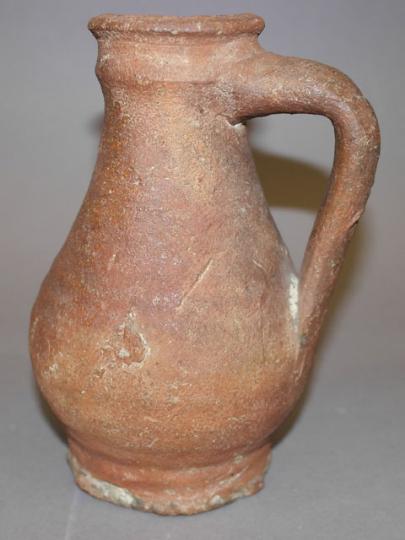
Seven inches high and dating from the 14th/15th century, the ceramic jug is notable by reason of aesthetic appeal, condition and provenance. It's attendant paper label shows it to have been a part of the stock or collection of the now deceased authority Jonathan Horne. That label, with it's reference number and price, said ' 14th-15th. century Witham Essex '. In more recent times, the label which had become detached, was placed within the jug. On seeing the jug and wishing to see the label, a visiting authority on his subject ( not ceramics ), gently shook the inverted pot in order to extract the label. Two labels fell out : the second being made of linen and filthy. In spidery inked writing it says ' Jug. found in digging Cellar. High Street Witham 1820 '. The finding of the label was nearly as exciting as the original acquisition of the jug.
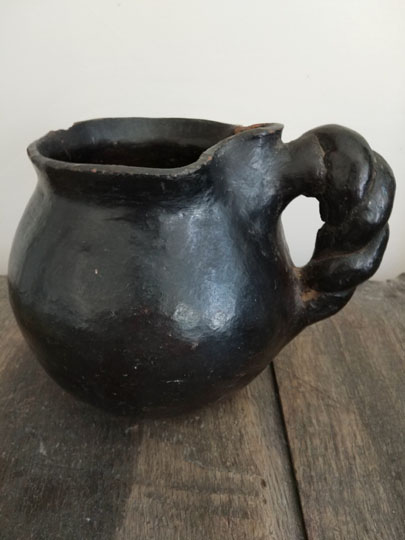
5 1/2" in height and 7 3/4" in maximum width, the Vessel is unrestored and undamaged, except for minor chips in the rim. The depression in the rim adjacent to the top of the handle is a thumb hold that, with the second forefinger around the handle, enables lifting and tilting to drink from the lips to both left and right of the handle respectively, by left- and right-handed users.
Whilst undoubtedly made for communal use, the Vessel would not have withstood other than careful handling. This therefore would preclude 'on-demand' use by the public : say when in a tavern.
Excavated from Warwick in the 1940's, when private domestic use is precluded, there seem to be few environments and locations from which the Vessel might have originated. Its lowly status probably excludes buildings such as Warwick Castle : or even typical manor houses. To suggest likely sources in Warwick from which such a distinctive vessel for use by a small confraternity might have originated would not be difficult : but would be unacceptably speculative if unprovenanced.

The Mute Swan is mysterious and beautiful, creating in its graceful passage an aura of serenity and calm : unless and until it is annoyed. Now held in unwavering regard, it is interesting to know the reasons why that was so also in the medieval period.
Following two complete vessels in preceding pages, a handle alone apparently makes for poor company : until the status of medieval swans and those associated with them is taken into account. The handle is made of tin alloy and measures 21/4" in length with a maximum width of 3/4". The attachment end is hollow for less than 1/2" and therefore dispels any though of it being a spout. The jug/cruet of which it was the handle clearly will have only been small in size and capacity.
There was rigorous control of ownership and keeping of Mute Swans both during and following the medieval period. This emanated from the Kings of the day who dictated which few organisations and wealthy aristocrats were granted permission to own Swans. This regime was controlled by expensive licensing and formal marking of each Swan. Strictly enforced law dictated the conduct of those not allowed to own Swans even down to not allowing their removal from land being occupied and grazed by them. All of this will have added to the mystique, aura and status of the Swan and, even nowadays, it is thought ( albeit incorrectly ) that they are all owned by the Monarch. The present-day ceremony of 'Swan-upping' involving the capture, marking and release of Swans in the ownership of the Crown and specific livery companies is in continuance of practise from the medieval period.
Whilst there are both livery and other badges depicting Swans, there seem to be very few medieval examples of them in three-dimensional form. This may have resulted from their near-sacrosanct status. Conversely, those with such objects in their ownership may thereby have displayed their standing in Society based upon their involvement in any capacity with Swans.
Whilst not conveyed to good effect by the picture, the shaping of the handle would readily enable pouring to the left rather than tilting backwards, when held between the right thumb and index finger : indicating that the handle was more likely attached to a jug/cruet rather than to a drinking vessel. Such a small vessel would likely have been an ecclesiastical cruet were it not for the zoomorphic design of the handle. Realistically however, the circumstance of its use is a moot point : retaining all the mystery of a Mute Swan.
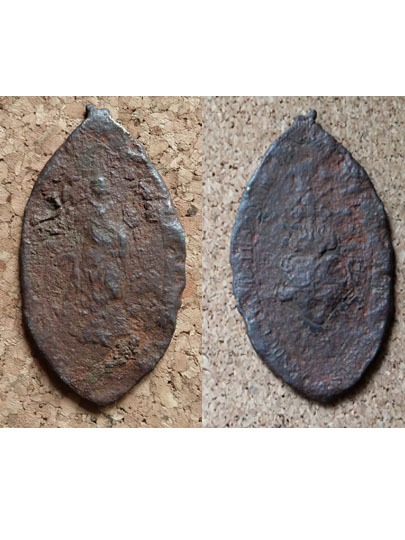
So different to the remote, isolated locations of many major English monasteries, St. Mary's Abbey was established in central York by the Benedictine monastic Order. Dedicated to Saint Olaf of Norway on its foundation in 1055, it was re-dedicated to the Virgin Mary in 1088.
Two and a quarter inches high and made of copper alloy formerly gilded, the Pendant was excavated in the 1950's during a formal archaeological investigation of the gardens adjacent to the remains of the Abbey Church : themselves the site of other elements of the monastic complex.
The obverse depicts a full length image of Saint Olaf : the Viking King sanctified in recognition of his role in the spread of Christianity. Olaf died in battle in 1030, and his faithful witness inspired dedication of the Abbey in what was the capital of Viking-controlled England : the Danegeld. Some aspects of the detail remaining have enabled correlation with extant period statues and pictures of Olaf. Note that, whilst adjacent to slight damage, there remains an identifiable Cross to his right. Also, at his feet, is a swan leading him in the manner of a 'Knight of the Swan'.
On the reverse is depicted the 'Sacred Heart of Jesus': the iconographic form of which was first introduced into Cistercian and Benedictine monasteries by returnees from the Crusades. Above the Heart is the Crown of Thorns from which flames are engulfing a Latin Cross : thereby conveying Christ's sacrifice, divinity and love of mankind. By the Cross being consumed by flames and materially smaller than the Heart, in contrast to the relative size of Christ and the Cross as typically depicted in the Crucifixion, Christ's love is shown to have conquered all.
Clearly a devotional Pendant for wearing, whilst only a part of the attachment loop remains, it otherwise is almost undamaged and in uncleaned, stable, long-lasting condition.

Found at the same time in the 1950's as the Pendant on the previous page, this is a complete hand Tool made of copper alloy, measuring 1 3/4" x 5/8", with traces of green, red, and black ink/paint and in original good order. It was used by monks in order to compress parchment when folded to form bifolia : that thence were bound into books. Also, to finely dress those parchment pages, when necessary, prior to or during writing. Whilst the Parchmenter will have selected, stretched, dried and dressed skins for use as manuscript pages, monks engaged in their use will inevitably have found the need to engage in further, limited preparation. Whether or not by use of very finely-grained materials, blemishes will have been filled and smoothed into a state acceptable for use. It is interesting to note that stones thought to have been used for the purpose have been found in an English monastic site : although the finding of a tool such as this perhaps suggests that those stones were used only in the early stages of skin preparation.
The ease with which the thumb and forefinger fit aside the curves between stem and smoothing plate enables the application of controlled, highly effective pressure to compress thick pages along their folds. When used to dress pages with smoothing substances, this has the feel of a delicate trowel capable of accurately careful use.
Addendum
A second Parchment Tool, of identical design but approximately half as large again, has been acquired from the finder : it having been recovered from adjacent to the former-Roman Fosse Way, Cotgrave, Nottinghamshire. Providing yet further evidence of the nature of its use, this also, in good original condition, has identical spots of red, green and black paint remaining on its surface.
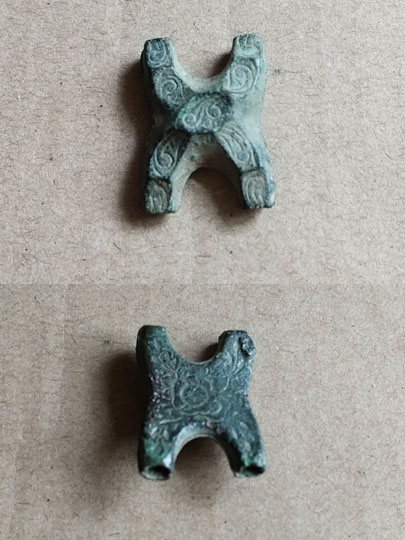
Sliders were used during the activity of copying manuscripts by hand : this being the only means of replicating written material during the medieval period. How widespread was their use is a matter of conjecture.
Recovered with the items on the two previous pages, the Slider, finely made of tin alloy, measures 3/4" x 1/2" x 3/8" and is in complete, good order. Threaded by two tactile cords and laid down the central fold of a book that was being copied, it was slid, by use of the two finger-holds, down (and sometimes up) the cords in order to denote the line then being copied. Evidence of the efficacy of using a slider can be seen in the occurrence of inadvertent repetition of lines in some extant manuscripts. Whilst the back is decorated with a rose that references the Virgin Mary, and hence this owning Monastery, the front reflects typical Anglo-Saxon humour by depicting drops of ink.
Whilst other sliders appear not to have survived, one that is functionally similar but different in design is depicted at the top and in the centre of a page in an extant manuscript. The correlation between the design and function of this Slider is so confirmatory of use that, whilst that manuscript is interesting to see, no reference to another slider is needed to support attribution of this one.
Once again, here is a fractional part of the academic legacy of the archaeologist, the late Gordon Hardcastle.
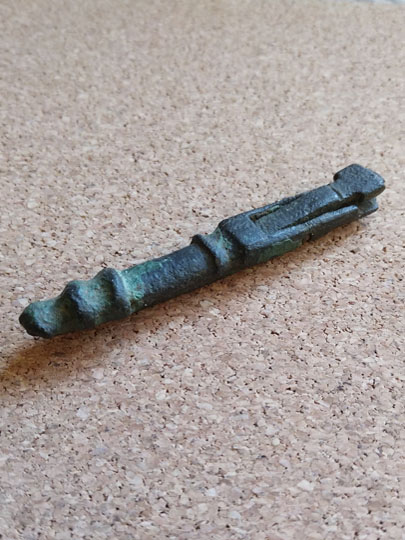
Most modern coinage has effectively no intrinsic value, but that was not so during the medieval period. The predominant English coin was the silver penny : the standard weight of which was uniform during long periods of time but changed at certain, known dates. Being made of silver, pennies were ripe for 'clipping', and someone receiving payment had good cause to ascertain that they were of full, standard weight.
To gauge the weight of objects larger than, say, pennies will have been undertaken by use of a scale with separate weights of specific, different values. Being small, light and of specific, standard weight, pennies enabled development, making and use of a portable device specifically and solely for weighing them : that device was the Tumbrel.
Found in Lancashire, made of copper alloy and measuring 2 1/2"x 3/8" x 1/4", this is one of quite a few survivors from the period. It is, however, notable by reason of its completeness, original condition, fine surface decoration and overall making in the form of a hound. The Tumbrel was opened in 'scissor-like' fashion and held so that the balance arm was horizontal. The coin was placed on the plate at one end of the arm and, because the opposite end of that arm was made of the appropriate, specific weight, the coin would either remain on or 'fall' from the plate. Only if falling would the penny have been determined to be of acceptable weight.
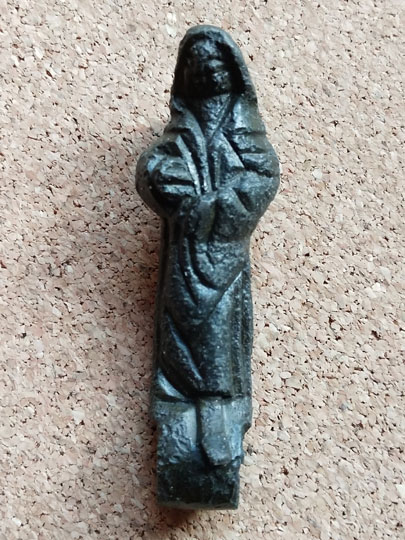
Despite 'dress accessories' not being acquired for the Collection, an exception was made for this monastic item of known provenance.
Many purse bars have survived : now devoid of the fabric bag which encased them. By contrast, the means by which they were suspended from belts either have not survived in numbers or have gone unrecognised as to their identity.
This Monastic Purse Hanger is made of copper alloy, in complete good order and measures 2 1/4" in length and 3/4" maximum in width. Found in Lewknor, Oxfordshire, the location of the Benedictine Abingdon Abbey, it is probable that this was the personal possession of a 12th or 13th century monk. The attachment clip that slotted down the height of his belt is almost as long as the figure itself but appears not to have saved its loss following detachment. One unusual feature of the figure to note is the one, large foot : crudely and plainly made, it appears to have been without the accompanying right foot since being made. This bare foot may have been modelled in order to evidence ascetic penitence : despite its use to suspend a purse.
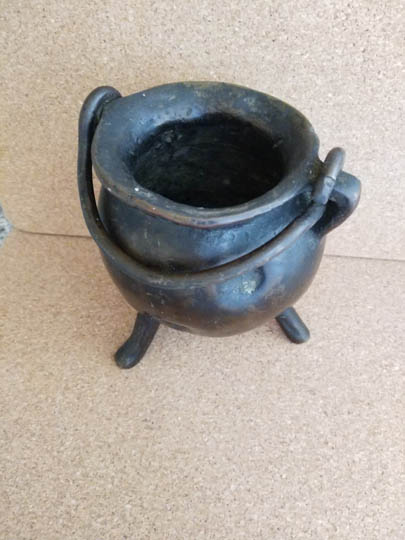
The copper-alloy Lamp measures 3 3/4 x 3 1/2" excluding handle, has an aperture of 1 3/4" and weighs 2 lbs. 4 ozs. Aspects of its design, condition, and provenance enable certain attribution of its function and probable attribution of its original source. Although external surfaces evidence little exposure to heat, the inside is heavily encrusted with heat-bonded material. Following being filled with shards of cold, hard beeswax, it was suspended over boiling water to induce melting and consolidated filling of the cavity, including the lip. With red colourant stirred into the molten wax, and a wick inserted into that, it was left to cool and set. Deposits of ancient colouring remain : integrated with, and on the surface of, the remaining wax within. It is noted that, although probably here not applicable, particles of silver can, following contact with acids (e.g. from the ground), produce traces that are coloured red. Its tripod form and very heavy construction strongly suggest that originally it was used within a rugged environment : not that of a genteel, protective building. Neither of these characteristics would have been needed it it had been displayed on the flat top of an Altar or piece of furniture.
The Lamp was recovered circa 2000 from the ground within 100 yards from the now disused Chapel of Sainte Antoine de Froidemont that was established in the small village of Plancher-les-Mines : the location of the most prolific silver mine in the former French Empire. Sainte Antoine, Patron Saint of Miners, was a 9th/10th century monk from the Benedictine Abbey of Luxeuil who, in his later years, moved to a hermitage cave in the large forest 2 1/2 miles from Plancher-les-Mines. Both that forest, hermitage, local waterfalls, and the Chapel bear his name. Recognising the ecclesiastical nature of the Lamp, that it postdates Antoine's hermitage and that it lengthily predates the original 1745 village Church, its 1868 successor, and the Saint's Chapel of 1866, to attribute it to have been in a typically French Shrine to Antoine within or adjacent to the silver mine that was (and is) close to the village, is not without foundation or justification. As found so close to the Chapel, it seems probable that this had been used and/or displayed therein following transfer from the mine but subsequently buried in haste to ensure its safety from anti-Catholic attack. Ownership and control of this area of France moved more than once between France and Germany during the period post-1866. As a result, virulent German anti-Catholic sentiment was, for a period, enshrined in law, and such a Lamp would have been a prime target for despoilation. Burial for safe-keeping, subsequent finding, and now identification, have defeated the iconoclasts.
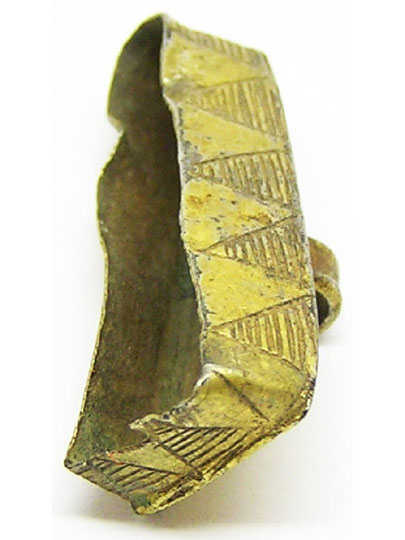
Throughout most of the medieval period, men displayed their affinity to people or organisations by the wearing of a Collar made of precious metals. In effect, a medieval Collar can be equated to a current-day necklace : albeit on a very large and grand scale. From the Collar typically was suspended, in a central position, one decorative item which further reinforced the wearer's affinity. Collars also can be well visualised as period equivalents of Chains of Office. Well remembered is travelling on Concorde from London to Berlin in the only small party which could be carried in such splendour : being led by the Lord Mayor of London ( holder of the twelfth century office and not that of the Mayor of London which is a recent foundation for administrative management ). He was wearing 'The Jewel' suspended from a fabric collar around his neck : this being the 'everyday' insignia worn in representation of the full Chain of Office. The Jewel corresponds to those of various forms suspended from medieval Collars as described. Of course, the Niche is very modest by comparison and it is admitted that schooling at the time was required in order to learn of the Mayor's apparel : this coming from a brave former MP ( with an even braver wife ) who deserves to be held in high national esteem.
Made of gilded silver, this is in the form of a niche with a looped attachment on the back enabling recognition of its means of suspension from the Collar. Fortunately still in unrestored good condition, it measures 11/4x1/2x1/4". Obvious however, is the absence of the figure which will have been reverently presented within it : most probably of Mary. This is a mixed blessing for, if the ivory figure had still been present, it would not have been acquired for the Collection by reason of love of and respect for the Elephant.
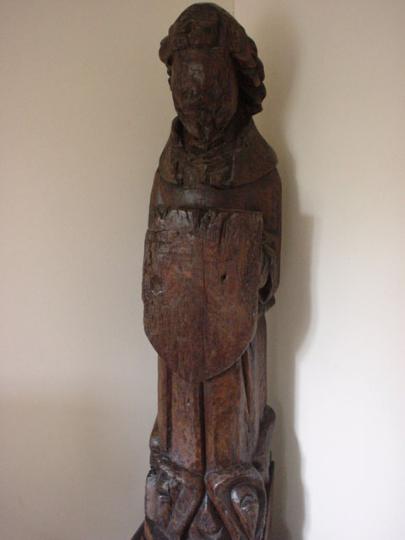
Such angels were ( and still are ) positioned vertically or at 45 degrees within the roofs of ecclesiastical buildings. This fifteenth century oak carving is 3' high and has, presumably at the Reformation, been subjected to what can most accurately be described as a sustained attack with an axe. We can only despair at the anarchistic ideology which resulted in defacement and desecration of such a figure of humility. Sad to say, the angel provides a more effective historical record than would be the case if free of such treatment. In present hands, it also is considered more empathetic than if it had been left in peace : comfortingly so.

There are a good number of surviving fragments of this type of English fifteenth century copper alloy folding candlestick. However it is not surprising, considering the fragility of the design and manufacture, that there are very few which are as complete as this one. An example of such is in the Museum of London.
The stick could be inserted vertically or horizontally into an aperture : in either position, being secured by the locking mechanism. When not in use, it could be folded as though a pair of scissors such that both the socket and spike were adjacent and pointing in the same direction.
It is notable that this is one of very few different types of English medieval candlestick extant.
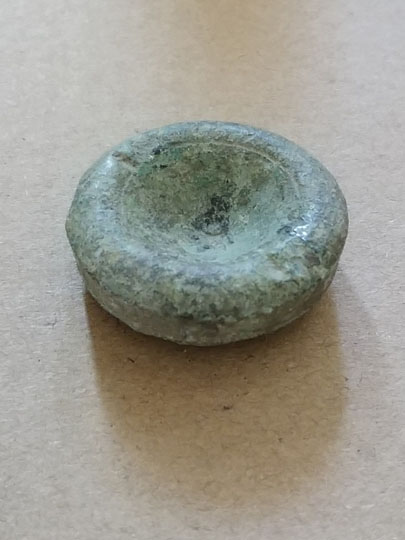
Whilst apparently a simple, minimalist means of positioning a candle for use in lighting, the attention to detail in the design and making of the Stand reveal it to be anything but modest. It was found in 1975/6 by a professional archaeologist working in Newton Kyme, Tadcaster, North Yorkshire : the site of a major Roman Fort subsequently occupied by Anglo-Saxons.
Measuring 1 1/8" x 3/8" and weighing an extraordinarily heavy 1 1/8 ounces, it is turned and carved from extremely dense Tadcaster limestone : as used in the Minster and City Walls of nearby York. With a flat bottom, vertical and chamfered sides, and incised, dished top with rolled edges, it clearly was produced by a skilled mason.
Following lighting a candle stub positioned on the Stand, hot wax would have been dripped into the dish, and the candle re-positioned thereon to ensure stability. Beyond all reasonable, optimistic expectation, and despite previous unawareness both of this and of the functional identity of the Stand, period wax deposits remain in the bowl.
Whilst a simpler form of lighting (other than firelight) could hardly have been conceived, the care taken in its conception and making is indicative of its significance to the owner : and of the Anglo-Saxons' approach to making mundane objects.
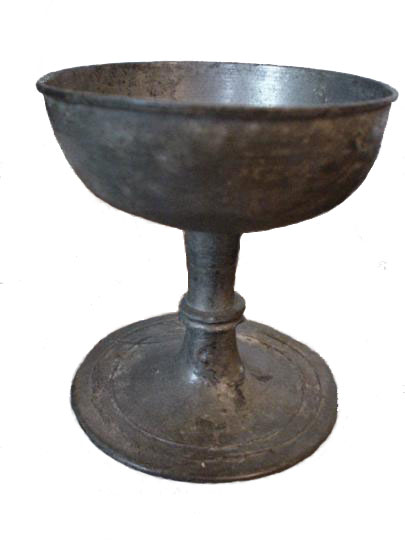
Irrespective of intrinsic value, the most prized possession of a monastic or other ecclesiastical community was the chalice : it being central to the celebration of the Mass. With the exception when license was granted to specific institutions in times of exceptional penury, medieval church law forbade use of vessels made of non-precious metals in such Celebration. This thirteenth century chalice is made of tin alloy : that is to say pewter. With some notable exceptions in respect of senior members of the Priesthood, the practice of burying a representative chalice and paten with a priest was satisfied with vessels made of pewter and not of precious metals. Most fortunately, this chalice was found in 1908 at Stoneleigh Abbey, Warwickshire during the construction of a croquet lawn.
For reason both that it is a chalice and that it is probably the only funerary item in the Collection, it receives all due care and respect : objects are infused with their history.
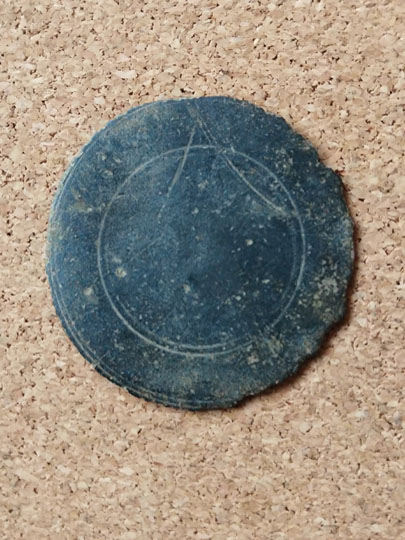
Chalices and Patens buried with priests other than of high status were piously simple in design and making : being representative of but clearly identifiable as to function. Predominantly by having been excavated from ecclesiastical environments, chalices have survived in sizeable numbers : but seemingly inexplicably, patens materially less so.
This Paten is notable not just for its survival but for its design and manner of making. With a diameter of 1 5/8" and made of tin alloy, so untypically nominal is its design it merely alludes to being bowl-shaped by the incising of the upper surface : being scored both to delineate the booge and around the rim.
Emblematic of the many thousands of objects excavated and collected by the archaeologist Gordon Hardcastle, the Paten was recovered in May, 1975 from the field immediately behind All Hallows Church in Sutton-on-the-Forest, North Yorkshire. The Church was rebuilt in 1876 incorporating elements from its early fifteenth century predecessor, on the site of its yet earlier predecessor that dated from 1185 at the latest. There then being effective ownership of the Church by nearby Marton Priory, that uniquely was a double-house of Augustinian Canons and Benedictine Nuns, it is likely that the Paten was buried with a Canon from Marton : each Canon being a priest and therefore buried with Chalice and Paten.
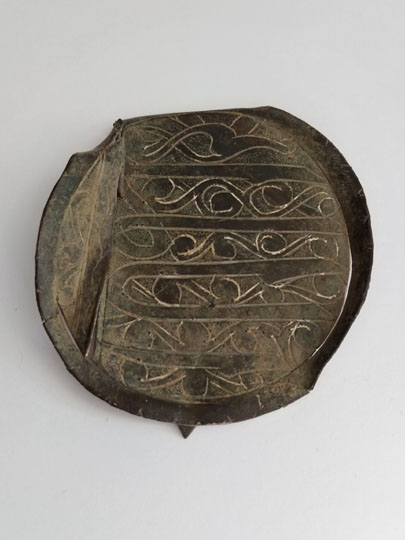
Unlike the Paten on the previous page, this one was intended for use and not for burial with a priest. The Pyx of which it was the Lid contained the Reserved Host for celebration of Mass with those in distress and the Lid also served as a Paten upon which to place the Host during that Mass.
Made of a roundel of thin tin alloy with a diameter of 2 1/16", the outer 1/16" was trimmed to leave only the small V-shaped handle to protrude : by which the close-fitting Lid Paten was raised from the Pyx. The remaining outer rim was then hammered over a former in order to produce a concave lip to fit over the matching convex lip of the Pyx. The minute handle projected out from the lip of the Pyx and then turned down at 45 degrees. Together with the incised decoration, the quality of material and making are consistent with its function and high status.
Coming from the collection of a detectorist from Felixstowe, Suffolk, it is likely to have originated from Felixstowe Priory.
As seen by some scholars invested in the subject, the solution to Riddle 48 in the tenth century Anglo-Saxon 'Exeter Book' is 'Paten'. There alluded to, in a manner typically used in Riddles, is the writing of a religious text onto a paten, the subsequent washing of the paten with consecrated water, the recovery of that water together with the ink used during writing, the saying of prayers over that water and the provision of it to be sipped by the person in distress with whom the Mass was being celebrated. Notable is that this Pyx was used in serving the distressed : increasing its significance within the context of that similar circumstance alluded to by the Riddle. If the Pyx had been used more generally, there would have been a lesser correlation between it and that alluded to in the Riddle. As Anglo-Saxon decoration typically was meaningful, interpretation of the decoration chased into the upper surface might lead to greater understanding of Riddle 48.
The Paten at present appears to be a sole survivor from the period.

Whilst medieval ecclesiastical patens (and chalices) have been published in informative detail, it appears that no others remain that identifiably are from the Anglo-Norman period.
Made from a 4" diameter thin roundel of gold that was beaten over a former to create the lip, it then was heavily gilded on all surfaces and, during cooling, a circular mould placed on top in order to impress the text. Following cooling, the then raised areas surrounding the text were stippled by use of two tools of different sizes. As a result, the text was delineated by the raised area around each letter and not by the letters themselves. The concave lip around the rim ensured that the Paten fitted closely over the Chalice in lid-like manner and did not overhang it as was the norm during the later Medieval Period. That a chalice and paten together were simply called a 'chalice' in early references might reflect this earlier, more intimate, physical format.
At centre-left is one of the traditional forms of Christogram : an image of the numeral 4 depicted horizontally that represents an abbreviation of the name 'Jesus'. Then the first word of the text that formerly encircled the complete Paten is PENSE (consider that). Interpretation of the final part of the text that is to the left of the Christogram, is less certain. The letters 'IS' might be for either 'Jesus Saves' or just the name 'Jesus'. In the alternative, the apparent letter 'I' to the left of 'IS', together with the 'I' of 'IS', formed a different letter. If so, that letter and the 'S' that followed it would be the last two letters of the final word of the text now lost. In the widest interpretation, possible contenders for that ending are AS, HS, MS and NS.
Acquired from the finder, the Paten was excavated between 1981 and 1985 from the Billingsgate Wharf on the Thames that is immediately adjacent to The Tower of London and very close to the church of All-Hallows-by-the-Tower : the first church in the City established prior to 675 by outreach from Barking Abbey. Postulation that the Paten originated from the Church or one of the two chapels in the Tower of London has merit. Least likely is that it came from the Saint John the Evangelist Chapel in the White Tower : it being of high status but falling short of the standard we perhaps would expect to have been used during serving the King privately. The Chapel of Saint Peter ad Vincula, that now is situated within the Inner Ward of the Tower, served the apparent 1,000 people who worked within the Tower. Whilst it is a matter of conjecture, perhaps the use of Anglo-Norman French text evidences conformity following the Conquest that might suggest Saint Peter's rather than All-Hallows as the source of the Paten.
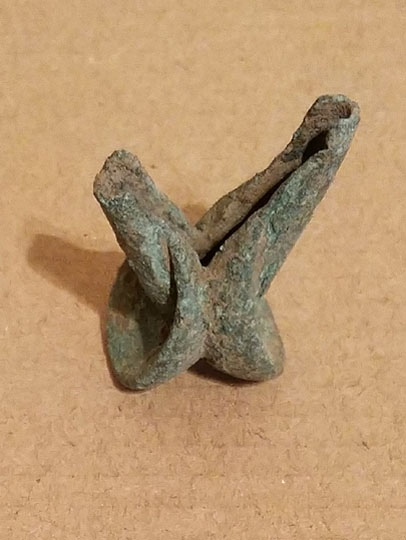
Found at the same time as the Funerary Paten on the previous page but two, this also probably came from either the original, early church at Sutton-on-the-Forest, North Yorkshire or from Marton Priory.
1 1/2" high, 1" wide and made of copper alloy, the Candlestick is in the form of a pair of leaves placed back-to-back : leaves representing hope, renewal and revival. Although appearing unlikely, it free-stands securely and will have been placed, with candles lit, before an image of the Virgin Mary : hence not left unattended. Also appearing most unlikely, it can be held securely between thumb and finger.
Complete but for the upper third of one socket, paired lights represented to the Church the duality of Christ as God and man. Its monastic function, design, and particularly the narrowness of the sockets indicate that short, hybrid, beeswax-enrobed rush candles probably were used : rather than conventionally-wicked candles.

Despite the absence of the vessel within the rebated lip of which this sat, its shape, size and ecclesiastical decoration are confirmatory of it being the Lid of a Pyx that was used to contain the Reserved Host : as referred to on the previous page.
Finely made of copper alloy, with a diameter of 1 1/4" and a height of 3/8", it has come from the collection of a detectorist from Thetford, Norfolk. Whilst conjectural that it originated from the Cluniac Priory of Our Lady of Thetford, its characteristics are consistent with attribution to a monastery of such standing. The Lid is decorated with four lobes forming a Cross : surmounting which the handle is formed as a Cross Pommee. The pin by which the handle is attached to the Lid is complete and extending only to be flush with the underside of the Lid : thereby confirming that it was not attached to a lower lid of greater diameter as might have been supposed.
Whilst many enamelled pyxes from Limoges have survived, there are very few remaining that are English : to the extent of increasing the significance of this Lid.
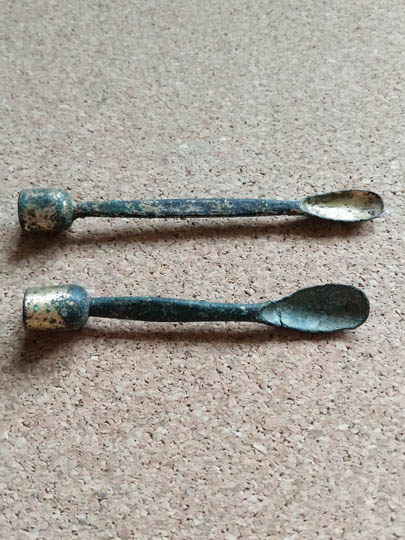
Made of gilded copper alloy and at lengths of 2 1/2" and 2 7/8", although closely similar, the Spoons were not recovered together.
The ends of each Spoon served different, but related, functional purposes : the cup being for anointing with consecrated oil and the bowl for serving the consecrated mixed water and wine to the recipient of Mass. Their design and small scale assert their dedicated function in providing succour to the sick or dying : reflecting use of the generic term 'travelling spoon'.
Although the geographic source of the smaller Spoon is not known, the larger one was acquired from the collection of the finder. Recovered during the 1970's, with commendable frankness at his uncertainty, the supplier explained that it probably was one of many items then recovered from Hertfordshire. These being similar but not identical, such Spoons invite the thought that there was then a typical form : of which other examples may be known/found.

This English fifteenth century sandstone carving is about 11"x11"x7" and depicts the known form of a 'cautious man'.
A notable aspect of his provenance is that the true pair to him depicting an 'incautious man' was sold at auction in recent years : whence described as a 'Green Man'.
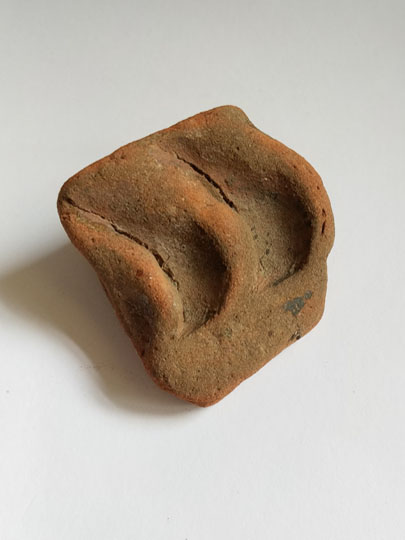
The seemingly complex shaping of this piece of ceramic misinforms as to the simplicity of its design, making and use : the two indentations being merely thumbprints into the clay used for its manufacture.
Measuring 1 3/4" x 1 3/4" x 1", it is complete as made and has sustained only limited surface degradation : in the form of cracking along the tracks for/of the wicks.
Small pieces of solid beeswax will have been placed in the two apertures and the whole heated sufficiently to enable controlled insertion of wicks into the molten wax : each overhanging the upper lip. Following cooling and hardening, one or both wicks were lit according to need.
Recovery from the River Tees at Piercebridge, County Durham in 1976 most likely was facilitated by the extreme drought that year.
So essential and extensive the need for lighting that the variety of solutions devised to meet it should not surprise. This is perhaps one of many the purpose of which has gone unrecognised.

With such an interesting and unusual subject, usual antipathy towards anything from the mass of available material called 'mounts' was suppressed in order to have Adam and Eve join the Collection.
Made of copper alloy and measuring 1"x11/3", self-evidently it is pierced and deeply modelled so as to transcend its small size as seen.
There is just one other known which is nearly identical and recorded with the Portable Antiquities Scheme. That was found in Hampshire and dated 1100-1300. If only the one from the Collection had been known at the time of the PAS listing, that they represent Adam and Eve aside the Tree of Life and are next to certainly box mounts would have been recognised and recorded: mounting pins present being of a scale indicating a box and not a belt mount.
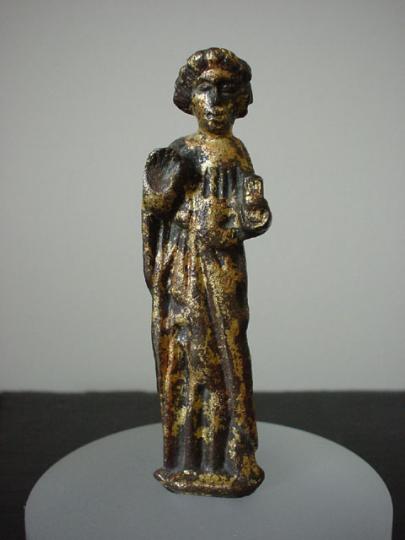
We have reason to be grateful to those whose research of early things has been recorded for posterity. The subject of processional crosses and the figures attached to them has received studious care from a number of such academics.
In a sense, without cheapening these, they can fairly be described as formulaic in design and making. Made of gilded copper alloy with figures of Christ in the centre, the Virgin Mary to his right and Saint John to his left, even the moulding of the bases as attached to the overall structure of the cross is to a common pattern. This is not to say that there are many figures surviving : those which did will have been broken from crosses at the Reformation to be retained by the faithful as devotional images.
Whilst this 4" high fifteenth century figure of John is from an unknown location, fortunately the 'finding provenance' of the following three images is known.
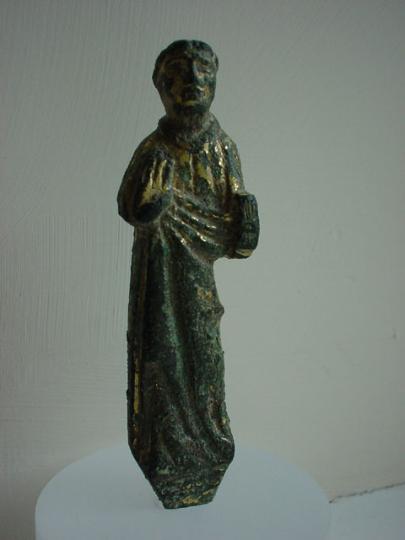
From Castle Hedingham in Essex, this 31/4" high copper alloy ( bronze ) processional cross figure of Saint John is virtually identical to another in Colchester Museum.
( see preceding page )

Probably by reason of there being lead in the alloy used for manufacture, this 31/4" high processional cross figure of John from Runhall, Suffolk is materially heavier than the other figures in the group.
( see preceding two pages )
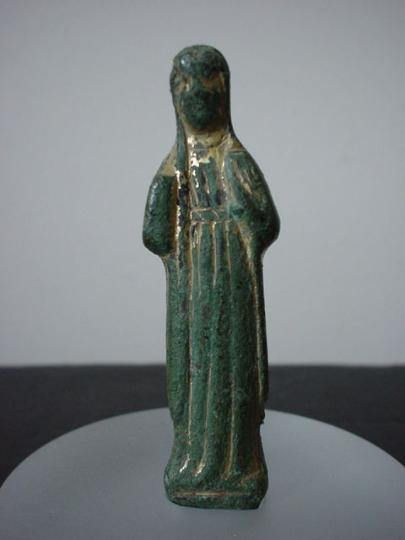
Whilst there are quite a few processional cross figures of St. John extant, those of Mary are near to non-existent. Perhaps this is because it will have been more life-endangering to have been found in possession of a Mary rather than a John during the Reformation period and these may well have been melted down in greater numbers. This 31/2" high figure is from Hindringham, Norfolk.

In order to protect the holy water contained in a medieval font from theft and subsequent profane use, a cover was locked into place. These substantial covers could sometimes reach literally yards above the font and be worked in considerable decorative detail.
Large covers were raised by use of a rope and pulley attached to a ( possibly roof ) beam. The girth of the ring for the rope would suggest that the associated cover was itself large and heavy : albeit not of the scale of some surviving covers. Perhaps now, it is most notable for its ambiguous blending of sternness and humour : the cherubic angel raising a supposed font cover which will have been matched in design by the actual font cover beneath.
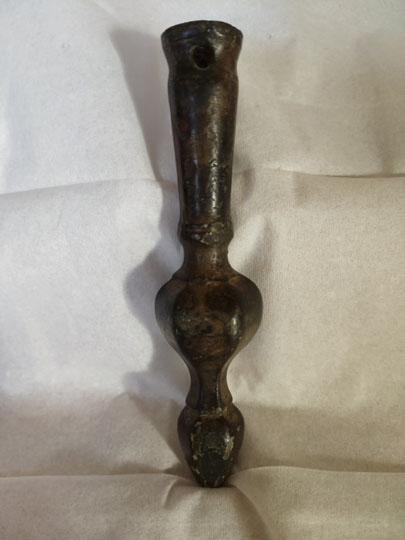
Not every day is found a 'new' design of candlestick and, even less likely, a functionally different type of stick. Whilst this meets each of those criteria, tomorrow may be found a dozen like it.
Made of copper alloy and measuring 31/2" in height and a maximum of 3/4" in width, when inverted it looks to be a somewhat commonplace finial. Apart from the 'feel' of it when handled, three physical aspects do however confirm it to be a candlestick : it comprises two elements peened together in traditional candlestick-making manner if not form, the socket has been burned extensively over a long period of time and it even has compacted wax of years in that socket.
Whilst it will not have been unusual in a secular or ecclesiastical environment for a lit candle in one candlestick to have been used to light candles in other candlesticks, at the least it would have been an awkward and inelegant task. Medieval candlesticks made and used specifically for that purpose appear not to have been identified or discussed.
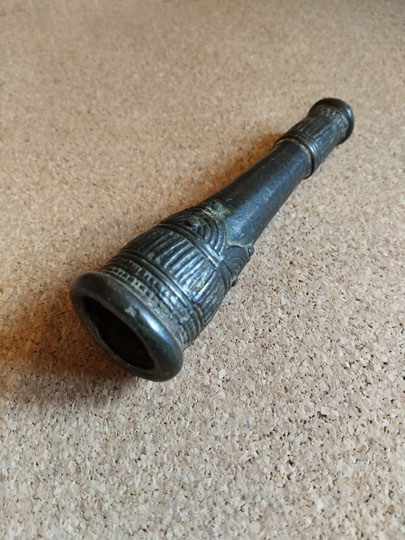
Being overtly Roman in style and hence somewhat alien within a Medieval Collection, this 'dual-aspect' candlestick is considered relevant for inclusion by reason of its functional purpose. Whereas the candlestick shown on the previous page was most likely used for lighting other candles, this was used for spacial lighting when being carried : with the wide or narrow socket in use depending upon circumstances.
Measuring 3 1/2" in length and with external socket widths of 1" and 1/2", it is made of copper alloy and in good, complete condition. So straightforwardly basic a form as this invites calling it 'a Torch' and it would not be surprising if this were to accord with Roman nomenclature therefor.
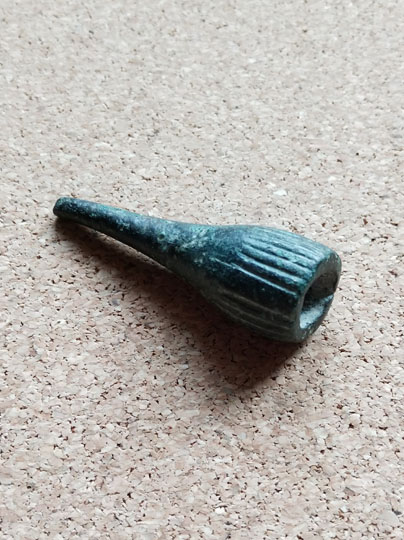
Similar in basic form to the candlesticks on the two preceding pages, it is by reason of the fabrics, surfaces and decoration that such different periods of making can be ascribed to each one.
Measuring 1 3/4" in length and with a maximum socket width of 1/2", this is made of copper alloy with the only 'period-indicating' decoration being that of the vertical striations which surround the socket.
This is a somewhat unusual object from the period : which seems now to be represented mainly by extant weaponry, tools and items of personal adornment.
Whilst not visible in the photograph, there is a 'wire' straddling the aperture of the socket about 1/4" below the lip. When a tranversing knife-cut was made centrally across the base of the candle prior to it being pressed into the socket, this will have added considerably to stability of the candle when being carried. The fixing, if not the making, of that support, will have required skill and care.
Unfortunately, the only available provenance is that of it having been acquired from a British collection formed between the 1960's and 1990's.
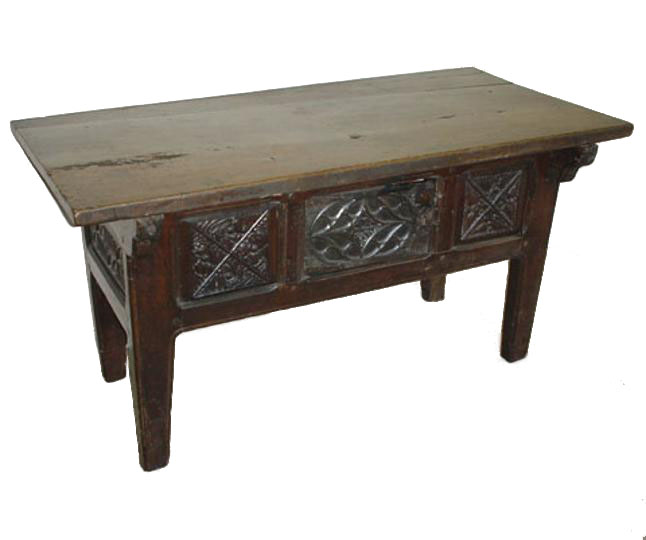
Perhaps only by seeing depictions in manuscripts or tapestries may we learn the manner in which tables such as this were used. With an undecorated, single planked rear 'frieze' panel, it most probably was placed against a wall and not used for dining on any scale : other perhaps than for the well-understood practise of storing food and drink for the long evening candle-lit hours of darkness. The quite different form of furniture apparently most often used for that purpose, the buffet, is however well explored in the record.
The 5' 2" long oak table dating from about 1480 is English and mostly complete : excepting the 'cupboard' floor and re-tipped legs. There is another in the V&A which is somewhat less complete : apparently having only four panels and two front legs which are original. With respect towards the V&A's present curatorial staff, that this is described as a table clearly would not accord with current practise. The shaped and moulded legs and rails together with the carving of panels and door provide a quietly appealing, restrained aesthetic combination worthy of the period.
Retained with the Collection is a V&A postcard depicting their table which has the handwritten date of '21.11.40'. Whoever visited the Museum and bought the subsequently unposted card on such a dark day in wartime Britain must have been a serious enthusiast. Long may we maintain such interest in and commitment towards our shared heritage.
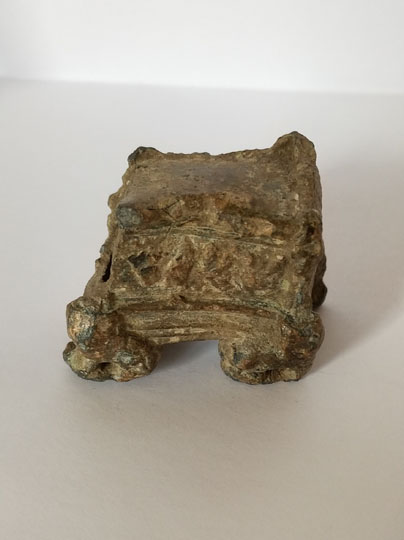
The role and function of reliquaries are ideally understood as an element of the cult of saints in the Anglo-Saxon and medieval church. The veneration of notable holy people took physical form in the creation of shrines to them, both within structures dedicated for the purpose and within ecclesiastical buildings for wider religious use.
Ranging in size from small, box-like reliquaries to 'body-containing-sized' tomb chests, they served the same purpose of preserving and presenting the remains, relics and attributes of the saint venerated at each particular location.
Some large structures, including tomb chests, remain in English churches. Also, by reason of the extent to which they were made and their aesthetic attractiveness, quite a few reliquaries from Limoges are extant. To reference an English medieval miniature reliquary however is difficult if not impossible: with the possible exception of one in alabaster in the Metropolitan Museum, New York.
Measuring only 11/4" wide, 1" high and 3/4" deep, the tin alloy reliquary is flat-backed, stands on lions as front supports and has a decorated front 'panel' with a true left hand panel in two reserves: each of which has a quatrefoil within it. It is complete except that the central section of the true right hand upper end has been broken away and that, as there is a slightly raised section at the top of the left hand end which is fractured, there may have been a low 'superstructure' of some sort: perhaps even a very low 'canopy'.
If this was one of many such, it would be seen to be a more complex ( three-dimensional ) devotional object but serving the same purpose as a pilgrim badge : that is, a memento of a visit to a particular shrine. Apparently unique, and thereby invalidating such explanation, it has, for the present at least, to be considered simply as a generic English devotional object.

Clearly depicting a young boy, this fifteenth century 15" high oak figure affords little certainty as to his role. Most probably ecclesiastical, he may be a member of a 'song school' : a chorister in the making. Perhaps less likely, he may be a young mourner or pilgrim. Notable, self-evidently, is his period dress and the extent of remaining original paint.
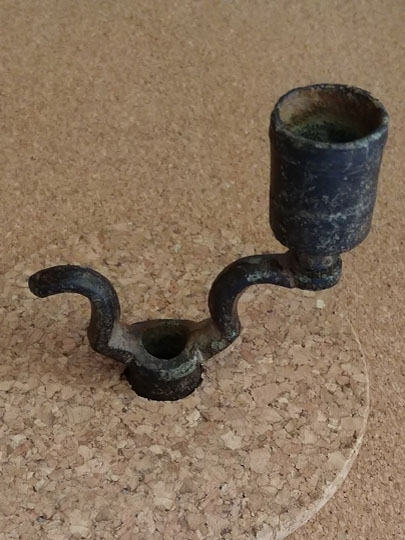
Acknowledging but discounting the many sometimes only vaguely similar Continental examples in brass, which often are anthropomorphic and usually post-medieval, this recognised form of English Candlestick has survived in even smaller numbers than those of the 'first stabilised English form' : two examples of which are shown on other pages. A pessimistic interpretation would say that only two of this Double-Socket form in a complete state are extant and that even one of those is questionably 'real'. The fully credible one deserving of being referenced is in the National Museum of Wales, Cardiff, and can be seen online. Thanks to the sterling service provided by the British Museum's Portable Antiquities Scheme database, it can be seen that there are approximately twenty fragments of this type of candlestick that have been found in England. Whilst the twenty include both sockets and fragments of arms of this type of Candlestick , just one is not only as complete as that in the Collection but, whilst also now having only one socket, still has in place the ring that held the second socket. In consequence of such limited survival, this one is of notable academic significance as a source of reference : its incompleteness being inconsequential for understanding.
Originally it will have comprised a tall, narrowing pricket peened into a round, unfooted base and a double-socket arm that was placed over and around that pricket to be retained in mid-position as it widened. Now gone are both the pricket with base and one socket with its means of attachment to the Arm. Made of copper alloy, the Candlestick will have been 3 1/4" wide and of indeterminate height.
Its finding on the boundary of the parishes of Fundenhall and Ashwellthorpe, Norfolk on 23.3.19 has enabled realisation of a long-held wish to have an English example of this form in the Collection.
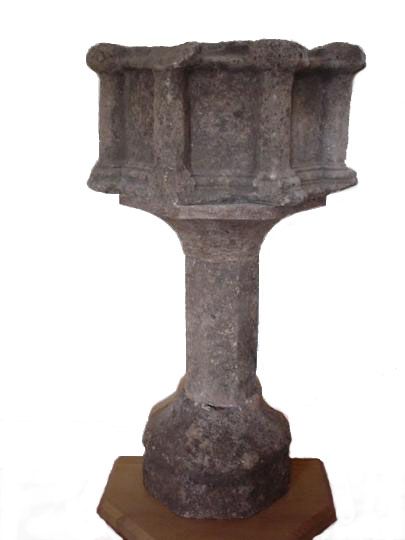
One of only four English medieval credence tables extant, this was inset slightly into a chancel wall and pinned thereto by brackets the apertures for which are present and undisturbed in the back of the table. Mounting brackets in similar form to the period ones have been made to hold the table in place on an oak stand and hence to display it as when originally installed.
Much has been written on the function of such tables but, in brief, they were used for placement and display of cruets containing water and wine which were mixed during Substantiation for the Mass.
This medieval form spawned a plethora of credence tables and cupboards in oak during the late sixteenth and entire seventeenth centuries : some highly appealing and others merely formulaic.
For the record, the story of the finding of the table and of its present state is as follows :--
The table comprises four separate elements namely the top, capital, column and base. To envisage the state of the table when found by an eagle-eyed, purist antiquarian, turn the top upside down and concrete it onto the upper face of the capital. Now fix a heavy iron pin into the upper face of the top for display of a figure. If this joining had been undertaken by use of lime-based mortar, the top and capital could have been eased/prised apart and the entire table be returned to its original state. However, in order to save the top, the capital was measured, drawn and then sacrificed. The present capital was made as a faithful copy by the former Head Mason of England's most wonderful cathedral ( nominations 'on a postcard' if you wish ). The lifetime experience of the finder enabled identification and rescue but also afforded heartache.
Finally to note, whilst the other three stone tables were ( in some cases still are ) used during the Mass, this is the only one remaining in this design : and hence the only forerunner of later oak examples extant. There is at least one 'pillar piscina' in a West Country church in this same form but the presence of a drain in that confirms its identity to be that of a piscina and not that of a table.

Recovered together with many items of English pewter from a ship which was wrecked in the Caribbean in 1545, this pair of cressets ( floating-wicked lamps ) measuring 3" in height and 4" in maximum diameter are made of cast and wrought copper alloy ( bronze ).
Capable of being suspended from a beam or placed on a flat surface as chosen, it cannot be determined whether they were in transit with the pewter for later domestic use or whether they were for use on board ship. Perhaps, if the organic material which has stained the interior of the cressets could be analysed, it may be learned whether these contained wax or ( whale? ) oil. This however would still not confirm whether they were used on land or sea.
That they now are in such good unrepaired condition belies their recovered state : apparently that of two large, heavily concreted cannon balls.

On the preceding page can be seen the mounts for the handles of each of the cressets : the ends of each handle passing through those side mounts. The alternative manner in which handles were attached was by brazing mounts such as this one to the upper outside surface of each side of a vessel : each mount having a 'depression' on the inner face by which the ends of the handle are retained.
Whilst not always so, such mounts are sometimes formed as heads in a closely similar typical style and form. This fourteenth century example, found very close to Blakeney Priory in Norfolk, is notable both by reason of its exceptionally large size and weight (ten ounces), completeness (they usually are 'snapped off' from the vessel) and excellent condition. One usually distinctive form of vessel with its handle typically mounted in this way is the Situla : used within ecclesiastical environments for holding Holy (ie. blessed) Water. Such vessels usually being relatively small, it is unlikely that this head came from one such.
Because the style of this one is, at one and the same time, both vaguely similar to yet very different from the typical faces of anthropomorphic vessel mounts, it begs the question as to whether most of those surviving are Continental whilst this is English.
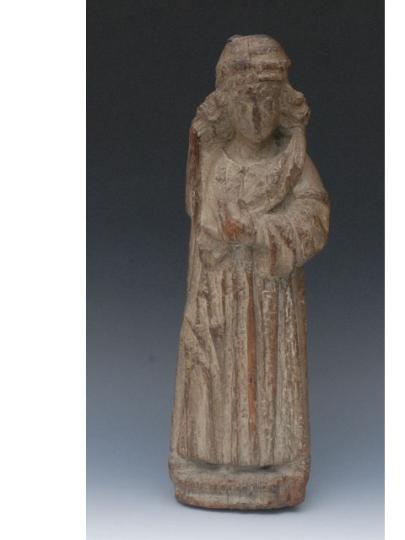
That this English fifteenth century 18" high oak figure is of Mary Magdalene is denoted certainly by her traditional long hair and probably by what seems to be a scourge laid across her breast.
Sadly, the most notable characteristic of the carving is its very survival : such figures almost invariably being Continental.

There are two fundamentally different ways in which to make candles : by enrobing wicks that are dipped repeatedly into a vessel containing hot wax or by pouring hot wax into candle-shaped moulds. Whilst the former will have been undertaken by use of vessels now unidentifiable as to purpose, the latter involved use of single or multi-tubed moulds the identity of which is obvious. Whilst such post-medieval moulds for making candles are extant in large numbers, medieval moulds for making candles appear not to have survived. Perhaps this reflects the possible nearly exclusive, habitual use of the dipping process pre-Reformation.
The size of candles used in ecclesiastical environments reflected the desire for overt display : even when paid for by people of modest means. Of materially smaller size will have been votive candles for placement in the home before a picture or image of a person being revered or remembered : whether Godly, Saintly or familial. Whilst candlesticks used in this way are known, as evidenced in this Collection, the moulds for making candles therefor appear not to be : albeit with this one as an exception. Perhaps there are others that, by reason of size and/or apparently indefinable purpose, have gone unrecognised.
Measuring 1 1/2" x 1/2" x 1/4", this Mould, wrought of iron, was used for making small candles for socketed candlesticks : the size of which most likely indicates them having had a votive purpose. For reason of material of manufacture, design and size, it was not used for the moulding at high temperature of ingots in any type of metal. Heated beeswax will have been poured into the Mould until it was half-filled. Following a short period for cooling, a wick will have been laid centrally across the wax with its ends overhanging each end of the Mould. Thereafter, more heated wax will have been used to fill the Mould to its lip. Weighting the ends of the wick as they overhung the Mould will have ensured that it did not move out of place during this second phase of filling. Following final cooling, the candle will have been lifted from the mould by use of the wick ends and, when trimmed, will have been ready for use.
Whilst in good, original condition, the Mould now contains determinedly compacted material that reduces the apparent size of the aperture : and hence the expected size of candle produced therefrom.
On the following page is an unrelated object so ideal for filling a Mould with hot wax as to indicate that it was used for such purpose.
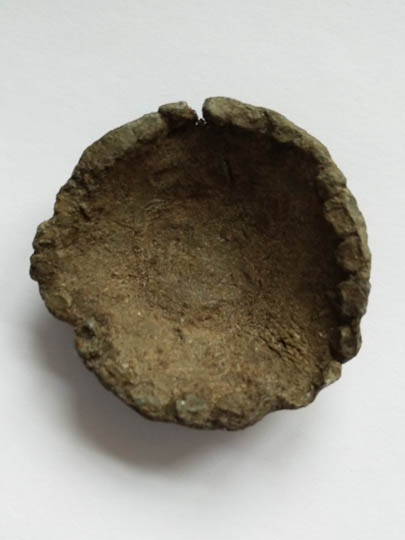
At first observation, this small, wrought lead bowl is of indeterminate specific use : but handling and consideration during a long period has led to a conclusion as to that use.
Each of its physical characteristics, when considered in combination, show it to have been used to heat and pour Candle Wax. Made of lead, measuring 1 1/2"x 1/2" and with a pronounced, circular raised foot and crenellated lip, it becomes apparent that material of manufacture, design and size show it to be a Pan for heating beeswax or tallow ( fat from cooking) : by placing it on a hot hearth and pouring the then-liquid wax into another vessel.
Pouring of hot wax from the Pan into the Candle Mould shown on the previous page is predictable, safe and easy to an extent not apparent from the picture : not least because of the non-obvious pouring spout in the centre of the left hand side. Whilst not acquired together, when placed and considered together the practicability of such a functional relationship between vessels of their type used for this purpose suggests that they evidence such likely, synergetic use from the period.
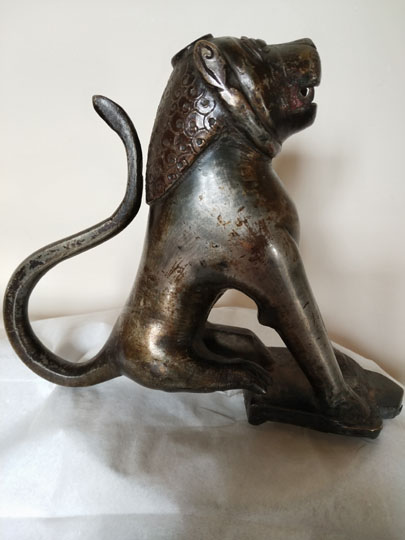
Exploratory understanding of this unusual object is aided in three ways : by knowing and recognising the significance of its size at about 7"x7"x21/2", its considerable weight at 5lb 3ozs. and by seeing the striking stylistic similarity to aquamanilia.
Despite similarity to those highly atmospheric water dispensers, this is not one but is, in basic terms, a handle which was attached to the lid of a vessel.
Whilst appearing to be made of silver, it is of copper alloy with remains seemingly of gilding and certainly of paint still clearly visible. Beneath the 'base plate' are two threaded bolts: one of iron set into a period copper alloy stem and the other also of iron but brazed directly onto the base plate. The one originally and later the two were the means by which a lid was attached. The combined lid with Handle/Finial was then placed onto a vessel which must have been of a considerable size. The slot which rested over the lip of the vessel when the lid was in place is highly pronounced, has a width of almost half an inch but is not visible in the photograph in its position immediately behind the base plate and behind the back feet of the Beast.
Perhaps a real 'giveaway' to its most probable Asian origin is the mounting position in the top of the head: perhaps for a plume.
As a part of the Collection, whilst obviously early it clearly is alien. It has however been shown in an attempt to attract knowledgeable interest which may aid in establishing provenance. Its design and scale might well evidence its cultural importance but where is it from and what was the purpose of the very large vessel which it crowned? Recent provenance is of its surfacing from very long-term (unpaid!) storage. Whilst hopefully not so, if it is found to be part of another's cultural heritage which has been purloined, it will be returned with alacrity into appropriate safe-keeping.
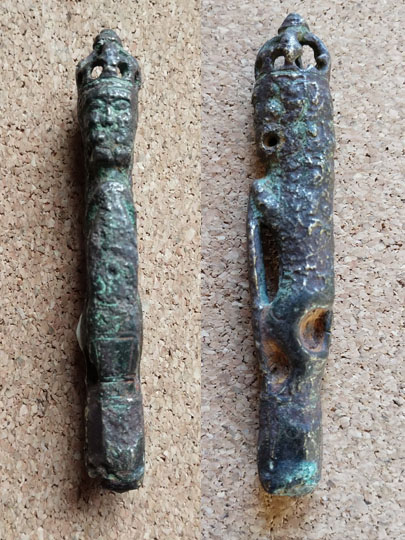
Made of tin alloy and wrought in the round over an iron staff, the lion projects authority which belie his dimensions of 2"x 1/2"x 3/8". Rearing on his hind legs to grasp the top of a shield, he wears a crown through which can be seen the upper end of the iron rod around which he has been formed. The figure is in complete good order except that just one minute end of the ring which spanned his mouth is extant and that the staff has been truncated below the interface of iron and tin alloy. That he has the face of a man is not unusual from the medieval period, but that his mouth is ringed in combination with that face most certainly is so. Such untypical iconography might be explained by him being a representation of King Richard the Lionheart : the majesty and strength of a lion being tempered by his period in captivity at the beginning of the thirteenth century. Anticipating that he is from a Staff is not untoward, but conjecture as to the context in which the Staff was used and displayed would be unsound.

That cathedrals and many monasteries and churches were large, complex buildings is evidenced by those extant : many of which remain complete but many also now lying in ruins. The faithful communities who lived and worked within these buildings prayed for the population at large, regularly and extensively, in accordance with the strict calendar and practise of the Church. Their forms of worship involved the conducting of small ceremonies : many of which were of modest scale and procedure. In an unpretentious manner, those few engaged in such will have processed to the particular altar or part of the building in order to take part. The present-day equivalent of such processions can be seen in grand ceremonies led by a Celebrant carrying one of the forms of staff in precious metals used therefor : these usually being surmounted by a cross or being in the 'shepherd's crook' form of a Crozier. Such can, however, also be seen in the present day with just a few worshipping in a formal but modest manner before a side altar of a cathedral.
No flight of fantasy is required to envisage this finial, when affixed to a staff, being used frequently to lead small, pre-worship processions. At its size of 2"x 1 3/4"x 3/4", that it came from and was used in a modest establishment is most likely. Whilst it is known that it was found in the vicinity of Brockdish, Norfolk, provenance to a specific building or community is not known. When seen and handled, whilst robust beyond expectation generated by the photograph, it exudes humble monasticism.
Made of copper alloy in the round and pierced on each side, there is a representation of Christ on the Cross denoted by means of five raised 'points' as can be seen in the photograph. On the flat reverse is a cross rendered highly identifiable and visible by being boldly pierced. Perhaps only by making a chance find of the depiction of such a Staff Finial within a medieval manuscript could it be learned whether the space within such finials was filled with colour-rich fabric or left void. If so infilled, the practise of wearing vestments of a specific, different single colour to denote the period within the ecclesiastical calendar may have been matched by that colour being displayed within the finial. If this had been so, this finial and the Staff to which it was affixed would only have been used during one period of the year.
One other likely use of the Finial has to be considered : that it was affixed to the Staff of a pilgrim. During the medieval period, there was extensive engagement in pilgrimage : both within Britain and between Britain and Continental Europe. The Pilgrim's Staff was an expected element of equipage for pilgrimage and announced the purpose of such journeying. Use of this Finial in such way should not be disregarded on grounds of it being an unexpectedly fine object as pilgrimage was engaged in by rich and poor. What is unlikely, however, is that a finial will have had different designs on each side as this has : whereas this difference will have been appropriate for a Staff used in the formal manner here envisaged.
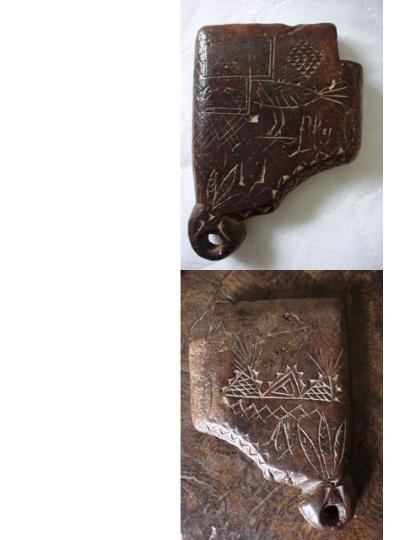
An item wholly different from others in a collection can be intriguing : there being an indication of quality justifying presence of a stranger in that company.
There are two fundamentally different types of panflute : one made from a single block of material and the other from a group of tubes bound together. The former type dates at least from the Viking period : the latter type typically but not solely pan-American. This is probably of boxwood and clearly has Native American decoration. It is known with certainty to have come from spending a long period of time in the collection of a greatly respected, long-deceased major dealer in early furniture and works of art.
Some research has been undertaken but further experienced opinion would be appreciated.
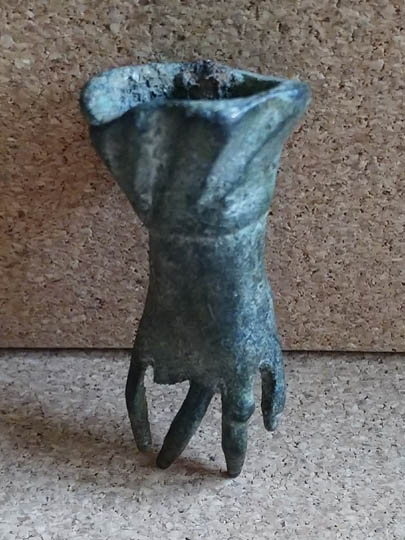
The murder of the Archbishop of Canterbury Thomas Becket in Canterbury Cathedral on the twenty-ninth of December, 1170, was of such religious and political significance that Henry II later walked barefoot to Becket's tomb and submitted to being whipped by monks in order to make penance : the murder apparently having been undertaken in response to overheard words of frustration with Becket expressed by the King.
By this date, the establishment of shrines in commemoration of specific saints was established practise : these being visited internationally by large numbers of pilgrims. In order to have a record of their visit, pilgrims bought ampullae that they filled with holy water, badges and other objects that made reference to the saint revered at the shrine : many depicting or alluding to Becket being extant. Although most of these in commemoration of Becket depicted him, his reliquary, or a scene from his life, one type depicted a pair of his gloves : of which the British Museum and the Metropolitan Museum in New York each have an example. The distinctive, macabre form that these took leaves no doubt as to their identity.
Pilgrim badges next to invariably were two dimensional and with little depth. Whilst this tin alloy Candlestick stylistically matches Becket glove badges, at its size of 2 1/2 x 1 1/4 x 1", and with a mounting point in the centre of the back, its identity as a devotional Candlestick and not a badge is self-evident. Because the mount is of purposefully dedicated design, this will not have been sold as a memento but been mounted (perhaps with one or more others of its like) on the vertical face of one of the numerous shrines to Becket. Whether candles were placed in the Candlestick and lit by those managing or visiting the shrine is uncertain : if the Candlesticks were few in number, probably the former but, if many, probably the latter. In writing, the deeply moving experience of seeing thousands of lit red candles on Good Friday in Paris's reverently hushed (pre-fire) Notre-Dame comes to mind.
Whilst the Candlestick has come from the collection of a detectorist from Eastbourne, Sussex, no more is known of its provenance.
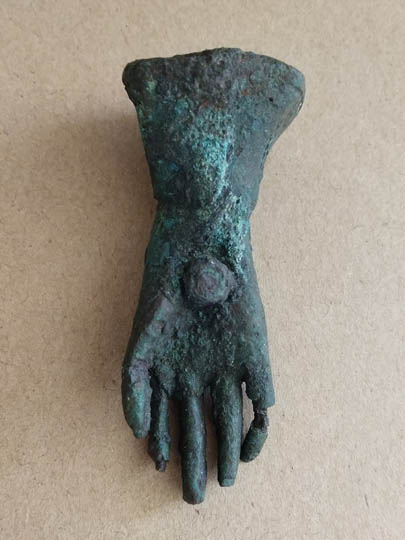
Whilst the possibility of there having been other candlesticks of this type extant was mooted on the previous page, that one would materialise within half a day of publishing was unexpected but fortuitous.
Somewhat larger than the previous example at 2 3/4 x 1 1/4 x 1 1/4" and made of copper alloy instead of tin alloy, that this Candlestick was used in similar circumstances can safely be presumed.
Particularly targeted for attack by Henry VIII's Commissioners at the Reformation were the shrines of Saints : including those dedicated to Becket. Even his shrine in Canterbury Cathedral, the place of his murder, was wrecked by order of Henry.
The Candlestick having been found in Hereford is notable as it confirms the design not to have been a single location/shrine phenomenon and suggests that it might have been associated with the altar dedicated to Becket formerly in Hereford Cathedral. A reliquary of Becket that was placed on that altar remains in the Cathedral's care.
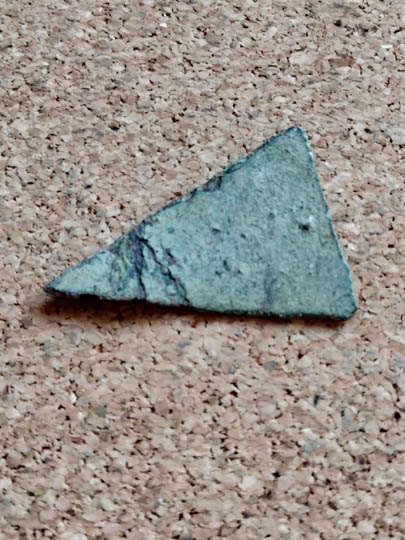
Although similar in basic form, differences in detailing between this Plectrum and the the Anglo Saxon example acquired earlier shown on the following page, reveal their different cultural origins.
Made of tin alloy and measuring 1 1/4 x 7/8" this is in complete good order except for the visible cracking.
It was found during the 1970's in Aldborough, North Yorkshire, the former stronghold of the Celtic Brigantes Tribe.
As when writing about the Anglo Saxon Plectrum, the apparent absence from the record of other examples from that period also applies to this one from the Celtic Period.
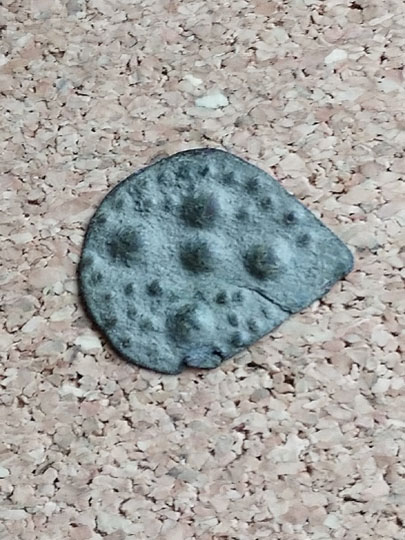
Unsurprisingly for such simple, functionally-focussed objects, plectra have for millenia remained of closely similar size and design : the one variable being the material used in their manufacture. This we know, as much else concerning early things, from existing pictorial records.
Made of copper alloy and with typical Anglo-Saxon decoration, the most notable aspects of this plectrum are its completeness, condition and very survival.
That such an interesting, albeit modest item found in York during the early 1970's can still here be seen, invites appreciation of the longevity of the lute, the lutist and their music : but not of the plectrum itself. Where is there even an identifiably medieval extant example, let alone an Anglo-Saxon survivor?
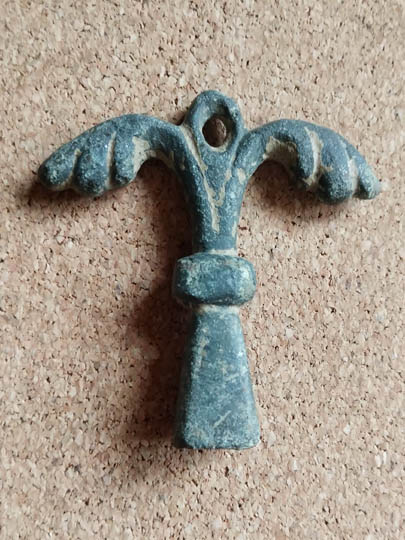
Although not recovered together, the opportunity to associate the Anglo-Saxon Lyre Plectrum shown on the previous page with the Tuning Key was fortuitous.
As with all stringed instruments, each string of the unfretted lyre (usually six of them) was held in tension by a (typically) wooden peg. The string was threaded through an aperture in and wound around one end of the peg : being tightened by positioning the Key over the squared other end of the peg to enable playing of the required note.
There apparently are twenty-six early lyres extant : almost none of which are from Britain. Additional to the obvious reason for this dearth that they were made of wood, as lyres were seen to represent English cultural nationalism, they were outlawed by the Normans. The number of extant lyre components (bridges, pegs and tuning keys) can be assessed only from a few disparate references, and it appears that only five keys have survived : including this one.
Acquired from the finder, who recovered it from 'within a five-minute walk' of the major Anglo-Saxon burial site in Sittingbourne, Kent, the Key is made of copper alloy, measures two inches square and has flanges to enable turning in the form of the wings of a Raven. Both the British Museum's lyre from the Sutton Hoo ship burial and one of the other extant keys depicts a Raven, or wing thereof. Note that the wing is singular : being from a complete key that has just one wing-shaped turning flange. The adoption of the Raven within the context of the lyre alludes to Apollo, the Greek God of Music, Prophecy and Healing : the lyre being the instrument of the Anglo-Saxon minstrel/bard.
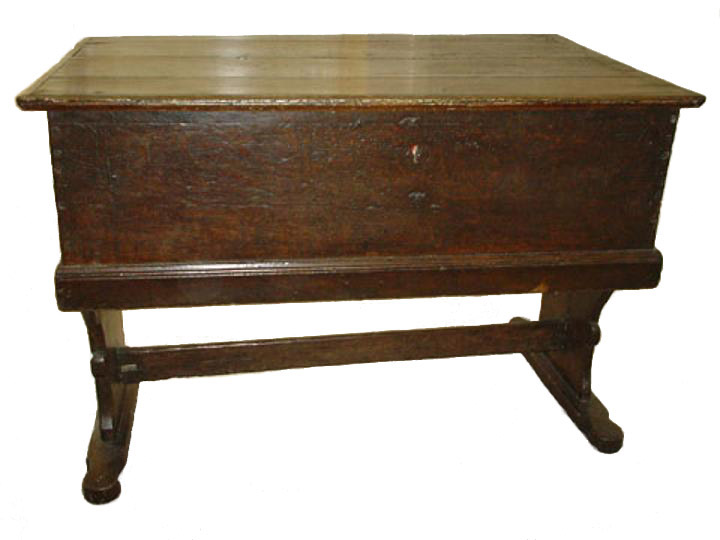
The two counter tables shown on this and the following page will have been made by the same craftsman/workshop : despite having come to the Collection from different sources and at different times. This is particularly surprising as there seem to be no other period boarded ( rather than panelled ) counter tables recorded.
This first one measuring 3'7"x 2'2"x2'7" is in near original condition. As with seemingly all extant counter tables, the top is now hinged rather than sliding. Whilst the cleats are, most surprisingly by reason of their fine fragility, both original and complete ( note that that there were only three originally ), the top has been turned through 180 degrees before being hinged. This is confirmed by reason of patination of the cleatless top edge on the side where the 'owner' sat to transact his business and that the decoration and key position are on that same side. Somewhat perversely, there are small, later 'endcaps' on the outside of each end plank in the position of the stretcher. These would not be required to retain the stretcher in place if a peg had, as originally, been inserted into the aperture visible on the left of the photograph.
Highly notable is the period incised, complex decoration of arches and circles : including the initials that are immediately below the key opening.
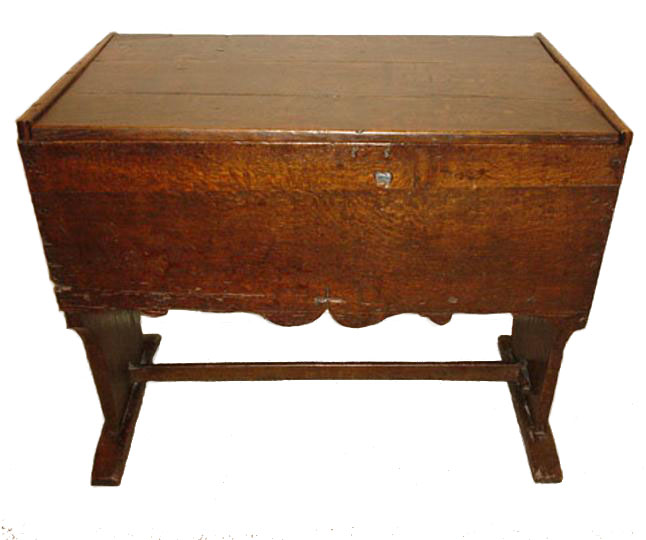
At 36"x23"x30", this counter table is somewhat smaller than that on the preceding page from the same craftsman/workshop. As with the previous table, the top now is hinged and does not slide as originally. During that process it has been turned through 180 degrees and the original cleats, which had been part of the sliding mechanism, have been refixed : albeit inaccurately. Whilst the rest of the table is original, the true right sledge foot has been replaced.
The back of the table not in view is decorated with a complex 'wavy-form' frieze and, as can be seen, the front has a frieze form including a cross similar to that of just a few of the most appealing apparently early boarded stools : some of which are a delight but most of which are fake.
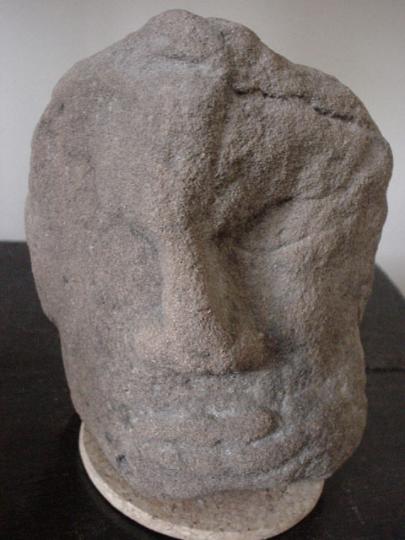
Located in the archivolts of medieval doorways or windows with no thought for symmetry, such heads were of any and every subject. Although probably not sited in a highly exposed external position, this seven-inch high fellow, looking rather like Lindow Man ( from an ancient bog in Wilmslow Cheshire ), is made of sandstone and has been worn by abrasion or the elements so that features on the right hand side of his face are diminished.
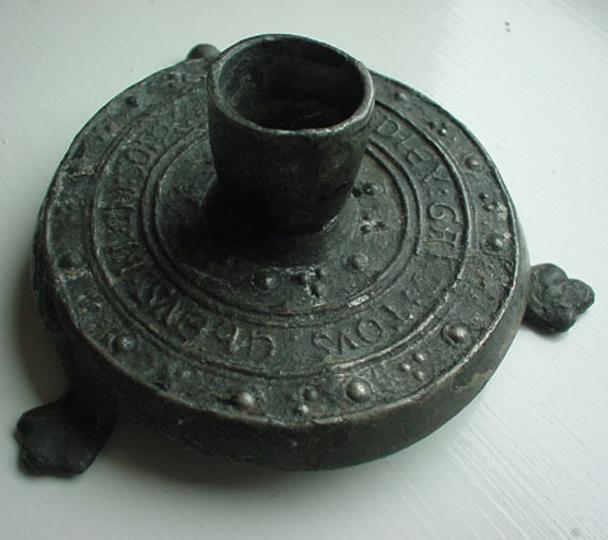
Listed with the Portable Antiquities Scheme as 13th century French, the text translates as 'May God protect all those who are here and who made me'. There is another example known which is part of the ( now ) Stirling Castle Collection of pewter. As these were each found in London and as French was in common use in 13th. century England, maybe the attribution of country of origin should be considered uncertain.
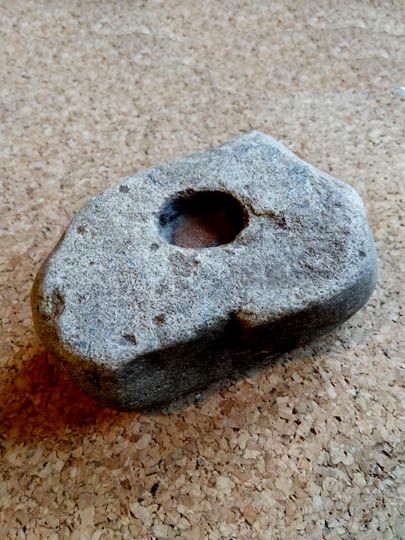
The 4 x 3 x 1 1/2" Candlestick has been displayed in the collection of the archaeologist Gordon Hardcastle since being found by him in the 1950s where Galphay Lane, Ripon crosses the River Laver. Closely adjacent to the East of the find location at Copt Hewick is a complex of Neolithic monoliths, and the area later was a stronghold of the Celtic Brigantes tribe.
The complete, undamaged Candlestick will have been revered and protected : the religious/cultural significance of its form being indicated by the many large-scale megalithic works and non-portable, similarly decorated stones remaining in the North York Moors. The cup within the Candlestick is closely comparable with those multiply used to decorate other such stones : albeit this stone being unusually small and the cup proportionately large. The reason for such decoration typically having been used so extensively remains a subject for debate. The size, shape, surface condition (including the cup), and find location of the Candlestick enables recognition and understanding of its use for lighting and later for votive deposition. Although obvious only when the narrow end is held between the first finger and thumb, secure holding and movement of the 1lb 4 1/2oz stone is thereby readily enabled : the left hand end feeling as though sculpted horizontally and vertically for purpose, despite being a result of selection and not of manufacture.
Although in clean condition following recovery from water, the Candlestick looks and feels to have been held frequently : ingrained grease in the finger and thumb positions remaining evident. If it had been used only for votive depositing and not as a candlestick, such patination would not have formed. To have been found in the River Laver in such a location shows it to have been a votive object that was 'sacrificed to the water' in a recognisable and not unusual manner. Notable is that small blocks of fossilised coral deposited with votive intent also were recovered from the River at the same time.
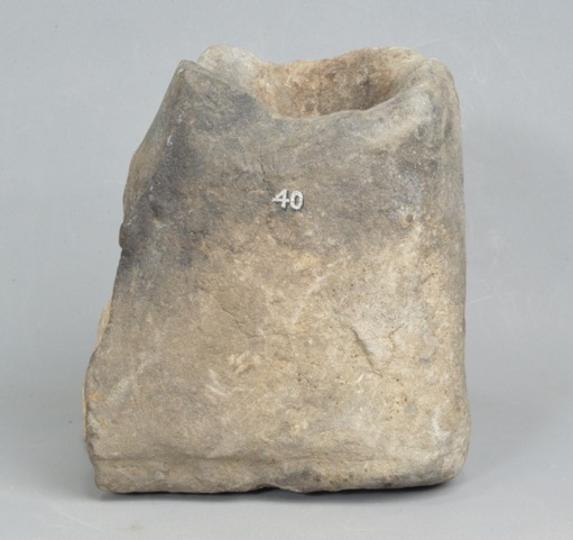
Found in 1915 in the cellar of a property on King William Street in London together with a ceramic cresset also shown in the Collection, this early medieval stone cresset is 5" high and in fine, informative condition. Most fortunately, it was recovered and has been maintained with great care. The evidence of a thirteenth century date for the ceramic cresset suggests that, by association, this one also may date from that time. For completeness and possibly to confound this, fifteenth century pottery also was recovered from the same cellar at that time.
It would be interesting to know in which collection it has been : as indicated by the catalogue number '40' painted most meticulously in silver with a fine lined surround in black.

Two and three-eighths inches in height and width, three-quarters of an inch deep and weighing fifteen and a quarter pounds, the Cresset was wrought from a billet of Lead.
In typical manner, combustible fuel (probably fat from cooking) was poured into the shallow top and a wick trailed from within it to lodge over one of the two incised lips to be lit.
Its identity as a Cresset, and its dating from the early Anglo-Saxon Period, is affirmed by being incised on the underside with one of the twenty-four Early Futhark runic symbols that is like the Roman letter 'V' (denoting 'Torch'), and by it having been made in that Runic form.
Recovery from Sutton-in-Ashfield, Nottinghamshire is notable by reason both of extensive Anglo-Saxon occupancy of the area (there having been 100 'freemen'), and of closeness to the most prolific lead mine in the world prior to and during that period.
Some 3,000 stones incised with runes remain, but a much smaller number of artefacts (weapons, dress accessories tools and other functional objects) so decorated are extant. Only this one of the twenty-four symbols has a meaning that is a noun and that specifies an object. Therefore, although this Cresset might not be unique by reason of its incising and form, no other type of object can similarly be identified by a rune. Worthy of note is that only use of this early form of rune enables dating of the Cresset to the Anglo-Saxon Period : either of the two later forms being Anglo-Saxon or Viking.

Made of tin alloy, 1" square and originally 3/4" in height, damage to and patination of the Candlestick is informative both as to the nature of its use and to the longevity of that use. Following damage sustained to the two now truncated legs, the other two legs probably were bent over to seek to render the whole acceptably level : resultant continuing use being evidenced by patination of the feet.
Recovered in 1985 from Ulleskelf, North Yorkshire by the archaeologist Gordon Hardcastle, as with the Anglo-Saxon Cresset on the preceding page, it is marked, albeit now obscurely, with the Rune denoting Fire/Light. Although it apparently was used infrequently by the Vikings for lighting, hardened deposits of beeswax remain around the plate.
There appears to be just one relevant, most interesting reference in respect of the Candlestick : the finding in 1880 of four wooden 'candlestick boards' from within a ship burial in Gokstad, Norway, that now are in the Museum of Cultural History, Oslo. Fundamentally, both those from the ship and this Candlestick are little more than apertured plates, but, less deprecatingly, it might be a sole British Viking survivor.
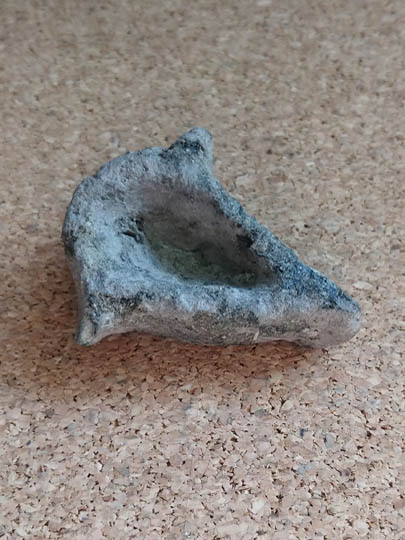
Made of copper alloy and measuring 1 1/2 x 1 3/8 x 1/2", with a maximum bowl depth of 3/8", this is functionally directly comparable with the cresset on the previous page but one. With this cresset also, its V-form adopts the Rune for fire/light. Residue from the cooking fat used as fuel for the light remains in the bowl. Seemingly improbable, but convincingly affirmed by handling, the protrusions enabled effective and securely predictable holding between thumb and finger, whereby to reposition the Cresset when lit.
No more is known of its provenance other than that it was sourced from Cambridgeshire.

Throughout the Medieval Period, public and private entertainment was provided by 'Minstrels' and 'Fools' (Jesters) : to the extent that they now are a part of folklore. Despite much having been recorded about them, both textually and pictorially, the ephemeral nature of their attire and equipment has resulted in next to none of it being extant. Many manuscript depictions of Fools from the late Medieval Period do however survive and show them attired and equipped in traditional style. They habitually carried a short staff : the finial of which was a head depicting their likeness when in character. These staffs were called 'Baubles' in England and 'Marottes' in France. The phenomenon of the Fool came to, and later flourished within, England following its introduction by the Normans : this by reason that they were aping 11th century entertainment in the French Court.
Found in Cambridgeshire, made of copper alloy, measuring 7/8 x 1/2 x 3/8", and both complete, undamaged, and comprehensively patinated, the portrait is akin to those on baubles : reflecting traditional style with the donkey-eared, bulbous-eyed Fool wearing a dunce's cap, irreverently grinning, and extending his tongue. Although the bowl of the Cresset is even smaller than that of the cresset on the previous page, its form is confirmatory of its function. A fundamental difference between them, however, is that this was filled with wax, a wick inserted, and then cooled prior to use. Sacrificing functionality for aesthetic, its small size probably accorded with the needs of the Fool in conduct of his performance.
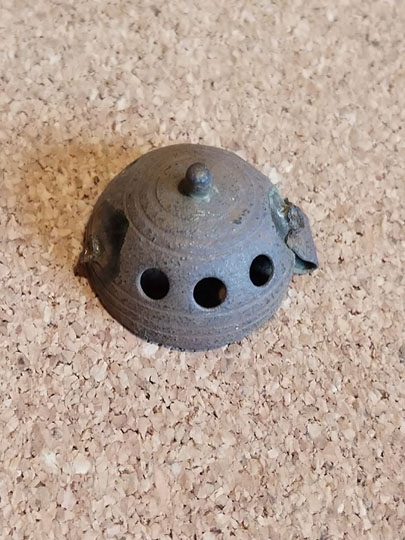
Although depicted frequently in surviving manuscripts, only two, now incomplete, English medieval candle lanterns are extant : each being in the Museum of London's collection. Generically, these lanterns were of simple form : serving only to provide a socket for a candle of small diameter and height, ease of carrying, and protection for the candle from being extinguished, whilst outside by wind or, when inside, by draughts. This Lid, being very small, finely made and knopped rather than having a suspension ring, is from a small, domestic Late Medieval Candle Lantern.
Whilst only the Lid of such Lantern, its design and condition are confirmatory of its identification as such. With its Lid cast from copper and being only 1" x 1/2", the Lantern will have had a foot perhaps only 3" in diameter and have narrowed progressively to its top. The seven relatively large apertures, enabling ventilation and escaping of heat, smoke and fumes, provide a reminder as to why an opening Lid was required at all : for without it the rapid build-up of soot within the roof would have been addressed with greater difficulty. The whole of the hinge and part of the clasp remain, and the decorative encircling scoring serves to suggest its former domestic use. From handling, a strong impression is formed as to the fundamental, minimalist approach used in meeting such a simple need : the total enclosure being little larger overall than the candle used within. This contrasts considerably with the aforementioned two much larger extant lanterns intended for use outside : each exuding practical robustness.
The Lid was recovered by a professional archaeologist from the site of an abandoned manor house in County Durham. Finding in such location invites a thought concerning the dearth of all candle lanterns. As they required use of a relatively expensive candle, rather than 'free' fat from cooking (as used in cressets and enclosed oil lamps), this resulted in candle lanterns not being used by those of modest means : and hence made and used much less extensively than the many surviving, atmospherically seductive period manuscript depictions of such would lead us to expect.The 'fitness for purpose' of simple candle lanterns should surely have resulted in widespread use : but for the reality of the relative cost of fuel for lighting.
Although almost trivially small, the Lid enhances a disappointingly barren academic record.

Since writing on the previous page that only two English medieval candle lanterns are extant, a third fragmentary (but still highly interesting) one is now recorded on the Portable Antiquities Scheme website and one has been recovered (and superbly well preserved) from the Mary Rose . With so few extant that are English and medieval, the known medieval one from Scandinavia and a Roman one from Britain also are worthy of note.
Whilst recovered by the same archaeologist as the Lantern Lid on the previous page, this is of earlier date and from Ireland. At a diameter of 2 1/8" and wrought from tin alloy, most fortunately the design, material, method of manufacture and extant condition enable secure identification as the Lid of a Candle Lantern.
The patina of the underside shows clearly the extent to which the Lid extended beyond the Lantern body. Inside the perimeter are the apertures for the four stanchions to join the top to the base, as can be seen on many period manuscripts that depict lanterns, and the smaller apertures enabled exhausting of smoke and fumes from combustion.
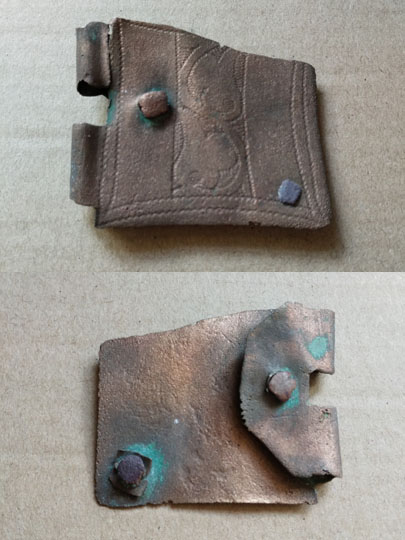
None of the apparently only four extant, highly evocative English medieval candle lanterns referred to on the two previous pages retains its door : although It should be noted that the design of the Mary Rose oak lantern did not incorporate one.
This 1 3/4" wide x (now) 1 1/2" high Door, made of wrought and chased copper sheet, is a rare survivor. Complete but for the fragment broken from the top, it might be the lower Door of two from a Lantern : and not the sole Door. Crucial to certainty of identification is the design and extant condition of the Door Catch : without which a rather insubstantial case could have been made that it is a buckle. Through the lower right hand corner of the panel was inserted a substantial pin that was peened at each end in order to retain it within the aperture pierced for it. Seen from the inside, a copper collar remains in place that ensures maintenance between it (as it interfaces with the panel) and the peened end of the pin. The form of 'catch' used to retain the Door in the closed position will have been slid over that part of the pin reserved therefor. Without this design and extant condition, of what is only a one-eighth of an inch-sized cuboid fitment, identification as a Lantern Door would have been unsound and unsafe.
The fineness of the making and the delicate, 'trailing vine' decoration of the central panel suggests that the former owner's projected date of the 14th century has merit.
Coming from the collection of the late Peter Crossley-Holland, the finder is recorded as being Ruth Morris : the surname being certain but the Christian name less so, other than in respect of the initial letter 'R'.

Recovered by an accredited Thames Mudlark, who wisely and most fortunately did not disturb its evolved surface, the nature, position and extent of deposit from frequent, albeit discontinued, combustion renders certain that it was the Door of a Candle Lantern.
Crudely made of lead, and measuring 3 1/2" x 2", it was hung from the top of the small Lantern either by inserting the flap on the back into an aperture between the body and the lid, by means of a pin hinge through the flap or, most likely, by simply placing it across the top and down the front of the Lantern : presuming the flap originally to have been at 90% to the Door. The Lantern will most probably have been made of (heat-resistant) iron or tin alloy. Although made of lead, as the Door was not left in place whilst the candle was burning, it provided robust handling practicality where resistance to heat was not required : other than for a short time.
Whilst some lanterns were glazed with glass or bone, others provided illumination only by opening of their door and through ventilation apertures with which their body and lid was pierced.
If it could be shown that this unusual, 'inelegant' design was intended to facilitate rapid, temporary concealment of light during hours of Curfew, it would enable dating of the Lantern between 1068 and 1103. As more lantern fragments are indentified, so understanding of the contexts and manner in which they were used might become less conjectural.
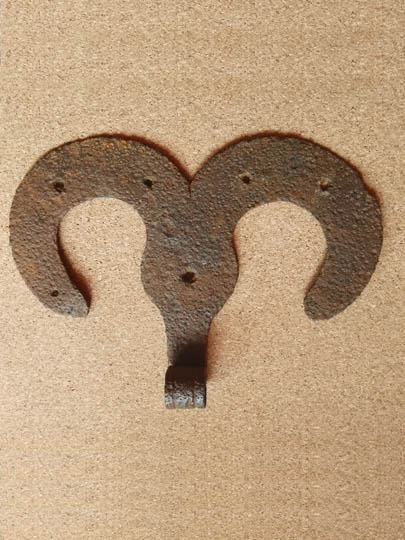
Recovered from Wiggin(g)ton in Staffordshire, that now has only irregular ground profiling to evidence its earlier, small medieval village forerunner, the Suspension Loop measuring 6 3/4 x 5" is made of iron. Although not formed from two purpose-made horseshoes, both its design and making evidence that it was made by a blacksmith : most probably for use within a stable. Fixed by one nail hammered into a ceiling beam, both that resultant positioning and the form of the Loop enable discounting of the possibility that, say, clothing, riding equipment or keys were suspended from it.
As apparently only two English medieval lanterns have survived, albeit somewhat tendentiously this serves as a reminder thereof.
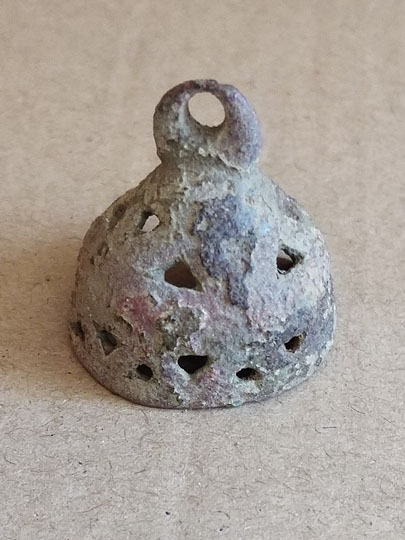
The Cover, one inch in height and width, was wrought from tin alloy in a manner requiring considerable expertise. Beaten to its hemispherical shape over a former, the apertures were then punched out. Particularly challenging was the making of the suspension loop that also was fabricated and not cast. A part of the skirt, when fractured in antiquity, fell to form a small, (later) congealed mass inside the upturned top. Most fortunately, the non-central positioning of that mass enables confirmation that there had not been anything attached from the centre : as would have been a bell clapper. Also, one discernible small element of that mass is a pin : indicating the original presence of a hinge attached to the skirt where now displaced.
Most extant medieval censers are much larger than was the censer of which this Cover was a part. Also, they were used for distributing the aroma of incense by being swung, by hand, from chains : whereas this small Censer, not untypically, will have been placed and remained static. During use, grains of incense were spooned onto burning charcoal in order to produce the aroma. It is most likely that charcoal was placed within this Censer by opening its upper half in the hinged mid-position, and that incense was applied later to the surface of the burning charcoal by raising only the hinged Cover of that upper half. It is pertinent to note that red staining specifically, as seen in the picture, is known to result from contamination caused by burning incense. (With thanks to PR, ex-monastery, ex-MOL, for this first-hand insight).
The Cover was acquired from the finder : who had recovered it from "either Fincham or Shouldham, West Norfolk". Many artefacts have been recovered from the former location of the Gilbertine Priory in Shouldham and that such an object came from the Priory is probably unarguable.
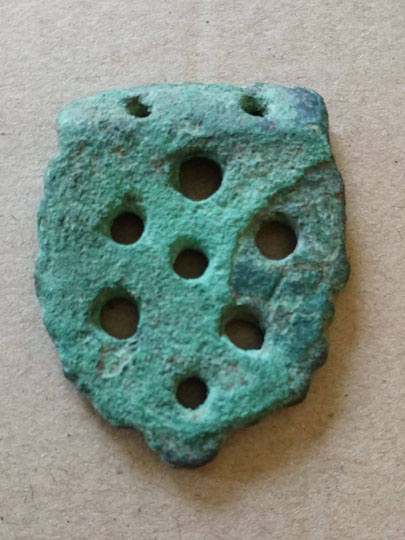
Although of a different design than that on the previous page, this also is the Lid of a static Censer. Made of copper alloy and measuring 1 5/8 x 1 1/4", the 1/4" deep angled top edge has two finely drilled holes for wires that formed a simple hinge. It is fortunate that aspects of its making enable the two other possible uses of a strap end or the lid of a lantern each to be determined as impracticable.
Unfortunately, no more precise provenance is known other than of it having been found in Yorkshire by a known prolific detectorist : it however being plausible to suggest that it came from a monastic site.
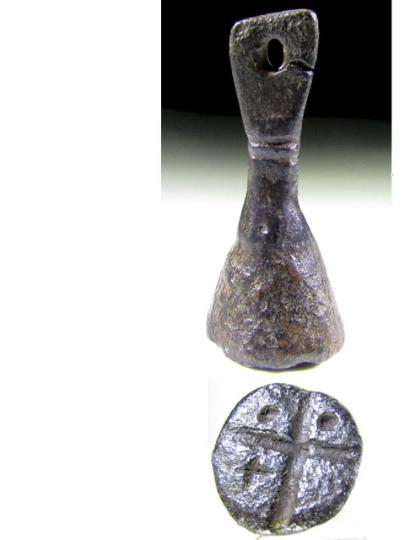
At first sight, whilst this is clearly medieval, it appears to be an unexceptional 'chess piece' type of seal. Made of copper alloy ( bronze ), It is one and a quarter inches high with a 'base' diameter of half an inch. From handling, two things can clearly be discerned ; it has been sculpted with care to mate very closely with thumb and finger when in use ; the extent of its patination shows the extent of use to well exceed that expected of a personal seal.
So, what is it? It is a bread stamp used for marking the Host prior to consecration for the Mass. The Christian cross has another in the true lower right quadrant and 'points' in each of the upper quadrants : the lower cross denoting the Virgin Mary and the 'points' representing the sun and moon as depicted in such manner in at least one thirteenth century manuscript. In view of the extent of its use, it most probably was suspended by a lanyard around the neck of a monk for frequent use in stamping, prior to baking, the Host of a size known to have been used, albeit not invariably, in the monasteries. It is improbable that such frequent use as evidenced would have occurred in secular ( ie. not monastic ) contexts.
May there be other early medieval bread stamps, presently unrecognised, in seal collections?
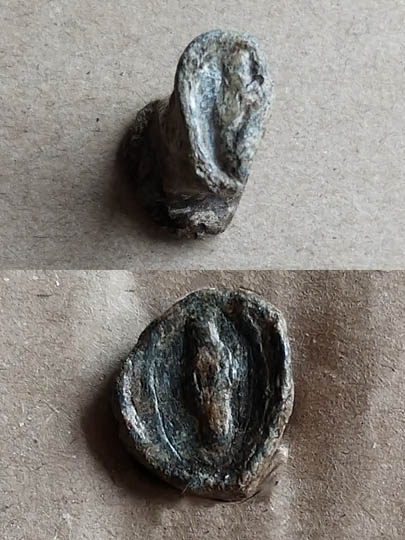
As with the Monastic Bread Stamp on the previous page, although this also appears to be a seal matrix, its purpose similarly was for impressing the Host used in Celebration of The Mass.
Made of silver and measuring 1 x 1/2 x 5/8", it locates effectively between thumb and finger to enable stamping of the images at each end. One is of St. Cuthbert holding the head of St. Oswald, that refers to the finding of Oswald's head in Cuthbert's Shrine on transfer in 1104 to the then new, now present, Durham Cathedral building : as depicted in a carving at Durham and in the Minster's St. Cuthbert Window. The second image, at the smaller end of the Stamp, depicts crowned King Oswald.
This was found in 1972, by an archaeologist working within York's Pretoria Precinct : in a part of which the Minster is located. The thin but somewhat concealing layer of later, adhered material requires that the images be viewed through a jeweller's loup to be fully recognisable.

Early stools continue to be appreciated and sought after by collectors. Added to this, triangular furniture of any type and from any period has its own aesthetic attraction and appeal. Conjoin these and you have a piece of furniture of a type of exceptional interest.
A stool such as this from the sixteenth century could be viewed as being medieval or renaissance. We would consider whether a design looks backwards to the Medieval period or forwards to the English Renaissance : itself later than on the Continent. This 23" high oak stool straddles the periods, evidencing medieval austerity in form and manufacture but with three elegant frieze panels very much in Renaissance style.
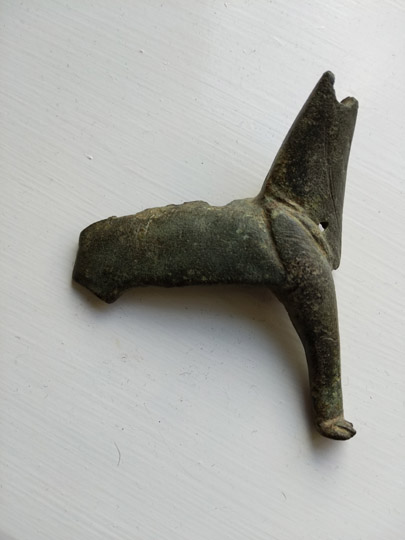
Physically displayed amongst the Collection, the young Red Deer has habitually been passed by for inclusion here. Finally given sanctuary, he now occupies his deserved place : despite incompleteness which caused him to be precluded hereto.
Offered for sale as a horse, he would have been unique for reason of a cloven foot and his roaring stance. Surprisingly, in view of the place which deer occupied in the lives of many during the medieval period, very few figures of English medieval deer are to be seen : despite there being many extant from other countries and other periods.
At first he looks to be seriously incomplete but is, in fact, less so. His forequarters and head are complete : displaying his stance to roar. He has not had antlers and hence is complete also in that respect. The rear leg and his left side have been torn away : presumably by the unseeing plough.
What is of merit is his stance, colour and texture, size at 21/2"x21/2" and unquestionable Englishness.
For someone who has lived surrounded by Red Deer, he provides an atmospheric reminder of country life both medieval and recent.
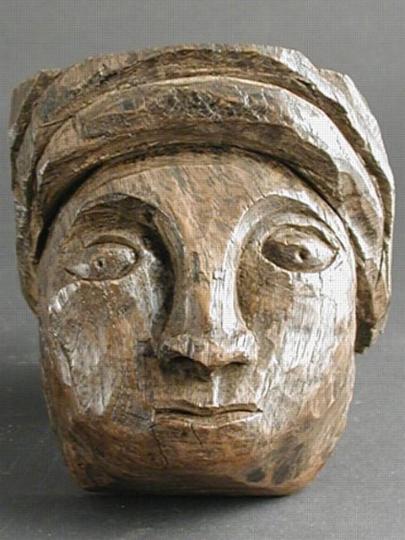
This rather harsh image resulting from over-cleaning is unhelpful in aiding recognition that this carving is from the thirteenth century. Made from very dense, early 'constructional' oak, it has surfaces not in view which are knarled and patinated in conformity with it's age.
Known with confidence to have been removed from the upper roof timbers of a thirteenth century Dorset manor house into which it was pegged, there is a suggestion, not least from the headgear, that one of the carpenters responsible for that structure left this image of himself in graffitiesque manner.
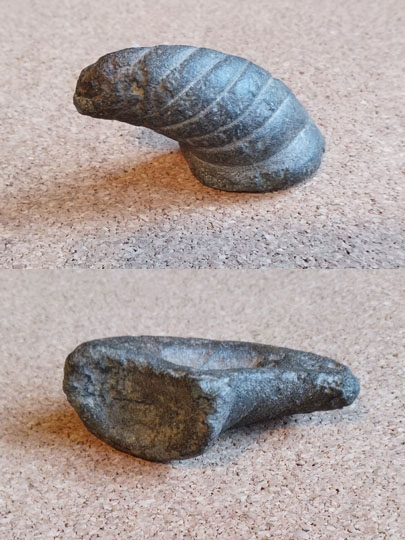
For those unaware of such objects, consideration of this one would ideally commence with reading of the detailed work on the subject published by the British Museum in 2004. There depicted and described are the two-part, canoe-shaped pestles and mortars that were used for grinding powdered substances for use in face and body decoration.They are known to be Celtic but also to have been used during the Roman period : most typically, if not solely, in Britain. Verging on folklore is their use by the Celts for the making of (blue) Woad with which they decorated their bodies.
As can be seen from the photographs, this is a tactile object. Made of copper alloy, weighing a heavy 3 1/2ozs and measuring 2 3/8" x 1 1/4" x 3/4", it fits the hand for use so that there is no room for doubt as to how it was held. With thumb/finger holds on each end of the same side, it was held sometimes with the indentations facing the user and at other times with them facing away. This perception is rendered certain from the wear and patination : as well as from confirmatory handling. The elegance of this design has produced, in one simple casting, an item both attractive for display and of functionally efficient merit.
By comparison with other such objects recorded, this one differs in two respects : it has been formed, in an overtly obvious manner, to enable holding and it was designed for freestanding display as shown in the uppermost photograph. When so standing, it clearly can be seen to represent a Cornucopia : a 'Horn of Plenty'.
Perhaps one other difference should be considered. With no evidence of erosion due to use of a pestle, and as it so clearly was made for holding during use, maybe this was used to hold material during its application and not for making of that material. That is why the word Grinder has been italicised in the heading. Furthermore, close observation and handling of it induces the feeling that it is neither Celtic nor Romano-British but Medieval.

Seen in close proximity and in a domestic context, medieval glass loses the compositional grandeur of it's former position but takes on an undoubted gentle charm.
Sensitive, simple design, subtle colouring and the varying texture of early glass can be seen and appreciated in such near view.
This piece of fifteenth century painted glass from Norwich is now surrounded by plain glass of the period. Even such modest figurative glass is seen infrequently.
This unusual depiction, rather than against a plain background, has been chosen in order to aid and increase appreciation of early glass as a domestic art form.
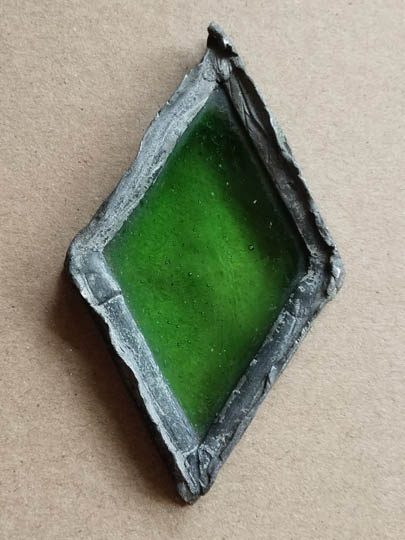
Anglo-Saxon Holy Trinity, Mickelgate, York was one of the five major Northern English churches (including York Minster) recorded in the Domesday Book of 1086. In 1089, it was extended and re-founded as a Benedictine Priory.
In the collection of a York-based archaeologist since 1965, the Glass was acquired during restoration of the Priory at that time. One form of Norman glass entailed use of flat-sided, rectangular, bottle-like moulds into which glass was blown to make small, flat sheets that then were cut to be leaded. The physical characteristics of this and other examples of surviving Norman, so-called 'slab glass' are distinctively confirmatory of dating to the period.
Measuring 3 x 1 3/4" including leading, although without the anthropomorphic decoration of the Norwich Glass on the previous page, its colour, texture and simplicity reflect the monastic aesthetic of the period.
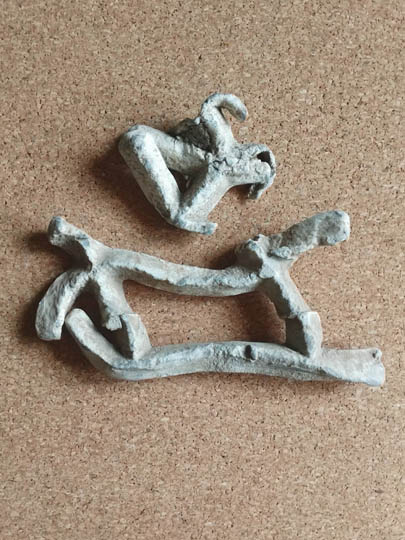
The simple modesty of these fragments belies their provenance. The first monastery on the small tidal 'Holy Island' of Lindisfarne, adjacent to the Northumberland coast, was established by St. Aidan in 634, and the Island has remained a major focal point of Christian Faith and pilgrimage ever since. The life of St. Cuthbert during the seventh century and the first attacks by Vikings in 793 are just two elements of Lindisfarne's well-recorded history.
Most fortunately, the form of these two fragments enable dating to the earliest times of monastic occupation as they are not 'cames' used to surround elements of window glass but leading used within unglazed window frames in order to inhibit access by birds. The larger fragment measures approximately 4 x 2", and the small one has been compressed so as now to be approximately 1 1/2" square. Notable is that even the smallest of birds could not have squeezed through this aperture : whether or not re-formed to a precise rectangle.
As with some other items in the Collection, this was recovered during the 1980's by the archaeologist Gordon Hardcastle.
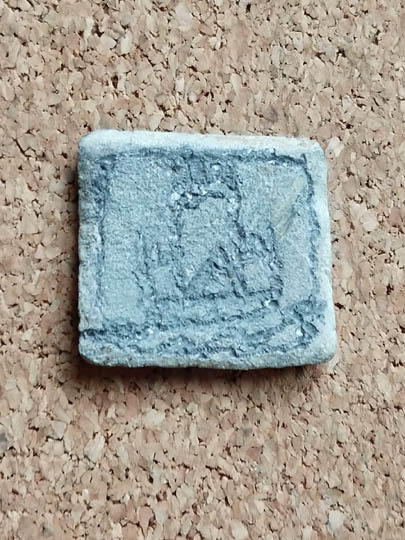
Devoid of its provenance, this would be locationally, albeit not functionally, unidentifiable : one of many undatable, commonplace game pieces in lead. Found by an archaeologist during the 1980's, it was recovered from the coast immediately adjacent to the Castle. As can be seen online, the stone outcrop from which the Castle dominates the landscape provides a rich subject for ground-based or aerial photographers : some of their pictures enabling identification of the Castle Keep as depicted on the Piece.
Measuring 3/4 x 13/16" and made with others from a sheet of lead cut at a 45% angle on each side that enabled lifting during use without difficulty, adjacent pieces will have been decorated on their resultant larger upper side. Viewed from ground level on the landward side, that perspective shows the two round curtain wall towers flanking the Keep : it being further identifiable from the central, vertical garderobe shute with its highly distinctive V-shaped roof. The seeming irregularity of the top of each tower and of the Keep is explained by their upper structures when viewed from ground level. Despite the crudity of this overall depiction, the correlation of such distinctive architecture, as drawn and in actuality, provides reassuring certainty of provenance.

Unlike the Game Piece on the previous page that depicts the West Face of Bamburgh Castle Keep, the upper Piece shows a plan view of the Castle. Whilst depicted representationally, the Castle is rendered identifiable by its unique, distinctive form : and by its positional relationship with the surrounding land and sea. The lower Piece, in a less discernable manner, appears to depict the Jarlshof Settlement, Sumburgh, Shetland. Each Piece is made of silver and approximately 1/2" in diameter. Obscurely wrought though they are, their conception, design and making in silver show in what esteem was held the playing of board games : and the sometimes emotional significance of pieces used in such play.
Bamburgh Castle was the Anglo-Saxon King of Northumbria's Capital, until a successful attack by the Vikings in 993 : who then were in control between 993 and 1066. The finding of the Pieces during the 1970's at the site of the 1066 Battle of Fulford (half a mile from York) between the Viking King Harald and the Anglo-Saxon Northern Earls indicates that its owner is likely to have been based in the Castle. Only five days following his victory at Fulford, Harald was defeated in the Battle of Stamford Bridge (six miles from York) by the English King Harold : who himself was defeated by the Norman William the Conqueror in the Battle of Hastings only nineteen days thereafter. The Castle then came under the control of the Normans.
Although the Settlement of Jarlshof in Shetland was occupied and controlled by the Vikings, much remains of its original, prehistoric structures : the ovoid 'wheelhouses' being evidenced in the Game Piece.
It is recorded that Harald, upon arrival from Norway, had gathered additional Viking support from the Shetlands and Orkneys : presumably also from the Viking garrison at Bamburgh. Viking depiction of a site map on a game piece is unusual, but not unparalleled. There is one in the Collection that depicts a plan view of the Vikings' second Winter Camp in Repton, Derbyshire and another (albeit Norman) depicting Berkeley Castle, Gloucestershire.

Edmund was killed in 869 whilst resisting the Viking Great Army that had over-wintered in Thetford, Norfolk. He was canonised in the third or fourth decade of the tenth century, and in the eighth decade a 'Passion of St. Edmund' was written at Ramsey Abbey in celebration of his life and martyrdom at the hands of the Vikings. Whilst written in Latin, this soon was translated into Old English in order to aid dissemination. Figuring strongly in the 'Passion' was an allusion to the hedgehog : reflecting the means of Edmund's killing by many arrows/darts penetrating his body. Although perhaps merging fact with symbolic fiction, other comparisons between Edmund and hedgehogs were made within the 'Passion'.
The 2 x 1 1/4 x 1 1/4" figure is made of antler and now lacks one leg : with one other (original) re-attached in recent times. An extant three-dimensional hedgehog from the period is most unusual and probably explained by it having been made as an allusion to Edmund. Whether Anglo-Saxon and celebrating Edmund's life or Viking and deriding him, it appears much more likely to have been Viking-made.
Found in a foul drainage system in Hungate, central York, the Hedgehog was dried during a protracted period by an experienced conservator : the location of finding perhaps symbolic of the disposer's affront to Edmund.
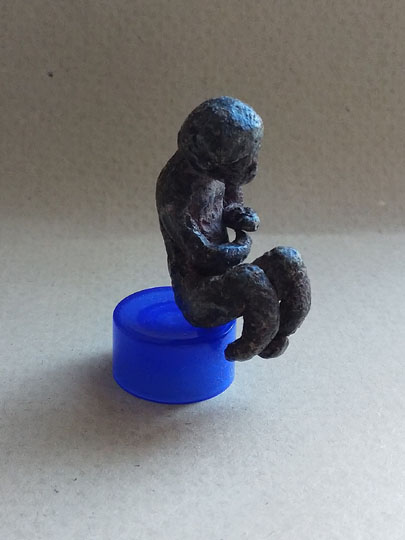
In 2005, a self-effacingly modest, but actually impressively authoritative, record was published of the then known group of sixteen copper-alloy 'Roman bound captive' figures : ten of which are from Britain and six from Mainland Europe. Whilst tempting to consider and make comment upon this figure to show affinity with that group, to do so would be to ignore material differences between it and them.
From the collection of an extensively published American Professor of Anthropology, archaeologist and collector, he came from the landscape-dominating Neolithic and later Iron Age Hillfort of Maiden Castle in Dorset : disputedly the site of a decisive battle in 43 AD between the Britain-defending Celts and the Romans invading for the third (then successful) time.
Wrought from lead and measuring 1 3/4"x 1" x 3/4", the figure clearly is of a subjugated Celt but not overtly of a slave or even of a captive. The material of manufacture, deportment and absence of the unexplained and highly distinctive horizontal and sometimes additionally vertical traversing 'holes' in all but one of the aforementioned sixteen, distinguish it in a fundamentally significant manner.
During decades of archaeological investigation of the Maiden Castle site, the extent of the Celts' metal-working skills and extensive use of the site partially for that purpose was revealed. He may have been made by a Celt pre-43 AD, now providing evidence of internecine rivalry, or have been made later by a Roman in different form to, but with the same purpose as, the sixteen, to signify and celebrate dominance over the Celts. There also is the possibility, if this is of Celtic manufacture and was representative of other such figures, that the Romans later adopted and adapted this generic form as (shortly) later implemented in the group of extant 'Roman bound captives'. Whilst the Celts perhaps were displaying (in this and other like figures at least) tribal dominance in a non-captive/enslaving manner, the Romans may have aped opportunistically the Celts' own cultural practise : 'enhanced' to display unquestionable capture if not certain slavery of the defeated Celts. One other possibility needs to be considered : that the figure was produced by an Anglo-Saxon during their post-Roman period rivalry with the still-surviving Celts. This, however, is most unlikely, as Maiden Castle was, according to Bede, abandoned prior to or little later than the arrival of the first of the Anglo-Saxons in 439 AD. Hence, how would an Anglo-Saxon figure have been recovered from a site never occupied by them?
From the form, style and standards of manufacture of surviving Celtic, Roman and Anglo-Saxon material, it could be considered that he displays Celtic or Anglo-Saxon sensitivity, but conversely does not display Roman formulism. Also, that he falls well short of Roman or Anglo-Saxon standards of making. Perhaps to recognise him as most likely a Celtic artist's representation of their own condition at the time of making would be most sound.
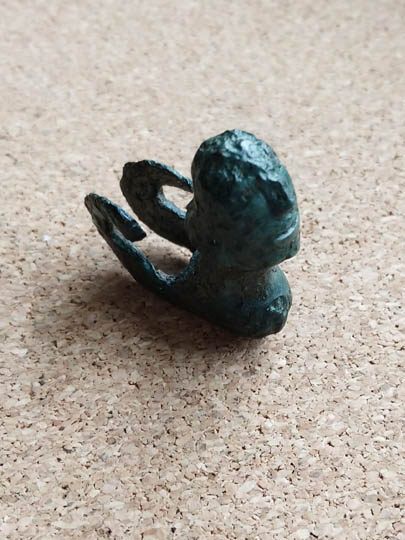
Excepting the formulaic 'horse and rider' figures extant in surprisingly large numbers (albeit with many riders incongruously astride now absent horses), few Celtic anthropomorphic figures from Britain appear either to have been made or to have survived.
Cast and wrought from copper alloy, this seemingly inexplicably complex figure found on the Lincolnshire/Norfolk border stands 1 1/2" high and deep, with a width of 1/2". Unlike the empathetic figure from Maiden Castle on the previous page, he projects aloofly confidence. That said, when these dissimilar figures are placed together, their textural aesthetic similarity confirms most convincingly that they come from the same period.
Whilst a complete entity with no evidence of breakage, almost certainly he was a component connected by means of the dual upward-curving, tail-like projections. As these both also curl downwards and narrow towards the back, that they enabled maintenance of connection with something else is well-evidenced. Alternatively, it is possible that he was connected by strapping or cord encircling the pronounced groove below his head and (separately) fed between the curls behind his head : each applying opposing pressure. He appears to represent both Man and Beast in Sphinx-like manner : far removed both geographically and in scale from, but incongruously reminiscent of, Egypt's monumental sculpture.
By reason of design, scale and substance, this must have been a decorative and not a functional element : albeit attached to a larger component which could have been primarily functional or decorative. It is notable that patination in many parts confirms the figure to have been handled frequently and to have been regularly moved over a flat surface : so rendering shiny the underside of the front half. One likely positioning, which would match with each aspect of design and patination, would have been if laid longitudinally along a leather strap of sufficient width.
Unsurprisingly, no parallel appears to be known : although claims of uniqueness should always be viewed with caution.
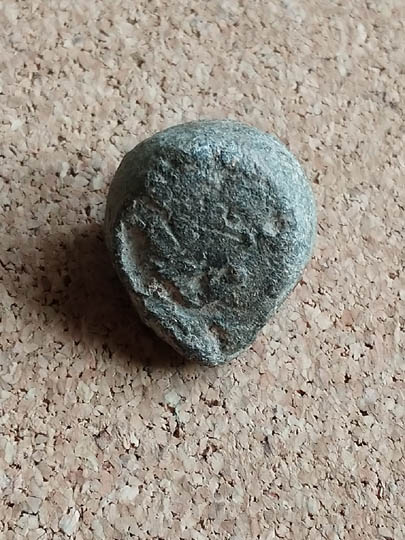
Druids were the learned, priestly (perhaps also the ruling) class of the Celts. Whilst Celtic tribes were widely distributed around Europe, at least during the early Romano-British period the island of Anglesey, off the North coast of Wales, is considered to have been the Druids' heartland. In (approximately) AD 57 the Romans attacked and massacred them on the Island.
As with other Druidic artefacts, very few heads remain : but sufficient to have established a recognised group identity. Made from a wrought and incised ingot of copper, it is about 3/4" cubed and weighs 1 1/8 ounces. Although the face now is somewhat obscure, it is undamaged and in good order. At so small a size, it perhaps is unlikely to have attracted the attention of a Roman looter : but not if originally attached to, or incorporated within, something of more appealing size and design.
The Head was excavated in Beaumaris, Anglesey during the 1960's by the prolific archaeologist Gordon Hardcastle. Notable is that Anglesey is considered to have had the largest copper mine in the World during the Celtic period : the material, mined since the Bronze Age, having erupted from an ancient volcano on the Island.
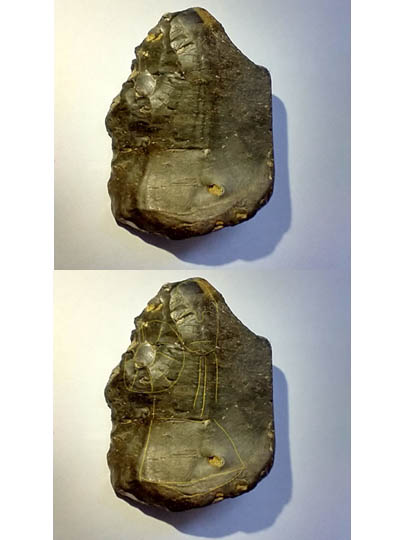
An unusual survivor from the Bronze Age as it is anthropomorphic, the Warrior was acquired from the finder who recovered it in 2006 from the hamlet of Catlow, Lancashire : the Bronze Age occupation, archaeological and artefactual remains of which are known and recorded online.
Carved on a Pebble of Chert and measuring 1 1/2 x 1 1/4 x 1/2", recognition of the image is aided by the finder (C.D's) overlaid drawing.
Without sociological references, determination of the function or role of the Carving can be no more than conjectural.
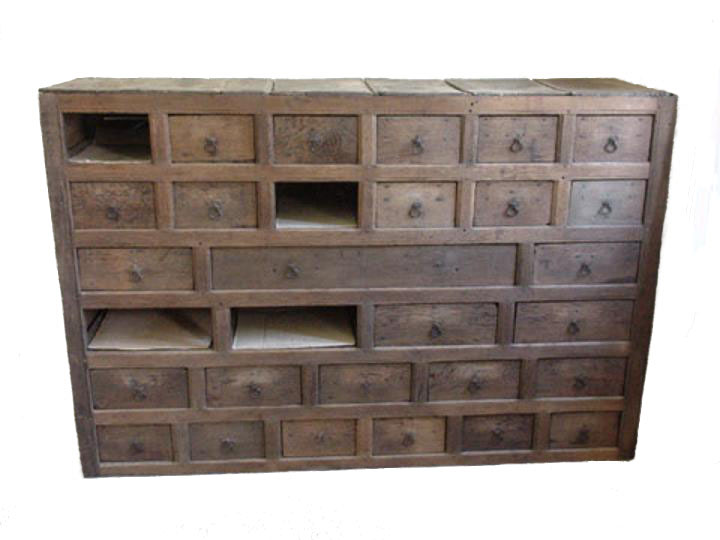
Made of oak and measuring just short of 6 feet in length, 4 feet in height and 11/2 feet in depth, this fifteenth century chest was used to store manuscripts. The nails remaining in the front of each drawer will have retained in place labels, possibly of vellum, to denote the contents. Additionally, names written in large black-inked script on the sides of drawers also provided identification information : there being some still present which were 'pricked out' prior to being infilled with ink. Some pools of red sealing wax remain in drawers. It is unlikely that there will have been both leather thongs and iron handles on each drawer. What is certain however is that there were leather thongs originally and that the present handles are of a similar date to the chest.
Just three other such manuscript chests remain which are in the Muniment Room of Winchester College, The Vicar's Choral of Wells Cathedral and the ( first floor ) Aerary Porch of St. George's Chapel, Windsor Castle : each a highly protected environment.
The temptation to have drawers made to replace the four which are missing has been resisted and the corrugated cardboard 'dust protectors' are from the early twenty-first century.

The common denominator between the Chest on the previous page and this object is that of manuscripts.
Prior to the making/use of paper, the pages of books were made by use of parchment: one form of which was vellum. Whilst these words have now become interchangeable, the difference between the skins used in the making of parchment reflected in medieval usage of the appropriate word for the applicable material: parchment being generic and vellum being skin-type specific.
Whilst completely safe to say that this was used either as a page marker or to hang pages for drying following writing in inks and maybe decorating with paints, it would be without foundation to say which of these specifically was its purpose. It is of course possible that it was used for each of these at different times.
Made of copper alloy, in perfect condition and measuring 2" in length and 3/4" maximum in width, this from Silfield in Norfolk is one of three such of closely similar design and decoration in the Collection. The other two are shown on the following page.
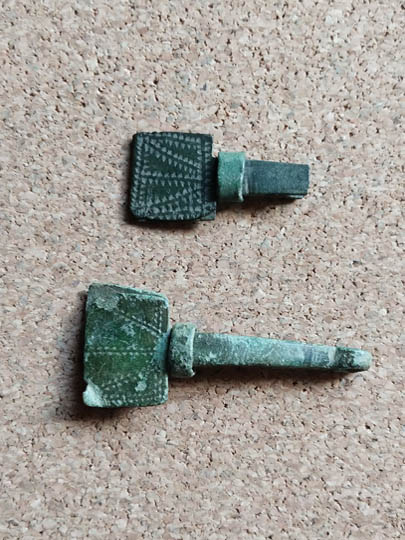
Closely similar to that on the previous page, these are from Wiveton in Norfolk and next to Berkeley Castle in Gloucestershire. Each is made of copper alloy and, whilst in much poorer condition than that shown previously, do tell the story of their like use.
The certain, known locations in which these three were found give rise to significantly interesting questions. Firstly, were these made by one workshop/hand and distributed widely or was there a 'traditional style' for such things which resulted in making and survival in different parts of England? Secondly, was there any relationship between the Berkeley Anglo-Saxon monastic establishment (there being certain evidence of such being immediately next to Berkeley Castle) and possibly other such institutions in the two Norfolk locations? Thirdly, what can be deduced from the finding of both Anglo-Saxon and medieval Markers in Berkeley (see the former shown on the second page hereafter)? Seemingly, much ongoing work has been undertaken in Berkeley by Bristol University and, with the motivator and leader of that task still engaged, there is hope that the finding of each of these small objects may provide modest assistance in further understanding of the large-scale Berkeley project.
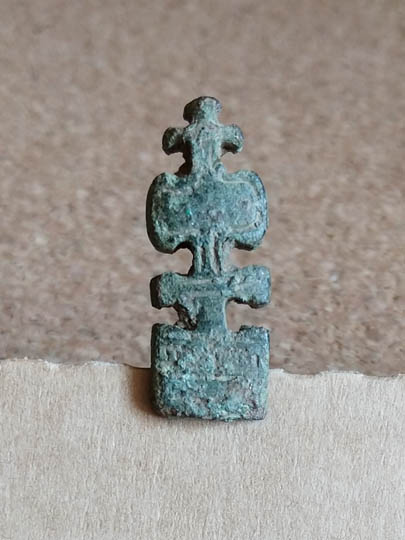
Whilst the 'Markers' on the previous two pages most probably were used for hanging newly-written/decorated manuscripts to enable drying of the inks and paints used in their making, this Marker was used solely to temporarily denote a page to enable efficient and timely reference thereto.
Although dating from before the Norman Conquest, both this marker and that on the following page held such appeal as to strongly justify inclusion within the Collection.
Made of copper alloy and measuring 15/16ths." x 5/16ths." x 3/16ths." it is complete and undamaged. Unlike as in the photograph, this will have been placed over the side (not top) edge of a page but clearly, because of its intrusion, will have been left in place for just the short time needed for purpose. Whilst next to impossible to show photographically, each internal face of the slot into which the page was fed has a slight but pronounced full-width, horizontal protrusion which enables undamaging but secure holding of that page. The form of the surmounting cross is confirmatory of period.
The marker was found in the 1970's in a Northumberland coastal field adjacent to the Holy Island of Lindisfarne. This is not hearsay but is confirmed by the son of the archaeologist finder who gathered and bequeathed to his son a collection of museum scale. With commendable insight, he had correctly identified the purpose of this seemingly obscure object : not least of which by not defaulting to seeing it to be a ubiquitous 'strap end'.
On the following page is a second Anglo-Saxon page marker and a continuation of text.

Smaller than the marker on the previous page at 5/8ths" x 3/8ths." x 1/4", this also is made of copper alloy and served the same purpose. Whilst not identical in design, the close similarity between the two suggests that, despite others appearing not to be known, there may have been a generally typical form for markers of the period. Undamaged and complete, except that the upper part has been broken off, it may be that this also was surmounted by a cross.
Similar though they are, their find locations were on opposite sides and ends of England. Found by, and now acquired from, a long-experienced searcher in 1990, it came from a field immediately adjacent to the walls of Berkeley Castle in Gloucestershire. Being searched with formal permission, the field yielded much Anglo-Saxon and medieval material but nothing which was Roman. Then taken to Gloucestershire Museum in Bristol ( it being the invariable habit of the finder to take everything found to either Cardiff or Bristol Museum ) it was declared to be a 'small dagger pommel' and has carried that identity until now : criticism of which is not to be inferred.
The history, early building, unique 850-year continuous occupancy by one family and important collection of early furniture and artefacts of Berkeley Castle can be studied online with perhaps their most important possession being a 6,000 manuscript Archive.
Having heard from the finder that the Marker was discovered "within throwing distance of the walls" and on learning of the Archive of manuscripts, the possible relationship between the two became of particular interest. There is however, a mismatch of date : Anglo-Saxon Page Marker but almost exclusively medieval manuscripts. This however has now been resolved as it has been learned that Bristol Museum, who have searched the fields adjacent to the walls of the Castle, have discovered there the site of an Anglo-Saxon monastery.
Why closely similar Page Markers were waiting to be found adjacent to Lindisfarne and to Berkeley Castle is cause for conjecture : as is also the apparent dearth of extant Anglo-Saxon page markers from anywhere in England.
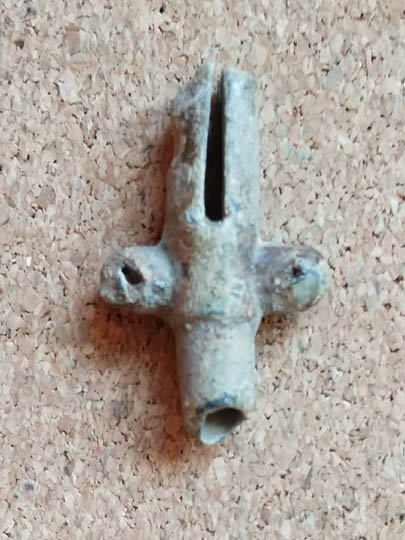
Made of lead and measuring 1 1/2 x 3/4", the Wipe is complete except for very small sections of the domed top and bottom now lost. D-formed with a flat back, when pinned immediately below the side of a writing desk by its two apertures, the Wipe enabled the drawing of quills horizontally through its upstanding slot in order to clean them of ink.
Found during the early 1970's by the archaeologist Gordon Hardcastle on the foreshore adjacent to the tidal land-bridge to Lindisfarne, aesthetic triviality will have rendered it undesirable to the marauding Vikings who sacked the Priory. Even as a piece of base metal, its low weight will have contributed to it being ignored : and therefore having survived.
It is thought that there were no more than ten monks concurrently at Lindisfarne : although that they rotated with brethren from Durham on a two or three year cycle. The Lindisfarne Gospels were, most unusually for a large work, written by just one monk : Eadfrith, Bishop of Lindisfarne. As probably few of the ten will have been scribes, it is not beyond reason to envisage the Wipe having been used by Eadfrith whilst writing the Gospels.
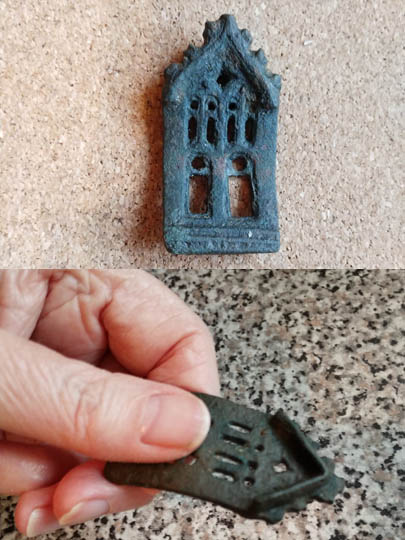
The present Ripon Cathedral is in its (arguably) fifth iteration on the same site. In 672, St. Wilfrid established the first Anglo-Saxon monastery there in stone : so replacing its forerunner from 660 built of timber. His building was wrecked circa 875 by Eadred's Vikings and, following restoration, was burned to the ground circa 948. It then was rebuilt following 972, but was destroyed in 1069 : making way for the Norman building of 1080. This also was replaced in 1180, to finally result in the present (later much-modified) Cathedral. Throughout these events of destruction and replacement, the Crypt originally made as a freestanding, self-sufficient entity beneath the East End of Wilfrid's 672 building has remained intact : being recognised as the earliest English surviving structure used for worship.
The Pen Wipe made of copper alloy, measures 2 x 1", is complete, undamaged, and fully retains its evolved patina. Recovered from the confluence of the Laver and Skell tributaries of the River Ure that are close to the Cathedral, it depicts a view of the East End, above the level of the solid wall behind the Altar, of Wilfrid's Minster of 672. The triangular window head and single lancets are typical of the Anglo-Saxon period : being not unlike the tracery of the disused Pulpit remaining in the Cathedral. The Wipe appears to be a sole survivor in any form or material that depicts Wilfred's monastery. Perhaps its publishing might lead to finding or identification of a manuscript depicting the whole Minster at its inception.
Prior to moving to Ripon, Wilfrid was a monk at Lindisfarne : source of Eadfrith's Lindisfarne Gospels. So few were the monks at Lindisfarne and so high the status of their scriptoral activities, it seems likely that Wilfrid was steeped in that tradition. To find a Quill Pen Wipe used during the writing of manuscripts that depicts the Monastery commissioned by Wilfrid does suggest it having been used by him : as with the suggestion made on the previous page concerning Eadfrith's use of that Pen Wipe in writing the Lindisfarne Gospels. Held between thumb and finger, with the upper half of the Wipe curling downwards, the quill in the other hand was drawn across the upstanding V on the back : and perhaps sometimes drawn between the crockets along the top.
If this was owned and used by St. Wilfrid, it would have emotively drawn together his writing : and his Monastery.
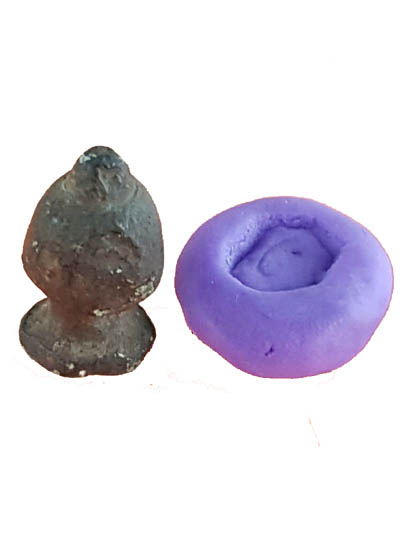
Reading of the previous page concerning Ripon Minster and St. Wilfrid would assist in understanding the Host Stamp in context.
The Stamp, found during the 1980s in an allotment close to Ripon Minster, is in the form of an acorn signifying immortality through rebirth. Measuring 1 x 1/2", Its flat back aided orientation when being used to impress the Host Bread with an image of the head of a sheep : this affecting an apparently by then-traditional allusion to Wilfrid.
As Wilfrid died in 709, the Stamp probably dates between 672 and 709 but, If made and used in memory of him, a later date would pertain. The modest simplicity of the Stamp does however favour the former proposition : and date. If to be used post-mortem, the making of an altogether more ambitious stamp would have been more likely.
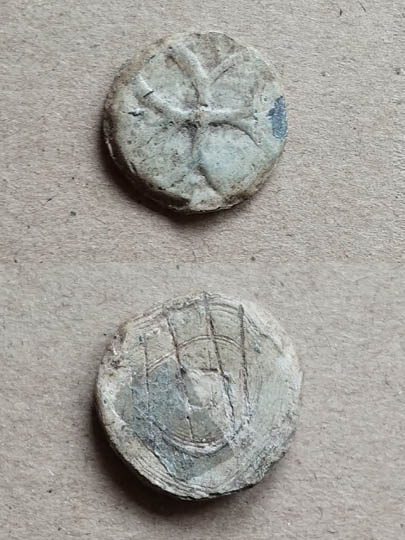
Of the two game pieces in the Collection that originate from the site of the monastery immediately adjacent to the Castle walls, one is a beaded 'second canon' piece that is not here recorded, but this one merits being highlighted.
Made of heavily gilded lead and 3/4" in diameter, a mould in the form of a Cross Fourchee was impressed into the obverse and, either following cooling or later, a simple plan of the Castle was incised into the gilding of the reverse. This depicts the Castle with its series of encircling walls : as can be seen in the short aerial video on the Castle's homepage to be still remaining. Across that incised decoration are four vertical incised lines but whether this has been done to decry affinity with the Castle, or simply to provide a numbered game piece, is undeterminable.
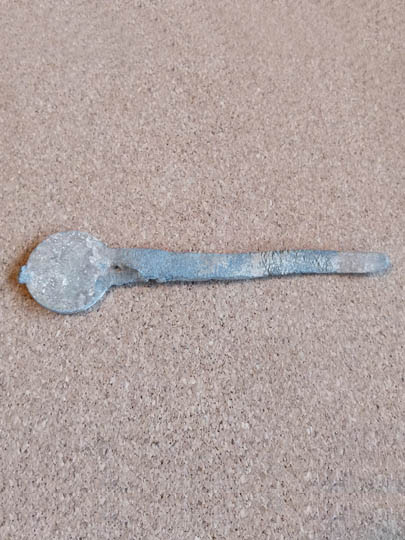
Gunner's picks were used in order to clear the vent in the cannon's upper face and, by accessing through that vent, to pierce into the centre of the bag of gunpowder that had been loaded and rammed via the muzzle : thence followed by the ball. The gunner then filled the vent with powder from a flask and this was ignited : thereby igniting the powder in the bag and expelling the ball projectile.
Made of wrought lead and measuring 5" x 1" (maximum), the traditionally-shaped roundel aided handling, and ensured that the Pick could not be dropped into the barrel. It is likely that this also served as a vent cover when the cannon was not in use.
As with the items from Berkeley on other pages, this has come directly from the finder : who was active with permission of the owner during the 1970's. Subsequent to this, and during a number of years, Bristol University's Archaeological Department undertook protracted archaeological investigation, study and recording of the (broader) site.
Even encompassing the Royal Armouries Collection, there appear to be no recorded extant examples from any part of the medieval period.

Evidencing diversity of design and making by comparison with markers on previous pages, this one makes some aesthetic sacrifices for practicality of manufacture.
Made of copper alloy and 1 1/8" long, robustness has aided its survival in complete good order.
As is the case with one of the game pieces in the Collection, this has come from Felixstowe, Suffolk : similarly inviting attribution of provenance to Felixstowe Abbey.

Whilst functionally identical to the Markers on earlier pages, self evidently this one is in a materially different aesthetic style.
Made also of copper alloy, it is 1 1/4" long and decorated with inset enamelling both front and back : in a form indicating that it predates all five Markers on preceding pages.
Found in Stanley, West Yorkshire, some four miles from Nostell Priory, a link between the Marker and Nostell is not mooted but, most assuredly, it did originate from a monastery of high status.
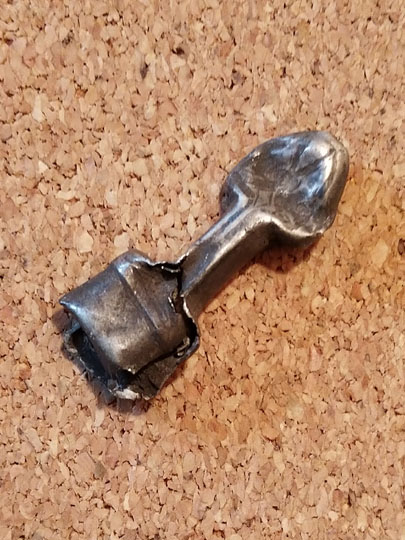
Found with the Marker on the previous but three page, both its design and making in Silver project its high status : but fall short comparatively on aesthetic appeal.
1 1/8" long and obviously damaged in antiquity, its handle retains clearly visible, comprehensive, non-figurative decoration on one side. Unlike the other Markers in the Collection, it is likely that the slot for fitting over the edge of the manuscript was padded internally on each side with thin, soft material in order to protect the page.
It is interesting to see items from the same monastery that are of similar period and function but of dissimilar status : most particularly recognising Lindisfarne to perhaps be the most important monastic site in England.
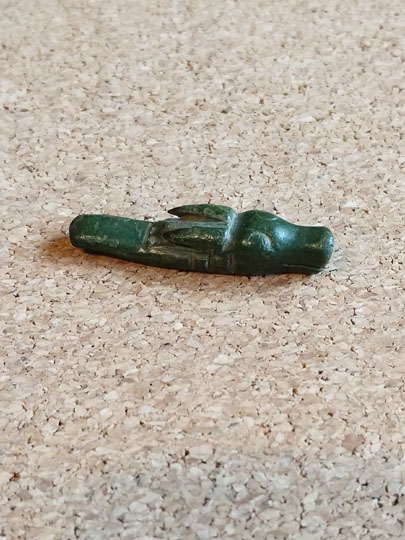
Although not having features as confirmatory of identity as those on preceding pages, this one-inch copper alloy figure of a beast is a Page Marker. Whilst as a piece of metalwork it would be desirable at any scale, its design and size do confirm that identity : as does its practical effectiveness when in use.
Absence of a means of attachment and extensive overall patination suggest that it was kept in prolonged, intimately-close use so as to render unnecessary its attachment to the user or to a desk. The design is such that when the left hand end is inserted between pages, the Marker remains reassuringly in place.
A seemingly unanswerable question is why this general form of seemingly benign, prone beast was adopted also for some of the aestels extant : including ones in the Collection.

Each one of the few extant aestels most likely has survived only because their handle/finial is of considerable aesthetic appeal. Without exception, they no longer are complete with the collar-attached pointer, perhaps of ivory or wood, which was fundamental to their purported purpose. Whilst couched in cautious terms as to that purpose, both the few museums with these and the Portable Antiquities Database describe their function as that of enabling 'following' of the text of a manuscript without potential damage from contact by fingers : itself reminiscent of the present-day use of gloves for handling precious objects. The best known of these aestels is the well-provenanced 'Alfred Jewel' which is in the care of Oxford's Ashmolean Museum.
Caution is adopted here also in describing this as possibly the one surviving, albeit aesthetically modest, aestel complete with its unitary pointer. That the handle has been broken, leaving sufficient length of striated section appearing to be a rule for measuring and spacing, suggests that this was used by a Scribe or Illuminator rather than by a reader. The richness in design, materials and decoration of each of the other aestels suggests that they were presentational/ceremonial rather than utilitarian but, by comparison, does not detract from this more modest but more complete aestel having its own aesthetic appeal.
Measuring a litttle over two inches in length and made of silvered, high-density copper alloy, open-jawed consumption of the purported rule by the Dragon suggests an implied reference to 'Devouring the word of God'---itself derived from Ezekial 3.3---Then God said to me "Son of man, eat this scroll I am giving you and fill your stomach with it". In an alternative, the consumption of The Rule may have been intended to make reference to unrestrained embracing of the Benedictine Rule : this at first sight a disrespectful observation but not so as the aestel has been conceived in the quirky style of Marginalia which enlivens many extant manuscripts.

In nearly immediate confirmation of the wisdom of the words 'possibly the one surviving' used on the previous page, this aestel surfaced for sale. Most fortunately in respect of research, study and understanding, these two together are of much greater value than 'the sum of their parts'.
Almost ( but probably ) all of the so-called 'aestels' surviving and in the record are the extant heads/finials only thereof and also, with few exceptions, are made of gold. It seems most likely that these, as already said, were each presentational/ceremonial. There then comes the interesting question as to whether these fine objects reflected others more modest used in a primarily functional manner.
Much work of writing and illumination undertaken by monks, nuns and lay Brothers and Sisters in scriptoria was repetitious : those with quills in their hands were the printing presses of the day and not only one copy of any but the most special of books will have been required. Work undertaken involved what the modern World now calls 'division of labour' : sections ( called 'stints' ) being written repeatedly by individuals. Collaborative working on the same pages must have required inter-colleague examination, planning and agreement and it is highly likely that aestels were used during such communication to enable precise, clear understanding whilst avoiding finger-contact with pages. Consider also the considerable aid which aestels will have afforded in view of routinely silent working within scriptoria.
This ( now ) two and a quarter-inch long aestel most fortunately has a knop ( in candlestick manner ) without which could easily have led to it being seen as a ubiquitous pin for clothing or hair. Further however, a pin would not have had the most unusual scarf-jointed end here present. The former handle attached by a matching male/female scarf obviously will not have been made of metal ( otherwise, why the joint? ) but of ivory, bone or wood : the last being compellingly most likely in recognition of the lowly status of the extant part.
It is both interesting and reassuring to be aware that this was found "during an organised dig on a field at the side of the river one mile from Ripon Cathedral" : itself stemming from a monastic community founded in the 660's.
Maybe the identification and recording of these two aestels will encourage and widen understanding of aestels per se : particularly in respect of their functional use during everyday production of the written word. That written to date is even cautious as to aestels' very existence for that purpose and may now be ripe for revision in light of these two extant objects.

That the finding of a complete aestel, from whichever early period and of whatever material, was not anticipated, can be seen from reading the last two pages. This has been wrought from solid silver and is 1 7/16" in length. With an integrated handle sculpted with care to match thumb and finger as though moulded therefor, and a totally flat, unfinished underside, albeit with an integrated suspension ring, its cataloguing as a pendant when found was both unobservant and life-threatening : silver value recovery beckoning.
Whilst the integrated ring leads to a presumption that this was suspended from the user's neck, from the period it is more likely to have been attached to a (sloping) reading desk by means of a lanyard : yet more likely, by reason of size, attached to a specific book by such lanyard laid down the pages with the aestel at its lower end.
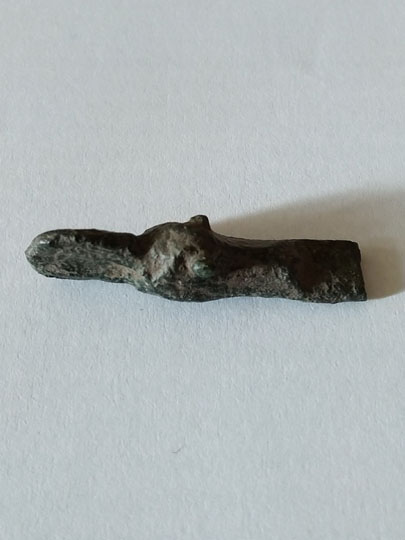
When an aestel was first acquired for the Collection, it could not have been anticipated that even a fourth one would now have arisen. This one has come from the site of the Anglo-Saxon monastery that was immediately adjacent to the extant Berkeley Castle in Gloucestershire : as have other items shown on previous pages. Most fortunately as a result of there already being three aestels to hand, it has been possible to know with certainty both that this is an aestel and that it dates from the Anglo-Saxon period. Made of copper alloy and not of silver, this one was held between thumb and finger as was that on the previous page. The overall design in the form of a reptile is, however, directly comparable to the aestel on the previous but two page. Both practicality in usage and the extent to which comparability of the shape of an aestel and that of a reptile invite depiction as such have led to different makers in different locations creating similar designs : although interestingly, this aestel shares different design characteristics with each of these other examples.
Now measuring 1 1/4" in length, neither the profile nor length of the pointer now lost can be determined with certainty : albeit few choices are presented in imagining the original complete design.
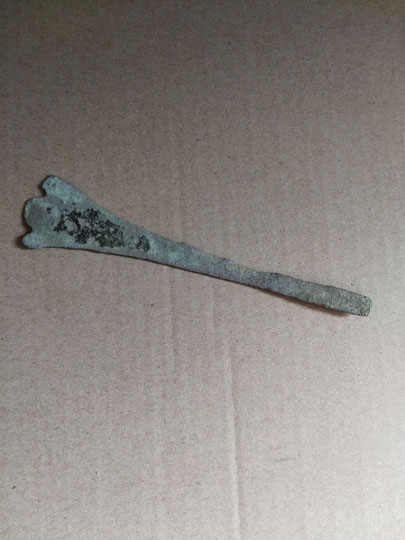
Originating from the scriptorium of the Anglo-Saxon Minster, the former site of which is adjacent to Berkeley Castle, Gloucestershire, this joins other manuscript-related artefacts in the Collection from the same site shown on earlier pages.
Measuring 4 x 7/8", and made of 1/32" gilded copper sheet, it remains in complete, good order : except for extensive loss of gilding. Whilst the design and dimensions of the few extant early aestels and page turners usually enable ready identification of their one purpose, this might have been used for each purpose. Adoption of the trefoil design reflects its monastic source.
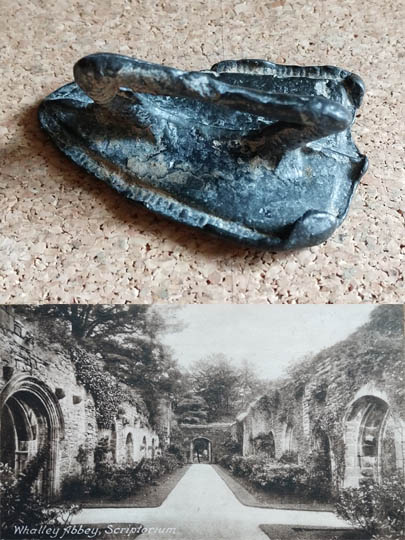
This was used by a scribe to correct small areas of imperfection in pages of vellum identified at the time of writing texts. Entailing application of materials to clean, fill, and flatten, the process will have differed little from that used during the later stages of initially making vellum sheets : other than by reason of scale.
Wrought from silver and measuring 1 5/8 x 1 1/8 x 5/8", it is highly patinated and in stable, complete good order. Both the supports of the ribbed handle and the channeling of the entire surrounding edge are decorated with fine serration. Handling enables certainty that it was made for and used by a right-handed monk : this being unsurprising in view of the suspicion of left-handed people during the Middle Ages.
The Tool was recovered in about 2016 by a detectorist searching a field adjacent to Whalley Road, Clitheroe, Lancashire : close to where is situated what remains of the Cistercian Whalley Abbey. With its walls still standing, but roof now gone, the grandeur and scale of Whalley's Scriptorium, in which monks undertook the writing and decoration of pages to be bound into books, can be seen from the photograph. It is unsurprising that so fine a Tool came from such an environment.

This was used by a scribe to correct small areas of imperfection in pages of vellum identified at the time of writing texts. Entailing application of materials to clean, fill, and flatten, the process will have differed little from that used during the later stages of initially making vellum sheets : other than by reason of scale.
Wrought from silver and measuring 1 5/8 x 1 1/8 x 5/8", it is highly patinated and in stable, complete good order. Both the supports of the ribbed handle and the channeling of the entire surrounding edge are decorated with fine serration. Handling enables certainty that it was made for and used by a right-handed monk : this being unsurprising in view of the suspicion of left-handed people during the Middle Ages.
The Tool was recovered in about 2016 by a detectorist searching a field adjacent to Whalley Road, Clitheroe, Lancashire : close to where is situated what remains of the Cistercian Whalley Abbey. With its walls still standing, but roof now gone, the grandeur and scale of Whalley's Scriptorium, in which monks undertook the writing and decoration of pages to be bound into books, can be seen from the photograph. It is unsurprising that so fine a Tool came from such an environment.
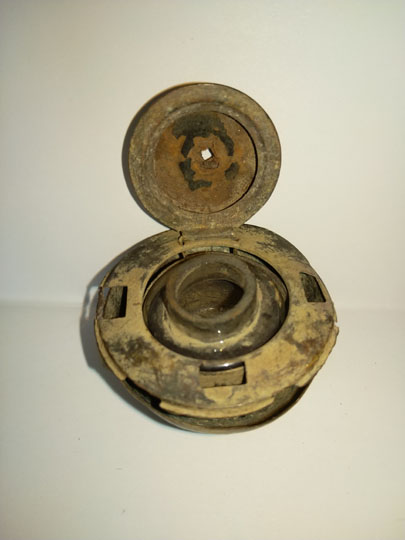
Medieval and Tudor inkwells tend to follow the same pattern. Modest ones are lead, leather, copper alloy or wooden simple cup-like containers and grand ones are of similar basic form but highly decorated: formed as a single element with, at most, a lid. How different this one is.
Six elements, five of copper alloy and one of glass, as five separable components (the hinge accounting for the difference six to five) together form an inkwell which is both highly sophisticated in design yet severely plain in execution: any decoration being for function or for practicality of manufacture.
A hemispherical bowl of very fine material (which may have been placed on a stand) has within it a round, flat-bottomed vessel of similar material with vertical, striated sides. Within that sits a flat-bottomed round glass bottle with vertical sides and a narrowed neck: also with vertical sides. A (lower) lid sits on top of the three elements, with an upper, hinged lid now without its original small knop. The lower lid has three pen-wipe slots which will have allowed for capture of ink in the 'reservoir' between the bowl and inner bottle-containing vessel. It is hoped that this description will enable understanding of the picture.
On the floor of the inner vessel are lying fine leaves of a presumably organic material which defies description. Cream in colour, finely shaped and piled piece-on-piece this material equates in thickness to modern-day cling-film. It seems highly improbable that it, in sheets of suitable size, could have been used for writing upon: being so fine. If specialists in this field so wish, it is likely that a picture could be taken from which investigation could ensue.
Moving from fact to conjecture, why was so much trouble taken to make this and why does it have the capacity to hold so little ink? Perhaps it was used infrequently and in a highly procedural manner for the signing of a document of importance by a person of importance. As an inkwell, it displays design and manufacturing overkill par excellence.
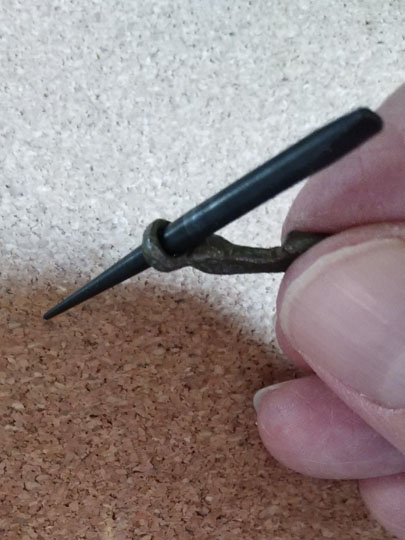
On grounds of practicability, complete quills used for writing will probably most usually, but not invariably, have been held without any sort of holder for support : period manuscripts confirming this so.
As an exception, this 1 1/2" long copper alloy Holder has a small ring for insertion of the cut bottom end of a quill at an angle to the handle rendering it most effective for use in writing.
Whilst it is likely that the handle is now reduced in length, the patination of the end and its practicability for purpose as now truncated suggests that it remained in use in this state.
The Holder was found in central York in the 1970's from a level indicating it to be Anglo-Saxon.
An implement with such a small ring is most unusually distinctive and it would be interesting to learn of others that might be known.
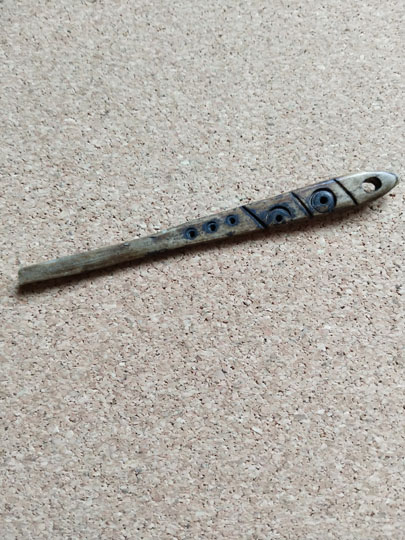
Whilst conjectural by reason of absence of references, former use can be determined with near certainty even from casual observation. Made of bone, 3 5/8" in length and in complete good order between its looped and chamfered ends, it has been drilled and channeled to provide multiple alternative means of wiping ink-laden quill tips during their use for writing.
The Wiper was found by a prolific archaeologist in the village of Holme-on-Spalding-Moor, East Riding of Yorkshire during the severe drought of 1976. The only village on Spalding Moor, Holme, is situated on a 120 foot high hill surrounded by the otherwise flat Moor. With a church of (now only minor remaining) Saxon origins, the village is notable for its 'Monk Farm' Scheduled Monument : a circa 1200 moated Grange of Anglo-Norman Selby Abbey, some 14 miles distant. With no other properties in the vicinity potentially to have been the source of something inherently linked to the production of manuscripts, that this was used by monks of the Abbey during sojourn at the Grange seems most likely.
Careful cleaning has revealed black ink staining of each of the circular and linear incisions that clearly evidence use as envisaged : a slight upturning of the lower third affording a most effective means of holding between thumb and finger whilst cleaning the quill held in the other hand. The loop will have enabled suspension from a sloping writing desk of the type familiar from surviving manuscripts.
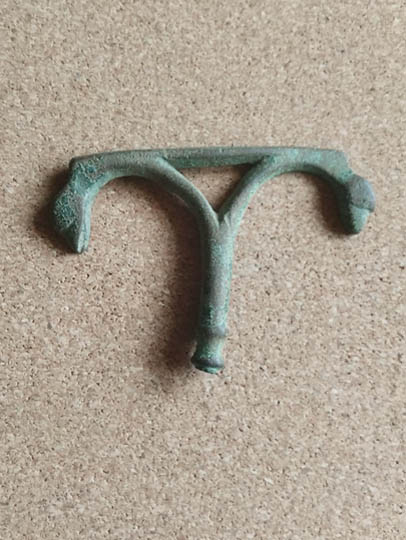
Albeit apparently similar both functionally and aesthetically to the topmost Rush Peeler on the page Medieval Lighting Rush Peelers, this however was used to modify quills in order to make pens employed in writing and drawing.
In complete good order, excepting that an estimated 1 1/2" of the handle has been lost (this based upon the expectation that the surviving knop was positioned centrally along the handle), it is made of (partially remaining but colour-faded) gilded copper alloy, and measures 3 1/4 x 2 1/4". As the knife is fully flat-backed excepting the handle, and the front of the underside of each arched arm and three sides of the triangle are chamfered, the resultant (then sharp) cutting edges enabled the shaving of quills : and compressing of their sides by use of the corners of the triangle. Optimally, feathers from swans were used for the making of pens, and this is reflected in the Knife being decorated with two swan's heads.
Excavated from King's Lynn, Norfolk, there appear to be no other similar knives recorded : although knives used for the purpose must have been so commonplace that the word 'penknife' has remained in use to the present day.

For reason of their nurturing of God's World and, more mundanely, to meet their considerable need for candle wax, medieval monks were involved extensively in beekeeping.
The Quill Pen Wiper on the previous page was found in Holme-on-Spalding-Moor : only four miles from Market Weighton where was found the Spoon. Whilst the possibility is only speculative of it having been associated with the monks of Holme, most probably the source of the Wiper, proximity of Market Weighton to Holme engendered acquisition.
Apart from the loss of most of its wooden handle and a slight split caused by the pin attaching that handle, it is in perfect, undamaged order : the bend and all incisions being as made.
Excepting the material of manufacture being copper alloy and not wood, there is little difference between the striated, bulbous end of this medieval Honey Spoon and that of a modern one : each reflecting the 'pine cone on a stick' said to have been the Chinese origin of the design. So effective is the design of the end, that transference between vessels or drizzling of honey by its use has not been bettered across millennia. What now is different is the absence of the regularly-spaced, oblique, vertical striations around the bulbous end and the four Z-formed faces surrounding the stem. This strongly invites the suggestion that the perhaps typical medieval form, used to exploit the viscosity of honey in order to aid handling, was abandoned by reason of the relative ease of turning spoons from wood : replicating only the major aspect of the design of the bulbous end and not that of the stem. If this is correct, here is an example of the complex forerunner of the now much-debased Honey Spoon.
At its size, the Spoon will probably not have been used by the monks for transference or for making mead but for drizzling honey onto bread or other food.

Although complete and undamaged, except in miniscule respects, even those of experience may have seen this to be fragmentary and unidentifiable as to purpose.
Made of copper alloy with a complete, fine period patina, excepting one small degraded area, it is 3/4" high and 11/4" in length along each axis: the 90-degree bend being original as made.
Whilst the quill will have been placed on the rest when on a flat surface, in order to maintain it in respect of surface state and quantity of ink, the Rest will have been lifted with the left hand and the quill stroked through with the right hand. The seeming mere decoration on the left arm being a dimpled holding position for thumb and first finger: the latter placed in the dimple at the back.

Whilst this tin alloy ( pewter ) douser clearly is medieval, it is interesting to consider why the form of attachment to a candlestick or lamp used here remained next to identical from medieval times to the end of the nineteenth century if not longer : even when in silver. This is yet more surprising as the design arguably is so ungainly and verging on the illogical.
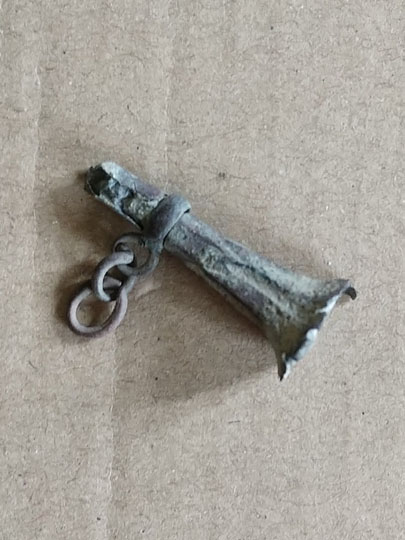
Whilst of necessity similar in its basic functional design, this Douser is considerably different in style from the norm : a later example of which is shown on the previous page.
Wrought from tin and now measuring only 1 x 1/2" at the present widest point, it was made in so proportionately fine and fragile a manner as to indicate that the lower part of the cone, now lost, most probably was no more than say 1/2-3/4" in length. The extant part is now packed with solidified wax so as to confirm its former function. Most notable is the means of connection to the candlestick by use of the chain. When commenting, on the previous page, concerning the hooks typically used as the means of connecting dousers to candlesticks, this Douser had not then been acquired for the Collection.
Found in deep silt on the bank of the River Wear in Durham, that so finely made an object was used for such a mundane task evidences the gulf between functional need and opulent display.
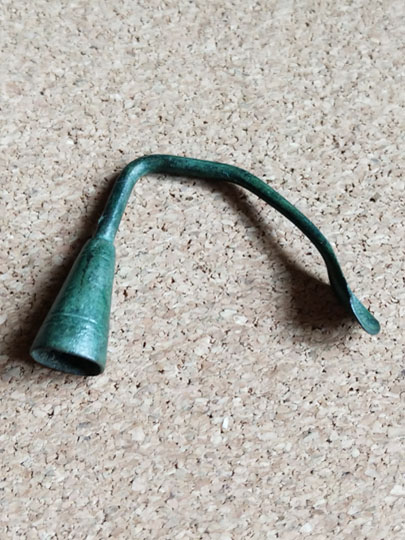
Whilst the candle dousers on the previous two pages each served only a single purpose, this device clearly was dual-functional.
Made of copper alloy, before being bent it had two 1 3/8" long arms that were parallel to each other : one terminating in the douser and the other in the spoon. The 90 degree bend below the Douser is in its original profile and will have matched the bend below the Mender before it suffered damage.
The word 'Mender' has been used to echo the call to children of a household to "mend the rush" : in order that they reposition a lit rush within the jaws of a rush light. Whether such request was matched in a candlelit home by use of "mend the candle" has not come down to us.
The spoon will have been used to scoop and relocate warm wax : both as it ran down the candle and when it was overwhelming the wick. Each arm will have provided a handle : aiding tending or dousing by use of the spoon or douser on the other arm.
Apparently without parallel, it reflects not the ingenuity but the practicality of the maker.
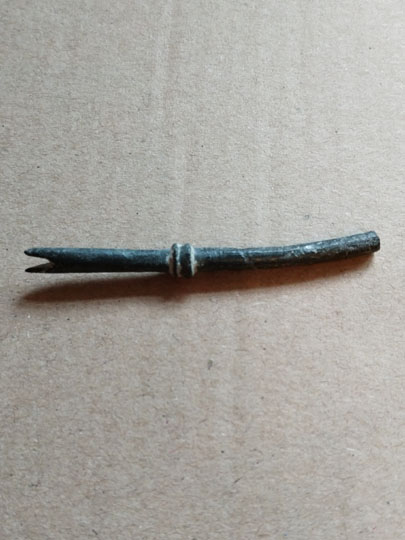
Recovered from Newton Kyme, North Yorkshire during the 1970's, the design provides leading clues as to the nature of its function. In particular, the central knop is seductively candlestick-like. Made of copper alloy, at a length of 1 7/8" and a width of 1/8" it is in complete good order. Specifically, the bend in the sub-knop lower stem is as made and has not resulted from trauma.
When held between thumb and finger, the V-projection was used to 'dress' the wicks of candles : whether or not burning at the time.

A casual glance would suggest that this 17" high finial of a monk sitting on a bench is itself from a bench. With flat side and back, it was in a corner position : in view of which no sense can be made if seen as a bench finial. It will have been a staircase finial but, being of such small width and depth, that staircase will have been modest in scale if not in decoration. Considering these physical factors and the subject, it will most likely have been at a 90 degree turn in a rood loft stair.
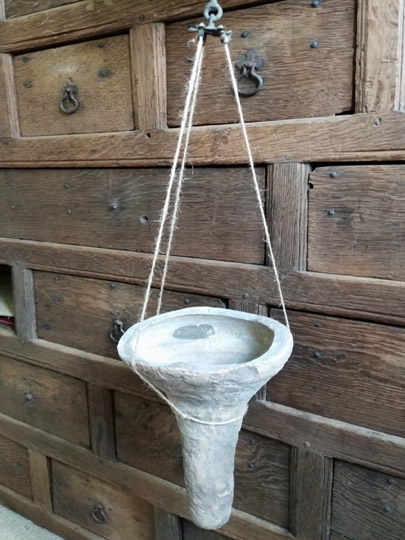
There are six cressets in the Collection : three in copper alloy, two in ceramic and one in stone. In view of the considerably greater availability and lower cost of fats and oils for lamps and cressets by comparison with wax for candles, it seems probable that, across a broad period, cressets were used more extensively than candlesticks. This is not of course to ignore the known widespread use of rushlights.
This ceramic cresset, 9" high and 7" in maximum diameter, was found in 1915, together with the one in the Collection made of stone, in the cellar of a house on King William Street, London.
In order that they can be shown at a size to enable understanding, on the following page are two period images of cressets such as this one. The first is a page from the 13th century Crusader Bible ( acknowledgement with thanks to the Morgan Library & Museum, New York ) and the second, also from the 13th century, of an extant wall painting from Winchester Cathedral. Whilst the former is in clear view, the latter can be seen in the bottom left hand corner under the ceiling of the building and above a chalice. From other manuscripts, it is known that these also were placed within a supporting ring of iron attached to a wall by a spike.
The three-armed copper alloy bracket by which this is suspended is one of four such in the Collection : differing from the other three by reason of the presence of the upper connecting element. Quite a few of these survive ( unlike the Cresset ) but this appears to be the only one remaining in this state of completeness.
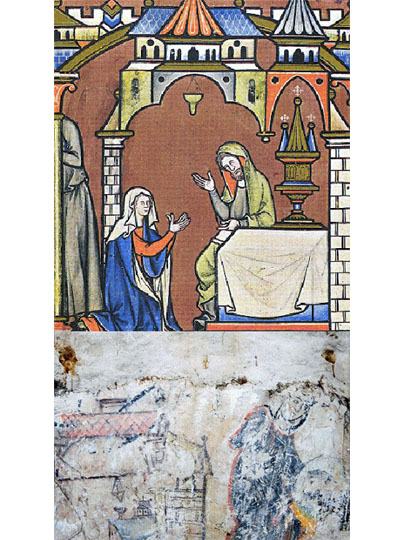
As referred to on the previous page.
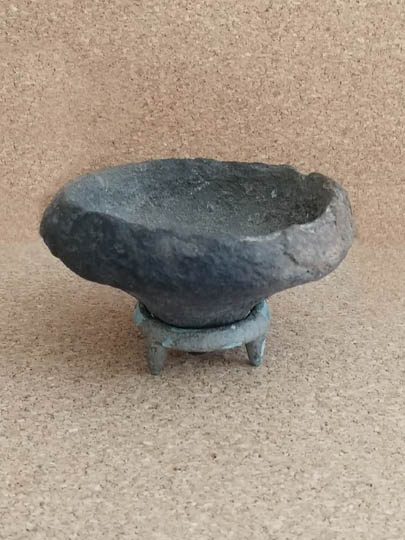
Unlike the Ceramic Cresset recorded on the previous but one page (with period references on the here preceding page), which appears to be uniquely extant, there are just a few cressets of the size of this one from which to gain comparative information. The Canterbury Trust has one, the Museum of London apparently five (one being Continental) and the Ashmolean in Oxford has two : albeit that one of them is of the same design but with a 'columnar foot'. Unlike the positioning of cressets of the size shown on the two previous pages, those of this size will not have been suspended from three-armed brackets : by reason of conflict between attachment wires/cords and the lit candle. They will, however, have been mounted on stands of the type shown here : which themselves will have been placed on a flat surface such as a table, bench or stool. Whilst it appears that no other such cresset stand is known, it may be that they exist but have gone unrecognised.
Exceptionally (and however unrealistically), a lit example of a cresset such as this is depicted in a period painting : in the hands of a saint.
Measuring 3"x2" and dating from the late Anglo-Saxon or Norman period, the cresset was found in Thetford, Norfolk, whilst the tripod stand was found in central York. Both cresset and stand are each in perfect, albeit period-evidencing, condition.
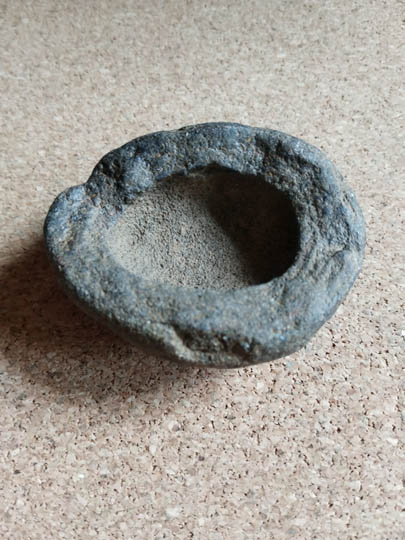
Serving the same function and used in the same manner as the Saxo-Norman ceramic cresset on the previous page, this was made by removing the upper half of a pebble and chiselling out the resultant surface. Acquired from the finder OG, recovery of the Cresset in February, 2021 from the surface of a recently ploughed field in Wing, Buckinghamshire was fortunate : it having been recognised as not simply an unworked, nondescript, pebble. Wisely, the patina was left completely undisturbed. Measuring 2 1/8 x 1 3/4", it is complete and undamaged : the channel for the wick remaining despite surface erosion.
Although now only the size of a large village, Wing is considered to have been an Anglo-Saxon administrative centre and has both an Anglo-Saxon church of major importance and the remains of a Norman Castle. Whilst the Cresset is here mooted to be Anglo-Saxon, this dating, although uncertain, is suggested with good cause.That the under-cutting was achieved by use of a cutting edge made from other than iron is improbable : so precluding a date earlier than the Celtic Iron Age. It appears that there is no evidence of significant presence in Wing during the Celtic period. Both the stylisation and use of stone, and not ceramic, appear incompatible with Roman practise. Although possibly Viking or medieval, use of stone and not copper alloy at this scale suggests otherwise. These factors might indicate, not unreasonably, that the Cresset is Anglo-Saxon : thereby according with known occupation of Wing during that Period.
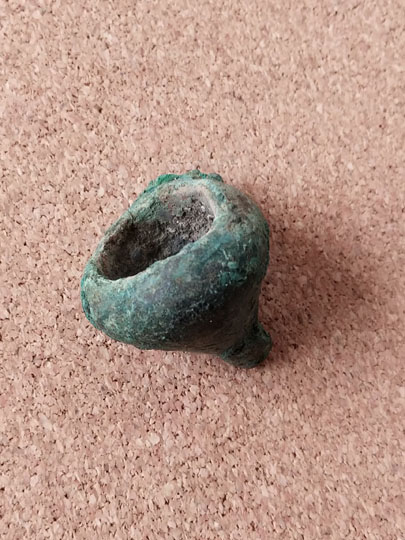
However unlikely is the finding of a Cresset from a wholly different period than the Medieval and Saxo-Norman ones on previous pages, this one from the Bronze Age now joins the Collection. The direct similarity of the overall shape of the three is testament to the time-independent practicality of this cone-shaped design when used for a fat/oil lamp. That said, the cresset in this form has survived in miniscule numbers by comparison with those of the cross-cultural 'handled horizontal vessel' form epitomised by countless Roman ceramic examples.
In complete good order and cast with obvious crudity from copper alloy, it is 1 3/8" wide and high and affords a very limited internal capacity for fuel in which to trail or or to float a wick. Whilst tempting to conclude, by reason of size, that it was used for votive purposes, that it was used for more general lighting may be indicated by presence of the embryonic handle : if handle it be rather than a requisite function or flaw of casting.
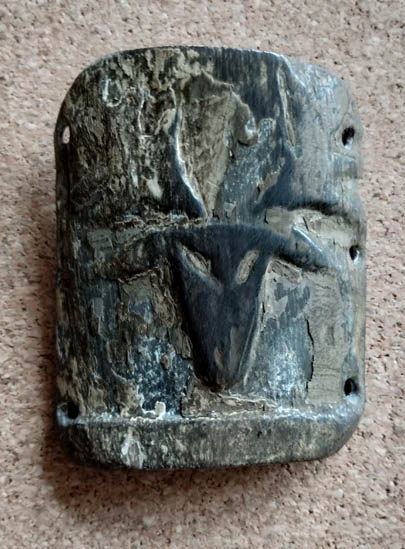
Extensive research has led to publication of a large body of work on the subject of what have come to be described as "Bronze Age Archers' Bracers/Wristguards." These have been recovered from many Bronze Age graves, including that of the Stonehenge Amesbury Archer. Whilst leaving no doubt as to their cultural significance, there has not been concensus as to their function.
The Mount has features in common with bracers but is not an example of one. It is, however, from the same culture and artisanal tradition. Measuring 2 1/2 x 2" and made of antler horn, its size, curvature, gilding, decoration with a Stag, and number of apertures for attachment are indicative of it being a Mount that formerly was attached to a leather tankard. Some of the few highly decorated "bracers" extant might justify re-attribution.
It was found in July, 1981 on Glaisdale Rigg : an elevated rocky ridge on the North Yorkshire Moors surrounded by many megaliths and barrows containing an estimated 3.000 Bronze Age graves. Sold originally by John Moor, the proprietor of an antiquities business based in central York, it passed through two collections until now acquired.

Listed on the Portable Antiquities Site database are about one hundred Cresset Lamp Hangers that are of the general type as the six from the Collection shown here. To more fully understand how these were used, see on other pages both the Cresset Lamps from the Collection and, particularly, the two period depictions of them when ceiling-hung.
---The third and fourth, whilst directly comparable to each other and complete, are of less substance than the first two. This likely reflects that they were used to hang smaller Cressets : possibly sometimes from a stand placed on a flat surface.
---The fifth, whilst of similar size to the third and fourth and having three rings for suspending the Lamp, has a pyramidal knop in place of a hanging arm.
---The sixth, that has no rings from which to suspend the Cresset, was cast with a 'clasp' through which it appears that a pin was inserted. Also, unusually, the arms are of unequal length. Notable is that there is another of this precise, unusual configuration on the PAS database. Most usefully, the existence of these two in an identical state confirms them each to be undamaged : despite having been expressed/recorded to the contrary. This one was found between Laneham and Dunham-on-Trent, Nottinghamshire in 2017.
Concerning those in the Collection, there presently are three unresolved issues. Was the central ring on the underside (where present) used to enable raising/lowering of a lid? Why is there no hanging arm on the fifth one and was the knop used as a simple pricket for a small candle? How was the central 'clasping mechanism' used to negate the need for suspending rings on the sixth one?
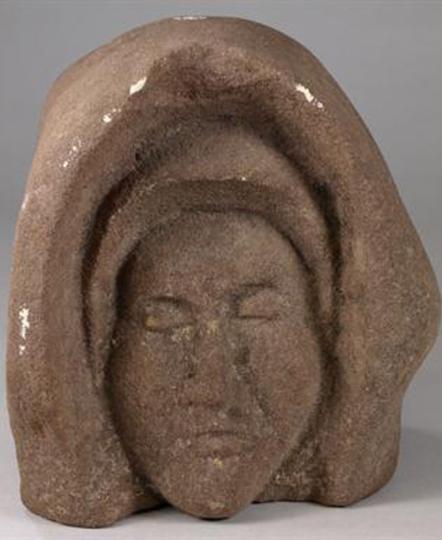
Knowledge of provenance so as to be able to specify the religious order and house from which this nun originated would have been appreciated. She does however remain an enigma, of necessity described only as being English, fifteenth century, about 7" cubed and made of sandstone. Perhaps, having already used the word and not resisting use of adjectives, she is enigmatic.
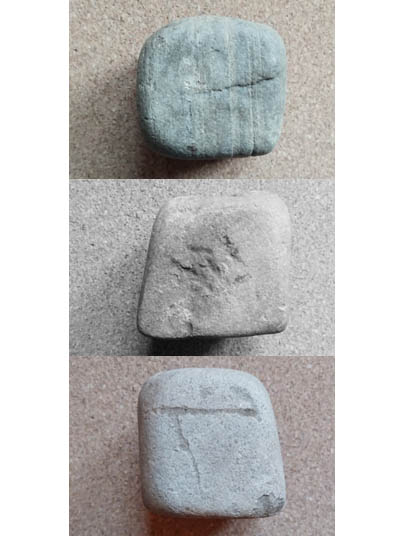
Formed by use of a striated, water-moulded sedimentary pebble with two faces chiselled into the present form, the Amulet is a cube measuring approximately 1 3/4" in each dimension. Incised into the top is the face of the God Odin, with the remains of an inset crown of silver, next to an applied representation of Gungnir (the Spear of Destiny) in silver. The vertical surface at true left has a circle representing the Sun incised closely within its perimeter, and the surface at true right also is incised but with the Elder Futhark Rune for 'Hope'. By incising a line into the top that relates to a natural fault in the stone, the 'Hope' Rune is also depicted on the top. Both the silvered Odin and Gungnir are discernable only by use of a loup. The stone is complete and undamaged except for partial loss of silver and the minor shaling of a corner.
The Amulet was recovered during the 1980's from the First Viking Winter Camp of 873-874 in Torksey, Lincolnshire together with other artefacts recorded on a highly detailed map : as advised latterly to the British Museum's Portable Antiquities Scheme.
Despite detail of the top being so obscure, a photograph is provided : together with those taken of each decorated side. Although difficult, it is just possible to see the silver Spear when closely directed to it. Viewing the top photograph, it is positioned vertically and immediately above the chip on the bottom face, one quarter way in from the left.
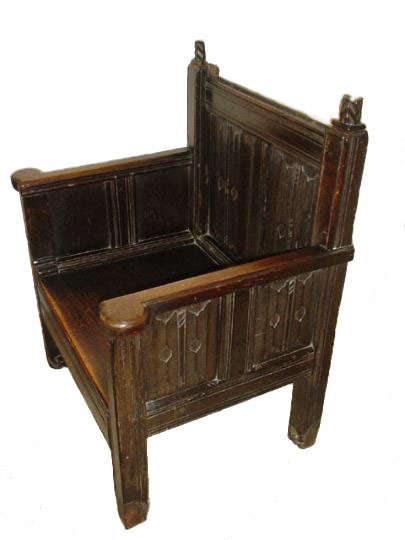
Whilst a somewhat socially offensive, albeit meaningful phrase, the 'high status' of the original owner of this chair is confirmed by the physical evidence. More precisely, what is now absent but unquestionably was previously present, is the source of that evidence. To claim age or status by comparison with the Coronation Chair in Westminster Abbey would be absurd, but there is one highly significant aspect of design shared by them : that of standing on lions. Whilst the Westminster lions are only from the eighteenth century, the original lions are here absent. However, the remains of their manes are incised into the lower part of each chair leg. Possibly at the time of removing the lions, the finials were sawn off to enable removal of the cresting rail. Surely this rail must have been of quite some importance to trigger attack upon such an obviously significant chair. The original finials are presently merely balanced in place but are certain to be original by reason of grain-matching. The third aspect of the chair which departs from the original is that the seat panel and front rail beneath it are replacements. This came about apparently because of the breakage of the seat panel which had fitted into channels along the full length of each of the supporting rails. Instead of taking apart the whole chair and then reinserting the seat panel, a new, larger seat was slid in from the front and a replacement front rail to support the rearrangement was affixed. Below seat level, narrow vertical members were present both between the seat rails on each side and on the front but these were not muntins for adjacent panels as would be expected in a fully enclosed box chair. None of this is conjecture and it is interesting to note that the original front rail remains in situ behind the later rail. The manner in which this work has been undertaken has resulted most fortunately in certainty of understanding of the original. The size of the chair also is indicative of status. Whilst however both wide and deep, this could indicate no more than that the owner was large. What cannot go unrecognised is the length of the legs : when adding whatever height is presumed for the lions to the present original leg length, the total height for the seat is improbably low for the period. This leads to a reasonably safe conclusion that the chair sat on a dais to attain usable height and therefore was of 'high status'. We can only wonder at the identity of its occupant.
The late Victor Chinnery spent some hours studying the chair. Amongst many other observations, one particularly remembered was his explanation as to why we can be certain that the arms are original. His scholarship and conduct experienced on many occasions are remembered with appreciation and affection.

Most medieval roof bosses are affixed in a central position beneath the junction of roof beams. Fortunately, the person recovering this 18" wide boss had the foresight to match innovation of positioning with innovation of acquisition. The two opposed angels sit astride a beam of small section which has itself been cut for extraction without disturbing the relationship between boss and beam. Some early paint 'shines through' the grime of centuries as testament also to the sensitivity of the recoverer in not stripping this evolved period surface. To assist in understanding and appreciation of the boss, rotation of the image by 90 degrees may prove to be beneficial.
This boss now is installed with the angels once again looking down beningly upon those beneath.
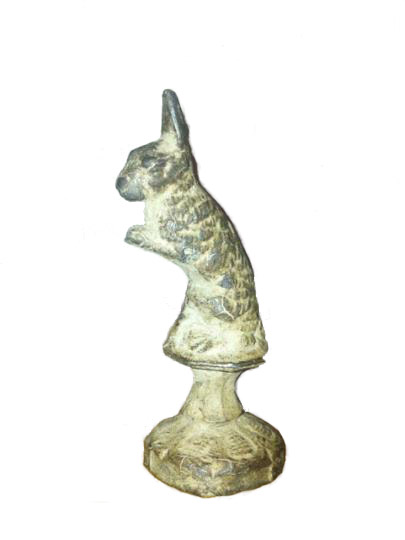
How interesting and enjoyable is the study, research and collecting of early game pieces. That most of those extant are not English, whilst of no account to a universal collector, would be inhibiting if forming a country-specific collection as this one.
This 3" high medieval hare is made of tin alloy ( pewter ) and is the centre piece of a so-called 'chase' or 'hunt' board game which was in vogue throughout Europe during the entire medieval period. One version is referred to as 'chase the hare' or 'catch the hare'. The other pieces were, much less appealingly, non-figurative. For those who love such special and beautiful creatures, fear not : apparently the game simulated the surrounding and not the killing of the pursued.
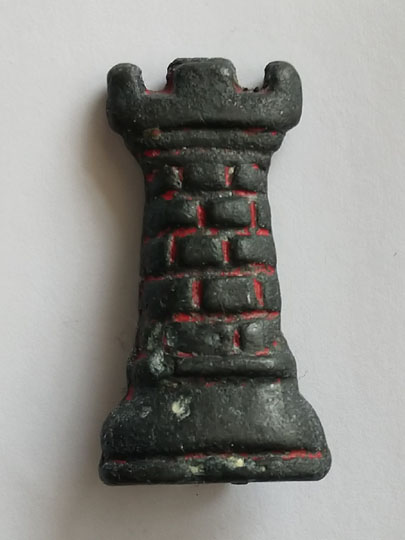
Albeit with somewhat less mystery than the Hare Game Piece on the preceding page, this Rook Chess Piece, which takes the form of a tower, nevertheless justifies its 'place in the sun'.
Thanks to those who have researched both the game of chess and the pieces used in pursuit of its own mysteries, it is recognised that the name Rook evolved from Rukh and that the piece itself evolved (in the West) from a chariot to a tower/castle by the 'end date' for the Collection----circa 1540.
Cast from tin alloy, with a height of 11/4"x3/4", whilst in the round it is deliberately so shallow front-to-back as to confirm it to be part of a 'travelling set'. That shallowness is rendered practicable in use by the small 'foot extension' which is part of the casting in the centre of the base on one side.
The extent to which the red paint remains on each side suggests the Piece to be historical and not archaeological. Although used very little and having survived in good order, dating to the sixteenth century should not to be considered exaggerative.

As with the Hare on the previous but one page, this half-inch copper alloy roundel of a young Deer, from Folkestone in Kent, also was the centre piece of a 'chase' game : albeit on a much more modest scale.
So many small, round, flat objects survive and have been described as 'tokens', that to default to such attribution is tempting. The size, absence of means of attachment, decorative subject and hipped profile of the underside to ease picking up, enable acceptably sound discounting of it being other than a Game Piece.
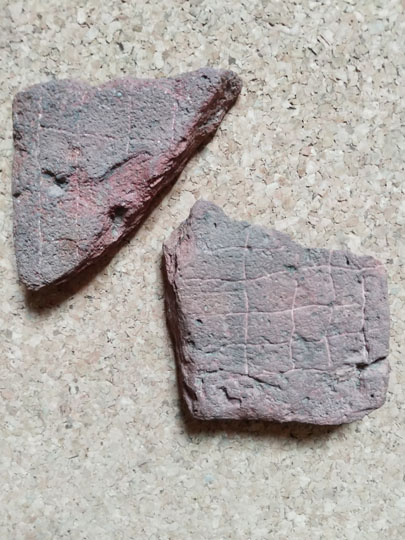
Extensive research has been undertaken on the Tafl group of board games : much of which is available online. The extent to which Hnefatafl is allegorical of Scandinavian societal organisation transcends all thought of it being a 'mere' board game used for entertainment. Boards upon which the game was played are known to have been across the range 7 X 7 squares to 19 X 19 squares. It seems likely that lifestyle factors and those of time constraint led to the game being played at different scale.
These two elements, measuring approximately 3 x 3" and 3 x 2 1/2" with a depth of 1/2", are from a Board that was formed by scoring a Roman terracotta tile. What is apparently the smallest flat standard size of roof tile, the Bessalis, is eight Roman inches square : equating to seven and four-fifths Imperial inches. From handling and studying the detail of the fragments, a strong impression is conveyed that the Board was of an intimate, smaller size than eight inches. Much is known and recorded about Roman roof tiles and about tesserae used for making floors : but not about terracotta floor tiles. It seems doubtful that the Romans did not use such for mundane flooring. If correctly observed, this Board is likely to have been made by use of a small, plain floor tile : perhaps say of six inches square. Notable is that, during play, game pieces were placed at the intersections and not within the squares as we would expect from current practise.
Found in the 1960's during landscaping work in the garden of a house on Fossgate, York, it is one of a small extant group from Scandinavia and only a few other Northern European countries. Of those surviving, most are fragmentary and most also are non-portable : having been carved into the top of heavy stones. Just a few have been found in Britain : and, again, almost all are non-portable.
Scandinavian finds have been recovered mainly, but not solely, from boat graves : where placed upon or very close to the deceased. How much more demonstrative of the significance of Hnefatafl to Viking society could this have been? Most of the few found in Britain have been located in and/or recovered from monastic sites. Alea Evangelii, played on an 18 X 18 squares Board, is a British ecclesiastical derivative that represented a moralisation of combative Hnefatafl. This renders unsurprising the finding on monastic sites of Game Pieces such as those on the following two pages. That monks played a game of such significance to those who had earlier desecrated and destroyed their monasteries provides convincing evidence of integration and/or acceptability of Vikings following their embracing of Christianity.
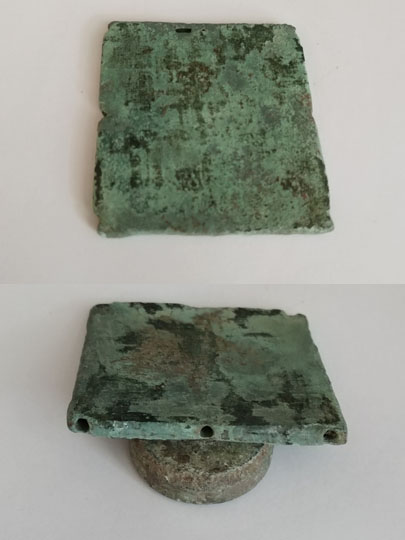
Whilst the two broken pieces shown on the previous page obviously are substantial fragments of a Game Board, less clearly so this also is an element of one : but has been designed and made in a completely different manner and form. Measuring 1 7/8 x 1 3/4 x 1/8" and made of copper alloy with a lead component, it is an entity. The means by which the Components of the Board were connected can be seen from the photograph of the edge, and it is tempting to wonder whether the connecting concept of Lego, which also originated in Scandinavia, derives from this early Norse source. Whether such modularity was intended only to provide compactness for transportation or burial, or to enable a board of variable size to be configured in conformity with the specific version of the game to be played, is undeterminable. That this one was intended for burial with a Warrior, as was then the not infrequent practise, is however beyond doubt : the compactness of the lined grid being unrealistic for playing Hnefatafl.
Ultrasonic cleaning would probably have clearly revealed the incised grid of lines : but also most probably would have resulted in serious erosion or total loss of the original horned image of the Norse God Odin which, in not unusual Viking manner, has been painted onto the surface. Albeit obscure, his face can be seen peering out of the surrounding verdigris. The Board Component is, and will remain, in its condition as found : evidencing the Vikings' habitual referencing of Odin.
It transpires that, when recovered from the site of the late ninth century Viking Winter Camp location of Repton, Derbyshire, other components of the Board were recovered at the same time but, regrettably, had been disposed of by the time this one was acquired. There being the means of connecting adjacent components only to left and right, and not above or below, the Board will originally have comprised three Components : thereby having been of a not untypical rectangular shape for a unitary board.

As mentioned on the previous page but one, this eleventh century monastic board game was developed from Hnefatafl.
Made from tin alloy and about one inch in height and width, the Piece is effectively identical to the form of Hnefatafl Game Piece that has survived in relatively large numbers. However, the incised cross in the base both sets it apart and enables identification of it as having been used in playing Alea Evangelii. From a detailed, period description of the game, it is known that such marking with a Cross was a standard means of identifying one type of Piece used during play and was not therefore, as might be expected, a general indication of faithfulness.
Found in the 1980's in the bank of the River Medway in Kent, adjacent to Aylesford Priory that is next to the river, it was later recorded with the Portable Antiquities Scheme.
That it originated from the medieval Priory (now returned to being an active monastery and retreat called 'The Friary') is next to certain.

Whilst being the second Alea Evangelii Piece from the collection, this is distinctive in having decoration confirming specific use in playing the game. It being a more complex game in respect of board, pieces and play than Hnefatafl from which it is derived, it is fortunate that a surviving eleventh century Irish manuscript describes the monastic game in detail. Different categories of pieces used include those identified with each of the ten Eusebian Canons : such specifying how each of the Gospels agrees with or differs from the others.
This 1/2" high (probably) lead alloy Piece, with its two encircling rings, represents the Second Canon. Found in Felixstowe, Suffolk, to have been used in playing a specifically monastic game invites hope, if not expectation, that it originates from the 12th. century Felixstowe Priory.
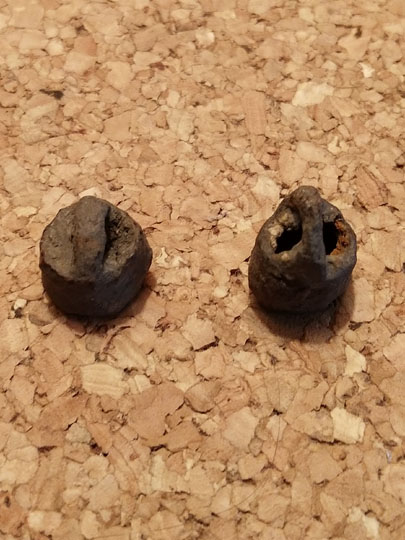
The pieces on the two previous pages were used in playing an ecclesiastical board game derived from Hnefatafl. These, however, were used in playing Hnefatafl itself.
The game pitches two groups of warriors against each other : one seeking to surround Hnefi (the 'King Piece') and the other to enable his escape to the edge of the board. Despite these pieces affecting warrior identity, most of those now extant show no design affinity with such. Many from Scandinavia, for example, are plain globules of glass and those from England chamfered cones of lead : as on the previous page but one.
This Pair, surprisingly made of iron, are each about 1/2" cubed and are compatible in size with the Board from the Collection shown on the previous page but two. That they are stylistically anthropomorphic and so small invites the thought that they date from the Viking invasion period. Later pieces perhaps progressively lost their warrior identity and became larger : as moving away from Scandinavian roots and the cessation of need for economy in space utilisation when no longer transported by sea re-set priorities.
Whilst it would be absurd to suggest affinity between this Pair and the Lewis Chessmen, they do have common cultural roots : albeit the Chessmen with fully developed human form and these Warriors only alluded to with recognisable eyes and helmet nasals.
They were found during the 1970's in Fulford, North Yorkshire : the site of the battle between Norway and England on 20th September, 1066 that preceded the decisive English victory over them at Stamford Bridge five days later : finally followed by the English defeat by the Normans in Hastings only three days thereafter. Found in the location of the battle, it is likely that they had been brought from Norway by a member of the invading force : although King Harald's force included Vikings already based in Orkney and from elsewhere in Britain.

The Roman Game of Ludus Latrunculorum and the Viking Game of Hnefatafl were played on boards of various sizes. Some variants of each required that the board be marked out in a manner that now enables identification : both as to whether it is Roman or Viking and as to the version of the game played thereon. Others were played on boards that were so similar as to inhibit specific identification. Whilst the Board shown on the previous page but three is stated to have been made in the Viking period by use of a Roman tile, that relies upon the typical informality of the scoring of extant Viking boards. By comparison, extant Roman boards typically are scored more precisely. However, if misattributed, it might have been made and used by Romans for the playing of Ludus Latrunculorum.
The Game was played extensively during a long period, and throughout the Roman Empire, using pieces called 'Dogs'. An example from the Collection is shown on the following page. These were identical to each other except for being coloured (typically white or black) to distinguish between each player's pieces. During the fourth and fifth centuries AD, a variant of the game was played using an additional two pieces that presumably were identical to each other (excepting colour) but different from all of the other pieces. These were called 'Dux' pieces : translatable in context as 'leader'. As evidenced by extensive survival, it is known that regular pieces were most usually simple flans of stone, lead or, particularly, of glass. Because the later version of the game involving use of Dux pieces was played during a relatively short period, that many fewer of them will have been made than regular pieces and because a stabilised form of design was not established or has gone unrecognised, there appear to be no Dux pieces recorded.
During the early period of playing the Game, pieces were made, and are extant in small numbers, in the form of crudely stylised dog's heads : apparently resulting in them being called 'Dogs'. Later debasement to the simple, non-zoomorphic form will have been dictated by ease of making : as with the opportunistic scoring of a tile in order to make the Board.
This 1 1/2" high depiction of a Roman Molossian war-fighting dog is made of antler, and was found during the 1970's in County Durham by a professional archaeologist. By reason of its size, flat underside, subject, sculpturality and 'player identifying' black colour it is purported with confidence to be a late Romano-British Ludus Latrunculorum Dux Game Piece.

Reference is made on the previous page to 'stylised dog's head' game pieces and this 1" long lead Piece, with its original white paint, is one such that was found in York during the 1960's in the same location as was found the Game Board on the previous but four page.
Whilst lacking the sculptural presence of the Dux Piece shown previously that depicts a Mollosian dog, the certainty of its contextual attribution and dating renders notable this depiction of a Laconian dog.
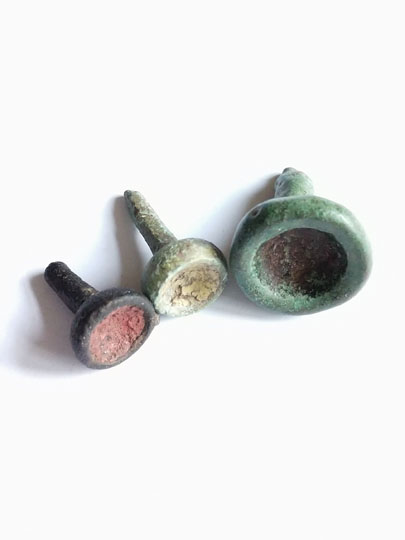
Brandubh is an Irish Tafl-family board game comparable (perhaps identical) to Hnefatafl. Only a small number of extant Viking Irish Brandubh boards are stated to be so : maybe as their design commonality with Hnefatafl boards counsels caution against certainty of identification. Whilst based upon only a few references, that these usually are drilled to accept 'pegged' pieces and not scored to accommodate flat-bottomed pieces perhaps is an identifying feature of a Brandubh board. Clearly, the drilling of material for pegging is more practicable when using wood rather than when using stone or tile. Most of the few Irish boards recorded are made of wood and drilled rather than scored : their 7 X 7 grids of drilled peg holes being no less visually defining than if the surfaces had been scored.
These three Pieces measuring 3/8 X 5/8", 3/" X 6/8" and 5/8 X 7/8" are made of copper alloy and each has sufficient colouring remaining within the 'cup', even now, to enable being distinguished during play.
Notable is that one such Piece is in the collection of Birmingham Museum : albeit not recorded by the Museum as a game piece. The dearth of these perhaps is explained by the relative ease of scoring rather than drilling material used for making boards and, similarly, the much greater ease in making simple, flat-bottomed 'flans' to use as pieces rather than complex castings such as these.
Consideration of these alongside the Irish Brandubh boards from Ballinderry and Waterford in Ireland dispels any thought that they were not used for playing on such boards.
Whilst the find location of the two outer Pieces is unknown, that in the centre came from Woodbeck, Nottinghamshire.
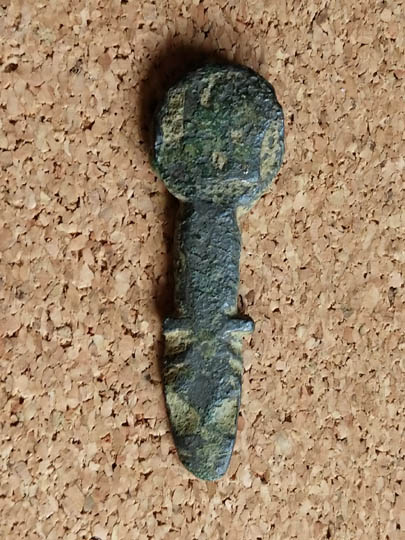
Although the many surviving Hnefatafl game pieces are apparently all free-standing, the few remaining boards used in the playing of Brandubh, the Irish cultural version of the game, show that some if not all of the pieces used in its playing were pegged : hence were not free-standing. This is one such and, although of a different form, so also are those shown on the previous page.
Recovered from Ripon, North Yorkshire, measuring 1 3/8 x 1/2" and made of copper alloy, it is flat-backed, highly decorated, extremely well patinated from extensive handling, and complete.
With a lower part decorated as a creature with pronounced ears, the upper, circular finger-hold depicts an apparent gatehouse with a central entrance : this possibly the Southern transept of Ripon Minster.
Perhaps this provides a reminder that the Vikings were strongly present in Ireland as well as throughout the Eastern side of England and Scotland.
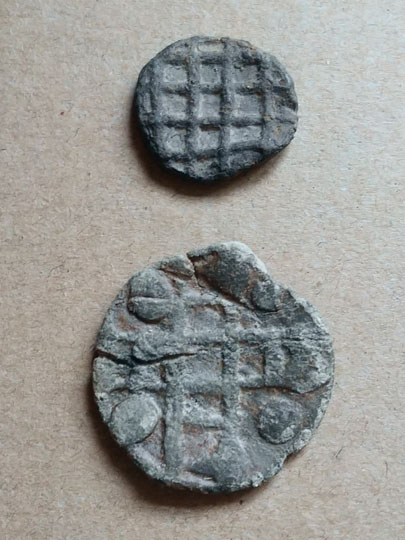
Frustration at the propensity to categorise most small, round, decorated flans of lead as 'tokens' has encouraged an attempt to identify some that unarguably are game pieces. Whilst many of them served widely different purposes, including that of tokens for use in various circumstances, there undoubtedly are some game pieces amongst them. On this page are two Pieces that were used for playing Three Men's Morris and on the following page is one used for playing Hnefatafl. These have been selected for the Collection by reason of them having a common characteristic : the board used in the playing of the game for which they were made is shown on the face of each Piece. In this respect they are not unique, but two of the three each has a specific feature that further reinforces their attribution and does appear to be without other references.
Three Men's Morris was (and still is) played by two on a board with a grid on only 3 X 3 squares. The first Piece, with a diameter of 3/4", shows a board in its state at the beginning of the game : devoid of game pieces. The second, with a diameter of 1", shows a board during play : with pieces in place. If the first board only had been shown, it would not have been unreasonable to suggest that it, and other pieces decorated in similar manner, had served an altogether different purpose. The depiction of the board complete with pieces does, however, provide total certainty that they were used in playing Three Men's Morris.
The find location of the first Piece is unknown, but the second came from Helperby Manor, York.

Hnefatafl game pieces typically are made of lead, in cylindrical or pyramidical form and have survived in large numbers. This Piece is fundamentally different from the norm.
Equivalently as with one of the two Three Men's Morris Pieces on the previous page, a version of the board used in the playing of Hnefatafl is shown on the face of this 1" diameter Piece. It at first appears that there are no game pieces depicted on it : but that is incorrect. When commencing a game of Hnefatafl, the King Piece is placed in the centre of the board. Here, that is represented by the 'nodule' in that central position : evidencing the strong likelihood that this is one of the forms in which a King Piece was made.
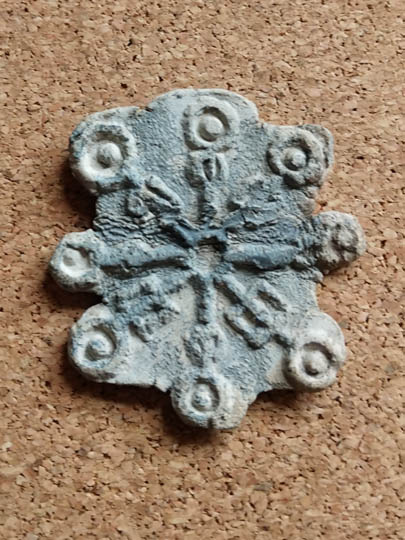
Cast from lead and spanning 1 3/4", the Piece depicts a Crown and a Game Board laid out with pieces.
As there were many variants of the Tafl family of board games, much that has been written about them is wisely non-commital. In particular, in respect of the number of positions on boards, the number of game pieces, and the rules for mobilisation of those pieces during play. The eight pieces on this board are positioned to defend the centrally-placed King, as represented by the Crown, in numbers and manner known to be one of the traditional layouts. The attacking players that would have been around the perimeter at commencement of play, are not shown.
Acquired from the finder, this was recovered from a sixth century context in Bassetlaw, Nottinghamshire on 8th March, 2020 : thence being recorded with the British Museum's Portable Antiquities Scheme.

Cast from lead and spanning 1 3/4", the Piece depicts a Crown and a Game Board laid out with pieces.
As there were many variants of the Tafl family of board games, much that has been written about them is wisely non-commital. In particular, in respect of the number of positions on boards, the number of game pieces, and the rules for mobilisation of those pieces during play. The eight pieces on this board are positioned to defend the centrally-placed King, as represented by the Crown, in numbers and manner known to be one of the traditional layouts. The attacking players that would have been around the perimeter at commencement of play, are not shown.
Acquired from the finder, this was recovered from a sixth century context in Bassetlaw, Nottinghamshire on 8th March, 2020 : thence being recorded with the British Museum's Portable Antiquities Scheme.
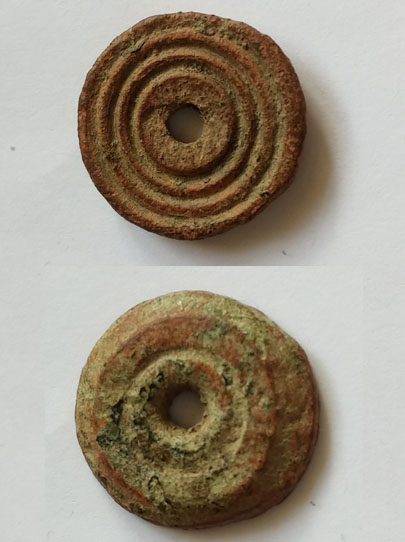
In 2013, a game piece of unusual form and construction was recovered by Reading University's Department of Archaeology. Not since ten such pieces were recovered from the churchyard in Taplow, Buckinghamshire in 1883 had such a piece been found. The form is that of a small, hollow cylinder of bone : with cappings in bone at each end that are held in place by a peened pin. Those from Taplow, now shown in one photograph online by the British Museum, vary widely in condition : fortunately aiding understanding of their construction. The one from Lyminge, Kent, now in the Maidstone Museum, is complete.
This 3/4" diameter cap, found in Middleton, Norfolk, is from the same type of Piece as those from Taplow and Lyminge : differing only by apparently having been made from copper. That it has been successfully turned in order to produce its decoration, implies that nearly pure copper was used for its manufacture. It is a moot point whether bone or copper would have been preferable for making such caps : although bone was the obvious choice from which to make the cylinder. Perhaps the choice was one of aesthetics.
Surviving now only as an element, following presumed failure of the metal pinning, this appears to be only the twelfth recorded Piece of this age and form. As was observed widely in the Media following finding of the Lyminge piece, the considerably greater effort required to make in this manner, rather than from a solid block of material, implies 'high-status' use. Many other items recovered from Taplow and from Lyminge confirm each site to have been of importance.
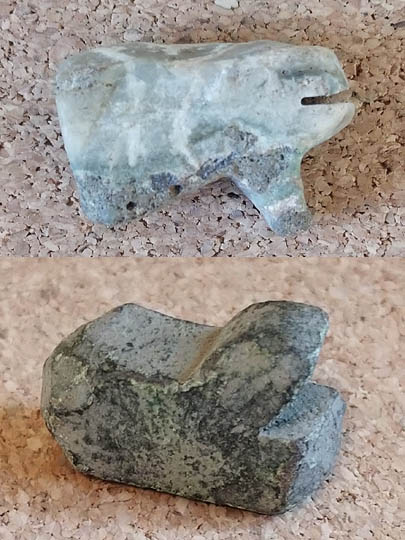
Measuring 1 x 3/4 x 1/2" and 7/8 x 1/2 x 3/8" these are made of Walrus tusk (Morse) and Iron Pyrite respectively. They have been in the collection of a York-based archaeologist since being recovered prior to 1960 from the Bedern area of central York by one of his friends.
Although different in material and form, they have common characteristics of design and making that confirm their mutual source. It is likely that the use of different materials, hence being of different colours, might have denoted their different roles within a set of pieces. The position and extent of wear and patination is confirmatively revealing of orientation and handling during play.
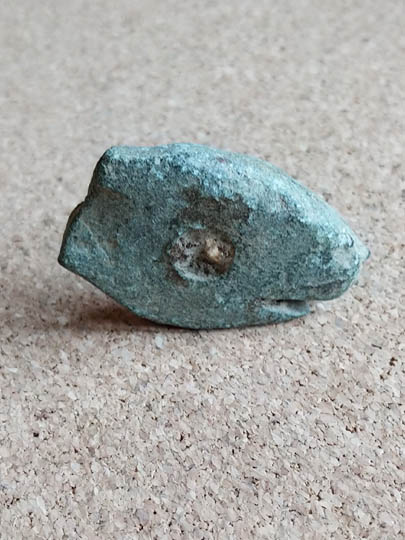
Emanating from the same source as the Viking Game Pieces on the previous page, this copper alloy Piece depicting a Whale measures 1 3/8 x 7/8 x 1/4". This third dimension enables certain attribution as a game piece : both its weighting and 1/4" depth ensure that it stands securely upon the well-patinated base. If of lesser width and with an unpatinated base, it might well have been a mount from an undeterminable context. The Piece was recovered from Eastry in Kent : where was situated in 634 the palace of Egbert, King of Kent.

Fashioned from an approximately 1 1/4 x 1 x 3/4" 'found stone', this represents a Whale : as do the game pieces on the previous two pages. Following incising of the mouth, the maker forsook completion of the aperture that could have been completed from one or each side. The depth of the one aperture indicates an intention to span the Piece and not just to represent the Whale's eyes. Although probably then used as a game piece, it might have been the original intention to create a suspendable pendant/amulet.
The Whale was recovered from the initially Viking village of Ulleskelf, North Yorkshire.

Whilst well pre-dating most of the Collection, acquisition of a provenanced British Game Piece from such an early date proved to be irresistible.
Carved from chalk and measuring 7/8" in both height and diameter, the Piece is complete and undamaged. Although the softness of chalk is incomparably easy to carve, the making in such a shape likely was frustratingly awkward.
The Piece was recovered during the 1950's by a professional archaeologist studying the site of a Bronze Age roundhouse in Fulford Ings. Fulford, the site of the battle in 1066 in which King Harald beat the Northern Earls prior to his defeat at Stamford Bridge by King Harold, is in the outskirts of York : Fulford Ings being a large area of marshland adjacent to the River Ouse.
Although they perhaps are misleading references by reason of perception that they served a different function, the British Museum's three 'Folkton Drums' and the one 'Lavant Drum' (all from Britain) warrant comparison with this Piece. More pertinently, an extant early game board from Jordan reveals notable design compatibility. Although it appears that no other British game piece from such an early date is recorded, if the four Folkton and Lavant Drums are not measuring devices as perceived, they most probably would be game pieces. If so, all four would be of greater aesthetic appeal than this one for reason of their detailed decoration.

The 21"x21"x13" font is from the churchyard of St.Mary's, Badley, Suffolk which was constructed in 1086 to replace its Anglo-Saxon predecessor.
Just visible at near right is the mounting position for the lockable cover which most usually is present on early fonts to protect the water contained from profane use.
The extent of internal staining from water would suggest that the drain hole in the bottom was used sparingly : unless this was sealed up to facilitate secondary use in the churchyard.

Following many years during which a depiction of the crucifixion was not acquired for the Collection, this was ended by the arrival of this monastic bell. Standing almost 10" high, it is late medieval and made of copper alloy ( bronze ) and iron. Those parts in iron are the clapper and the mounting for both it and for the handle : the last being peened at the top to constrain the copper alloy handle in place. As it is in completely original condition, not only can the method of manufacture be fully seen and understood but also can be the sequence of assembly. There are identical depictions of the crucifixion on each side.
Well remembered is the courtesy of the dealer from whom this was acquired and her view that the bell is French : an opinion there is no cause to question but simply informatively to add 'Northern' before 'French'.
Respecting the Monastic community from which it came and the medieval Church law and practice concerning disrespectful ringing of ecclesiastical bells, it has not been rung since acquisition.

Thanks to both the care of and relationship between the finder and supplying dealer of this fifteenth century copper alloy bell, it is known as good as exactly where it was found in Reepham, Norfolk.
Close to both Norwich and Walsingham, Reepham had its own Marian Shrine ( as did Walsingham ) : which likely was situated within one of the three churches occupying the same churchyard in the town. Whilst not found in church precincts but still close to Reepham, it is a matter of conjecture whether the bell was used in worship or carried by a pilgrim. One would expect however others of this type to be known if it was carried in pilgrimage : and they apparently are not.
It is hoped that its gentle charm is conveyed by the picture.
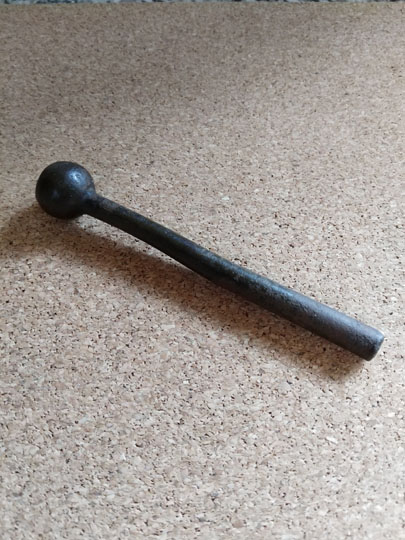
Most fortunately, as with the Bell on the previous page, it is known from where this was excavated : the site of a now demolished mid-12th century church in a here unspecified Southern English major town.
Made of copper alloy and measuring 3 1/2" in length with a ball diameter of 5/8" and maximum stem diameter of 1/4", it is in complete, good order : completeness confirming that it is a hammer for the external ringing of a bell and not the major part of a clapper for its internal ringing.
It is not unreasonable to expect that such a bell came from and was used within a monastery or shrine rather than the secular (i.e. non-monastic) early church formerly on the site. This finding encourages further site investigation as to the possibility that a monastery or shrine pre-dated the 12th. century church of which now only fragments remain : that church itself being the earliest known building extant in the Town and its environs. A further indication that this is so comes from the distinctively early name of the Church : it not being dedicated to a saint in the more usual manner.
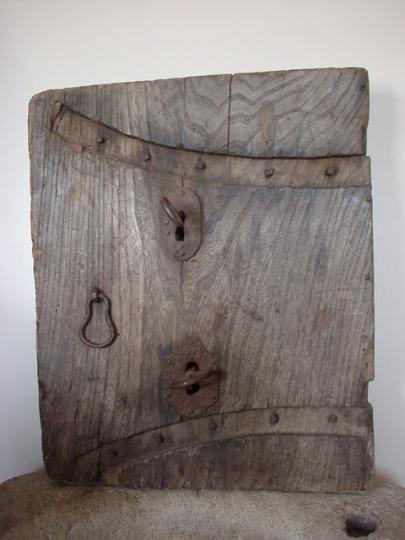
There remains a rather sad looking small aperture in the chancel of most early churches. These were wall aumbries in which were kept church valuables of particular types : those used in celebration of the Mass.
This door was used to secure such an aperture and, whilst the number of those now separated from their original position probably is very small, the number surviving in situ most certainly is so.
The dimensions of the door are 19" in height, 15" in width and a remarkable 21/2" in depth. Whilst now gone, the hinges clearly were of a most unusual, security-aiding form. Also surprising is that both original locks and keys remain.
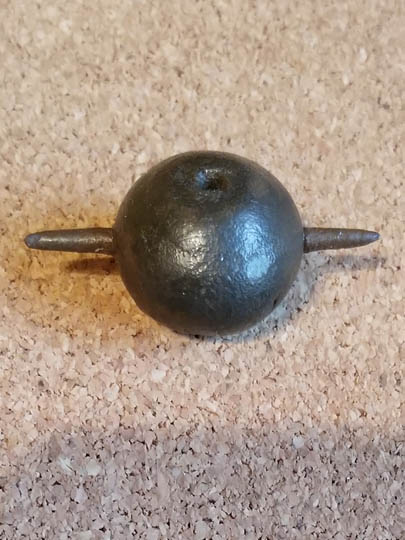
Made of copper alloy and measuring 1 1/2 x 3/4", the Lighter is in complete good order : albeit now without its associated staff. With a lit candle stub on each transverse pricket, when mounted onto its temporary staff this was raised in order to light the Sanctuary Lamp. If during the process one stub was inadvertently extinguished, the second one was employed.
The Lighter was recovered in 1970 from what now is called the 'Mount Area' of York and formerly was called 'St. James's Hill'. This is outside but adjacent to the the South-West corner of the City Wall : where was the major entrance from London and the South. Only two ecclesiastical establishments from any period were situated in this area : the Holy Trinity Priory on the City-side of the Wall and the 12th century St. James's Chapel on the outside. The Chapel was gifted to the Priory by Saint/King Stephen (here depicted on the Home Page) during the 12th century. When each Archbishop of York was being consecrated at the Minster, the celebratory procession commenced at The Chapel. Less glamorously,The Hill was the site of the City gallows and the Chapel grounds used for resultant burial. It serves well to remember that amongst those buried there were some condemned for their Faith.
That the Lighter originated from St. James's Chapel and not from the Priory likely is correct. Although the precise location from which it was recovered is known, that of the Chapel is known only approximately : it having been destroyed during the eighteenth century.
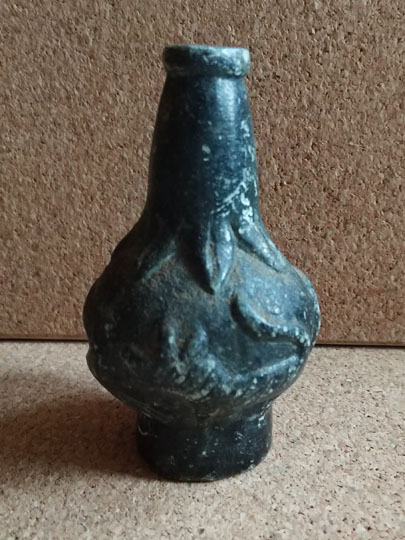
Although typographically categorised as a 'bottle', this does not define its function. Decorated with leaves that allude to its content, and with three encircling leopards of different design closely similar to those depicted on one well-published jug in the Museum of London, its overall design, elaborate manufacture and dimensions of 2 3/4 x 1 1/2" confirm it to have been a Cruet used to administer sacramental oil. The stylised leaves depicted, being from the commiphora myrrha plant used in the making of Chrism oil, evidence that the specific sacraments for which the Cruet was used were those of Baptism, Confirmation and Holy Orders.
The design of the vertical lower part shows that it was positioned for safekeeping within a reserve in the base of a chrismatory : next to two other cruets that were used for different sacramental purposes. The chrismatory will have been kept securely within a Wall Aumbry : the door of one such being shown on the previous page.
Recovered by the archaeologist Gordon Hardcastle, during the 1960's, from the small village of Kirby-on-the-Moor, North Yorkshire, that it originated from other than Kirby's Anglo-Saxon All Saints' Church seems unlikely.

Few, if any, Anglo-Saxon spouted vessels in any metal have survived : whether monastic, secular or non-ecclesiastical. Most notably, the seemingly predominant, extensively-published example in the British Museum, that is catalogued erroneously as Anglo-Saxon, is Ottonian and of somewhat later date. This attribution is historical and should not be seen to reflect upon current British Museum scholarship. In the apparent absence of a complete Anglo-Saxon cruet, the line drawings of two Anglo-Saxon spouted vessels depicted in Robert von Spalart's work of 1810 are references of relevance. In light of such dearth, this Spout engenders academic significance belying its fragmentary modesty.
Cast and wrought from silver and 3/4" in length, it is in complete, uncleaned original order. It will have been attached to a (probably very short) hollow protuberance from the Cruet : by that being inserted into the Spout to the position where it abutted to the the stepped narrowing at the head end.That the Spout has survived might be explained by the manner of its fixing. Despite the elegance of design and manufacture, there was no additional means of fixing to that of the two components of protrusion and Spout fitting tightly, one within the other, and of their having been sealed by use of heat. This means of attachment might have failed : the detached Spout thereby avoiding the 'melting pot' or 'hack silver' aspirations of later Vikings.
The size of the Spout suggests that its parent vessel might have been even smaller than the the British Museum's aforementioned 2 7/8" tall example. The small capacity of such a vessel, that it was (for Anglo-Saxon metalwork) most unusually spouted, that it was made of silver, and that it depicts a Ram signifying Christ's sacrifice, show it to be from one of a pair of ecclesiastical cruets that held water and wine for celebrating Mass. Further, the small capacity might indicate it having been made for secular use : as the monasteries served Mass to assembled monks, but secular churches Served to only a very small number of priests at any one time.
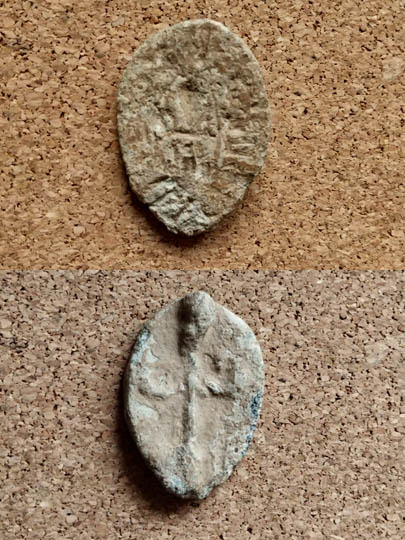
The much-loved, ruined Jervaulx Abbey in North Yorkshire, although well known for its Wensleydale cheese and horse breeding during its later years, was insecurely founded and funded in its early years. Between its establishment in 1170 and its demise at the Reformation, Jervaulx was served by a succession of 22 abbots : one of whom, Abbot Philip, was murdered in 1279. His successor, Abbot Thomas, was arraigned for the offence but determined to have been innocent of it. Another monk from Jervaulx, William de Modither, deemed responsible for the murder, fled into outlawry.
The vesica-shaped Matrix, measuring 1 3/8 x 1", is made of gilded, wrought lead with a substrate of material to bond the now colour-faded gilding to the lead. The front is incised with a letter 'P' for Philip below an eternal flame : both contained within a vesica shape denoting a coffin. Thanks to painstaking examination undertaken by a long-term 'Friend of the Collection', Prof. G S, the legend around the perimeter has been recognised to read '+ S ?HOM?S ?BBOT' (seal of Thomas abbot). The back of the Matrix has the bearded head of an aged man above a Lily : this alluding to Jervaulx as being dedicated to St. Mary and being a sign of purity at death. Notable is that at least one grave slab extant at the Abbey is carved with a lily across its whole surface. Although not made to be a handle, the shaping at the back of the head would have enabled lifting by use of a fingernail when removing the Matrix from the impressed wax seal. Whether this figure is of Philip or Thomas is less than certain, as depiction of either one might have been deemed both appropriate and seemly. Realistically, perhaps only knowledge of the age of one or more of the abbots and/or whether they were bearded at this date might have enabled certain identification.
Why so procedurally valued an object was disposed of in a midden at the Abbey, enabling recovery by the archaeologist Gordon Hardcastle in 1976, probably will remain a mystery.
That the Matrix is gilded in such manner as to partially inhibit its use, and that neither the text nor its constituent letters are reversed in the habitual, logical manner for impressing wax, appears to evidence it having been made more for procedural than for functional reasons.
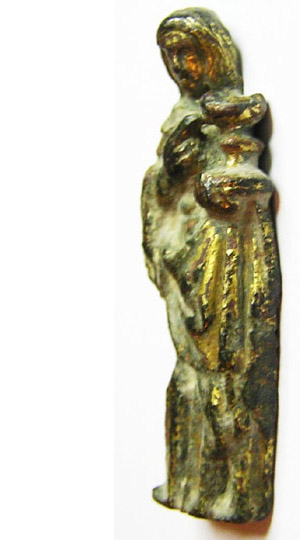
Whilst the same subject of St. John as three of the four processional cross figures shown on other pages, this smaller figure is from a casket. Highly detailed and still heavily guilded, John is seen pointing to the serpent rising from the chalice which he is holding : hence depicting the origin of the term 'poisoned chalice'.
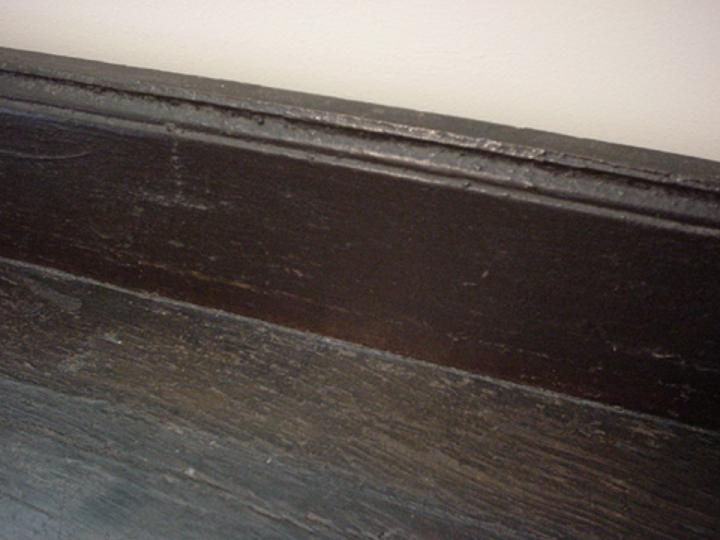
The form and use of long dining tables has been well documented in surviving period records. Single boards were laid upon trestles without attachment : being held in place solely by their weight. Following dining, boards and trestles were dismantled in order to thereby not occupy space required for other use. Whilst large groups will have dined in this way, in order to avoid over-romanticisation, it should be recognised that modest people having meals in family groups will have in no way engaged in such grandeur.
By reason of scale, colour, texture and implied historical association, a table board is an impressive sight.
This oak table board is 10' 5" long, 2' 2" wide and over 2" thick throughout most of its length. Having been removed from a much later piece of furniture, there now are marks of attachment but there are no marks whatsoever from period times.
So, where is the picture of the table? The picture here instead is of the highly unusual, if not unique, 'upright' which is attached throughout the entire back of the table. This shows the table to certainly have been a 'side board' for holding food and utensils used in serving to the assembled diners. Seventeenth century narrow, high serving tables fixed to bases are not unusual to see : a side board from an earlier period is a different matter.
There is an issue here to be addressed. Was this upright attached when the table was made or is it a later modification? Confirmation that it is original is provided conclusively by a feature probably unique and certainly of great appeal to the observer. Both the underside of the table and the back of the upright are 'grey'. This term indicates a surface which is completely unpatinated. Throughout the length of the top and the length of the upright, there is a very fine, period chamfer : shaved from the lower edge of the back of the table and the outer edge of the underside of the upright. These chamfers, being contemporary, confirm manufacture at one time. It should be added that the pinning of the upright to the back edge of the table is also period and undisturbed : survival in this state being remarkable.
Finally, and most surprisingly, the table has been shortened in such manner as to indicate that a major piece has been removed. If this had only been trimmed, why would the 21/2" thick end have been cut rather than the end where one side narrows to a little over 1". The table formed by separation must itself have been of quite some size to justify such emasculation. Just imagine a say twenty foot long serving board!

The vast number of surviving, formulaic decorative mounts which have been removed from furniture, boxes and objects of all sorts and from all periods renders the finding of any of merit akin to finding the proverbial needle in a haystack. Some decades ago, when seeking to complement the Collection with appropriate antiquities, an attempt was made during a two-year period to acquire solely British-found Anglo-Norman objects of appeal. Despite the Normans having left us their majestic monastic buildings and perfectionist, minimalist domestic dwellings ( albeit only 23 of them in England ), items of any lesser scale usually comprise only weaponry and 'dress accessories': even these being vanishingly scarce. This attempt was doomed to failure and a default to marginally less idealistic collecting from the medieval period ensued.
Uniquely, this mount has only now joined the Collection for three reasons : his overtly Anglo-Norman character, his relative three-dimensionality at 5/8th" x 5/8th" x 3/16th" and, bluntly, his availability.
Wearing the typical nasalled helmet of an Anglo-Norman warrior, he clearly was fully gilded : leading to the possibility at least of this having been the bezel of a ring.
Thanks to present-day photography and despite being of minute size, he now can be seen, understood and appreciated.
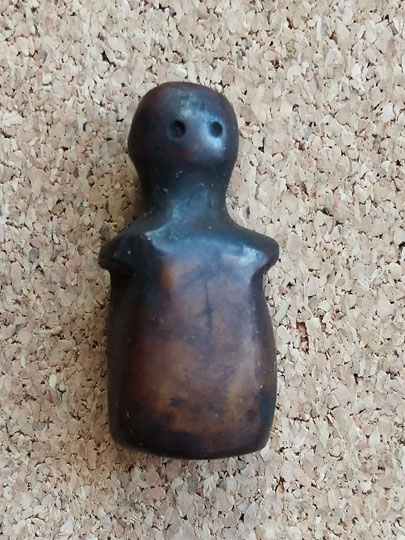
Viking incursion into Britain is well documented in respect of its violence and destruction. Absorption of Norse peoples into British life and culture has, however, been deemed to provide a less salacious story. That it occurred successfully is evidenced by the DNA of Britons.
Little more poignant an image of settlement could be provided than one of a Viking child's Doll : in itself a representation of Motherhood. Made of antler and 1 1/4" high, it is complete and in original condition. It was not part of a composition or attached as an amulet/pendant, and free-stands satisfactorily.
The question is begged as to why so much skill and care was put into making something so small. That this is explained by it having served a votive purpose cannot be ruled out : such proposition possibly also supported by its perfect, original condition.
It was acquired in the mid 80's by an archaeologist who, despite his considerable collection, saw merit in it to justify purchase from a detectorist/collector friend.

Questionably a period maquette of the well known figure of a deacon from the West front of Wells Cathedral. This figure is unique in the Collection for reason that his dating is materially uncertain. Whilst much is known about his recent provenance, including some unusual aspects, additional information from whoever may have definitive knowledge of him would be appreciated.
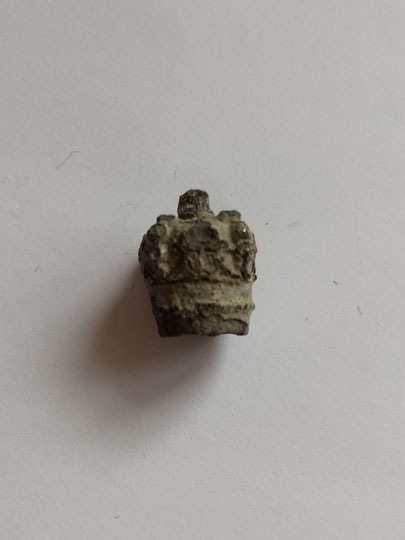
The name 'Tipstaff' denotes both an Officer of the Court, in the role established during the thirteenth century, and the small mace carried to convey the authority of the holder of that position : the hollow Tipstaff containing a rolled court warrant of authority. Whilst there are many of these that are later, it appears that none from the medieval period have been recorded.
The close similarity between this Tipstaff Head and later complete ones evidences longevity of the functional and decorative aspects of their design : in particular, regarding their Heads designed as crowns to evidence Royal authority.
Two apparently unusual aspects are its small size and its portrayal of the crowned head of a King : although these might have been typical in its day. On the other three 'faces' of the Head are a pair of Crosses, a pair of crockets and a pair of figures that most probably are Adam and Eve. Almost certainly made of silver and measuring only 1/2" in height, it is threaded internally : confirming that it is a complete Head and not just the finial of a Head. It was found during the 1990's in Gisburn, Ribble Valley, Lancashire.
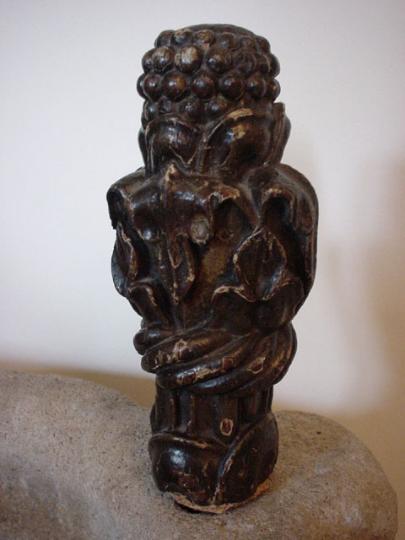
Mention was made, when describing the font cover pulley on a separate page, that font covers could be 'yards high'. Many however will have been of a size and weight realistic for one person to lift without the need for any lifting contraption.
This English fifteenth century oak finial is effectively a handle which was attached to a font cover of modest size in order to facilitate its removal and replacement. Its form, style and decoration is sufficiently formulaic that it can clearly be recognised and distinguished from pew finials of the period.
All of the polychromed surface is original.
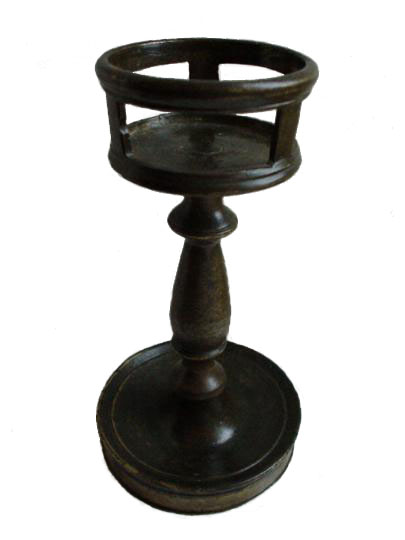
We have cause to be grateful to those who have written on early furniture and objects : including those specialising in candlesticks. One common theme from them has been consideration of the few fundamentally different designs from which have flowed the derivative types we now know. It would appear that this type of stick has not featured at all in the written record. Perhaps this would not have been surprising if it hadn't been for one matter : at least four sticks from a much later date and undoubtedly derived from this early type have been auctioned during recent years. Specifically, how can there be an early stick of a type when others from the period appear to be unknown and yet the type has spawned what we could call style 'reproductions'?
It appears from just one remembered period pictorial reference that this may be an altar stick : albeit from a side altar. What can be said with certainty with the candlestick in hand is that it has been made of good material, to a high standard and probably dates from before the Reformation.
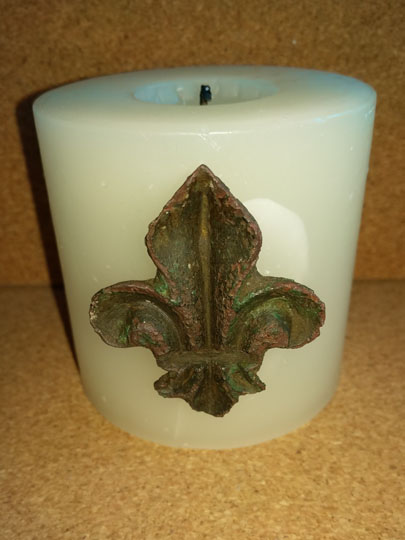
Made of copper alloy and measuring 2 x 1 5/8", the Fleur de Lis was attached to a candle of large diameter by insertion of the still complete pin on the back. As the early Church did not engage in decoration per se, this will have had an overtly symbolic purpose. Such use would not have been engaged in routinely but will have evoked The Trinity or, more likely, the Virgin Mary, on a day or during a period in the Church Calendar.
The Mount was found in the village of South Weald, Essex : close to the Norman church that formerly was within the aegis of nearby Waltham Abbey. Despite this decorative concept having been adopted in the present day, no other medieval examples appear to be extant.
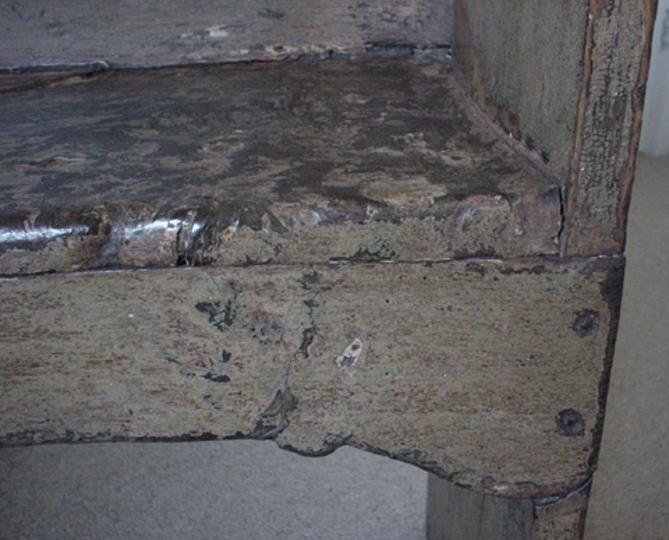
Because this bench is so simple in design, it has been chosen to show a close-up of a key part of it in anticipation that understanding and appreciation will be greater than would have been the case if an overall picture had been displayed. The 3'6" long bench is made of five planks : three of oak and two ( the ends ) of elm. The relationship of four of these can be seen with clarity in this image. The bench is painted in original 'scumble' on each side of each end plank, on the front of the back plank and frieze and on the top of the seat. All other surfaces are completely and originally unpatinated.
This affords a constructionally elegant design the present condition of which speaks well of the maker : most particularly in view of the clear evidence from the state of the painted surfaces that the bench has been thoroughly well used.
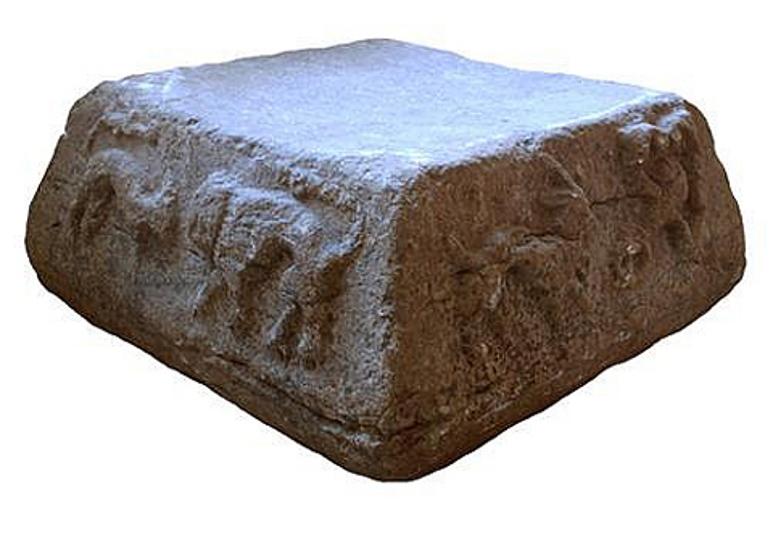
Measuring about 20" square and 10" in height, this extremely dense stone is from an Irish medieval market place. With proud ( ie., not incised ) decoration of animals on all sides, a gently dished top and a pyramidical form, it must have presented a demanding task to the mason. He ( or she ) however clearly rose to the occasion. It is unrealistic to attempt to imagine how it was sited in context but not unreasonable to expect that it was in clear, appreciated view.
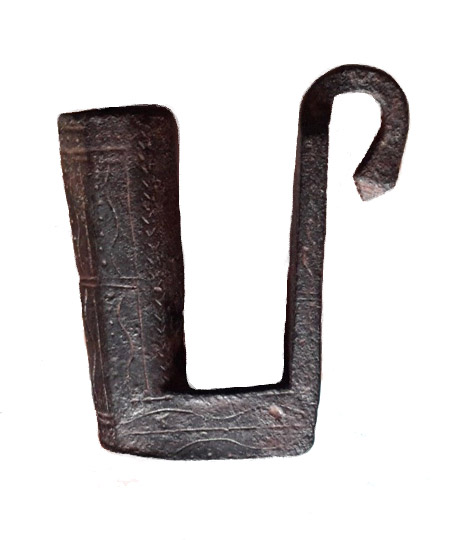
This iron candlestick, reportedly from Norfolk, can in no respect be considered one of a type. Whilst unique is a word to be employed sparingly, perhaps it can be used with justification for such a blacksmith-made one-off. Extensive abrasion of the socket aperture and equally extensive patination of the base confirm that it was in frequent use during a long period of time : rather than having been kept as a mere, precocious exercise in design and manufacture. The handle most probably also was used to suspend it from a hook or other attachment. Clear from the also extensive patination on each side of the base is that it was ( also? ) moved by being held there between thumb and first finger. The condition in which it has survived is a credit both to the maker and probably to that sterling conservator benign neglect.
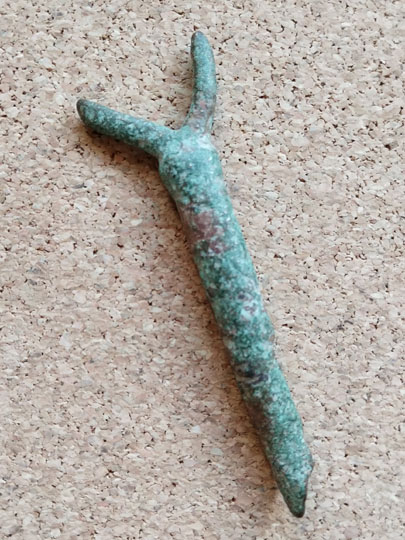
Rush holders, particularly from the 18th and 19th centuries, are plentiful : not least because fakes are being made in volume today. Whilst the dating of medieval candlesticks is facilitated by design characteristics, the simplicity of early rush holders renders dating of them uncertain : if not impossible. Most usually they are made of iron and, even if they were used for lighting during the medieval period on as widespread a basis as were cressets, that they appear to have failed to survive is unsurprising.
Made of copper alloy and now only 2 1/2" high, this Holder is complete except that the lower part of the stem has broken away : whether with or without its possible base. The original, complete height will have been determined to best facilitate positioning of a length of rush in accordance with the needs of the owner. If there had been no base and if used outside, the stem could have been pressed into the ground in no different a manner than could a forked stick. Able to withstand heat and fire caused by the rush, the practicability of the Holder does however clearly transcend that of a forked stick.
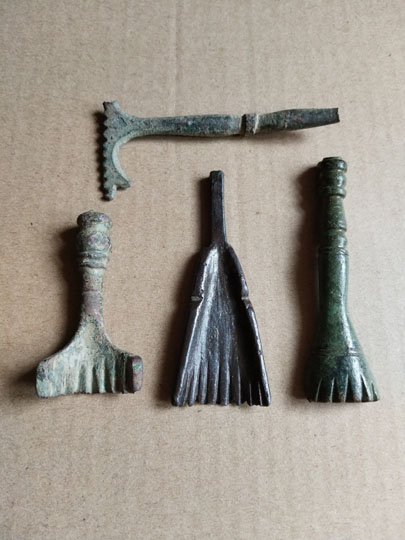
Employed to peel the rind from the pith of rushes used for lighting (as mentioned on the previous page), prior to drying, soaking in a grisset of cooking fat and re-drying, peelers of various types will have been commonplace in modest households for half a millennium and more. That there are four of these in the Collection might lead to the mistaken impression that others are recorded.
Whilst that across the top lacks both one arm and the tip of its handle, the other three are complete. Designed to aid control during use are the two indentations for the thumb nail in the central one and the curves for thumb and finger between the stem and cross-piece of the ones to left and right : irrespective of whether their convex or concave side was in use. The water content of the reed was critical to both the capability to peel it and to it being of sufficient straightness for purpose : otherwise newly cut reeds left unwatered or unrestrained literally curled up. When necessary, reeds were left standing in a container of water. As one or more strands of peel typically were left in place next to the pith in order to support it and to regulate the rate of burning, the Peeler will have been used to score each face of the reed along its length as harvested. The task of peeling must have required considerable, practised dexterity from the children said typically to have been assigned the task.
Whilst the finding location of the one in the centre is unknown, that on the left is from Coventry, on the right from Suffolk, and across the top from Rainham, Essex. Notable, as possibly indicating locations from which reeds were harvested, are the Suffolk Broads and the Thames Estuary Rainham Marshes.
The Peelers from Coventry and Suffolk, being closely similar although not from the same mould, probably evidence a traditional 'standard design' of geographically widespread use.

The 1 3/4 x 1 1/4 x 1" copper Peeler, with thumb and first finger on each side and the second finger wrapped beneath, is held in a thoroughly reassuring manner for effective use. By reason of design, size and the material used in its making, this clearly served a similar function to that of the four Lighting Rush Peelers on the previous page : despite its fundamentally different form. If there had been a material variance in design or size, and/or it had been made of iron, such certainty as to function would have been unacceptably (and academically irresponsibly) contentious.
Found in the late 1970's by the highly prolific archaeologist Gordon Hardcastle, this came from Sutton-on-the-Forest, North Yorkshire : adjacent to the initially prehistoric, major North/South route through the East of England.

Wrought from tin alloy and 1 1/2" in length, although basely simple in form and making this complete Rush Peeler served the same purpose as the six, more complex, cast peelers on the previous two pages.
When held longitudinally between thumb and forefinger, rushes were stripped by drawing them between the chamfered, sharpened inside faces of the blades : the process being aided by the original bend between handle and blades.
The Peeler was recovered during 2021 from the low-lying marsh area of Hob Moor, York : known for its extensive, varied vegetation, including rushes.

Although notably different in form and scale, this served the same function as the peelers on the previous three pages.
Crudely but soundly cast from copper alloy in a sand mould, and measuring 2 1/4 x 1 1/4 x 7/8", it is in complete good order. Specifically, the handle is at its original length.
Nothing is known of provenance other than that the supplier had retained it for many years following purchase from London's Portobello Market.

Whilst there are interesting exceptions by reason of nature of construction, the so-called '6 plank chest' is the form of early chest which has survived in perhaps largest numbers : not least because they were so made from the medieval to the Victorian period. Some chests have notable appeal by reason of material, proportions, colour, texture and metalwork. An early chest which announces its age for unquestionable reasons is of particular interest.
This fifteenth century chest is made of heavy boards and with hinges and hasp in an early leaf-ended form. The outer face of the true right hand end board is adzed : although all other surfaces of each board are sawn. This shows us both something of the cost and value of timber in the medieval period and their approach to practical as well as aesthetic considerations in making furniture.
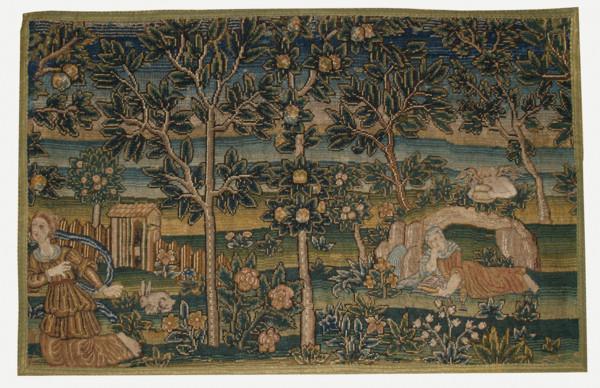
Traditionally the medieval period closes in 1485 at the end of the Plantagenet dynasty. Of much greater consequence and effect on the design of artefacts was the sacking and closure of the monasteries by say 1540. Whilst not dogmatically so, the Collection takes a steer from this date. By any standard, this large piece of needlework is not medieval. Its date during the sixteenth century is however of interest because of its subject : the Annunciation, which depicts the visit of the angel Gabriel to Mary to announce the Incarnation. The attitude towards someone commissioning, owning or displaying such an image varied during the sixteenth century between approval, tolerance and threat to life : this emanating from each current occupant of the throne and their position concerning Roman Catholicism. Whilst at first one would expect this to date from a 'safe' period, it is interesting to consider whether this sylvan scene was designed deliberately to be ambiguous in order to be able to display an image of faith but in the hope that it would be seen as innocently non-ecclesiasiastical. This most probably dates from the relatively tolerant late sixteenth century period of Elizabeth's reign.
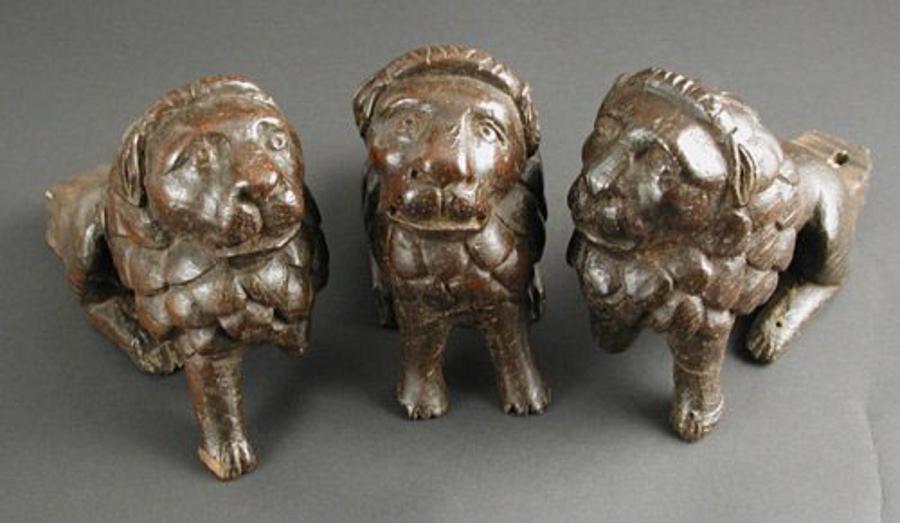
You know the feeling when someone is looking at you. The reader standing at the lectern along the top of the sledge feet of which these three English fifteenth century oak lions lay will have known : or so you would think. Do however look again. Whilst they are looking upwards with heads tilted on one side as though paying close attention, they are facing outwards towards the listener and not towards the reader. To add to the symbolism : the lions have humanoid ears.
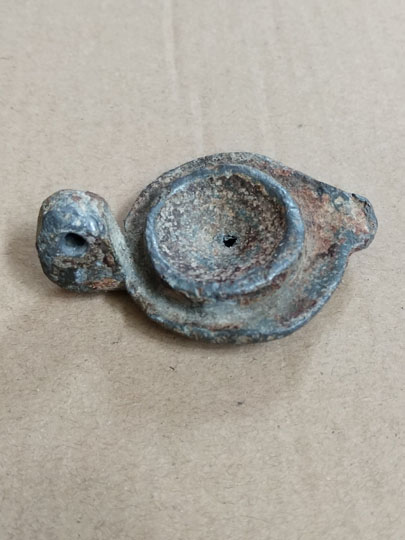
Made of pewter with a high lead content typical of Roman practise, the 1 7/8" wide Candlestick bears stylistic comparison with the much larger nineteenth century brass chambersticks that have survived in considerable numbers. Complete and undamaged : the angling of the handle, not obvious from the photograph, aided secure lifting by its left-handed owner/user. It appears that the extensive deposits bonded to both upper and lower surfaces are of ancient, faded red wax. It was recovered in the 1960's during construction of a house extension in Peasholme Green, York : adjacent to Hungate.
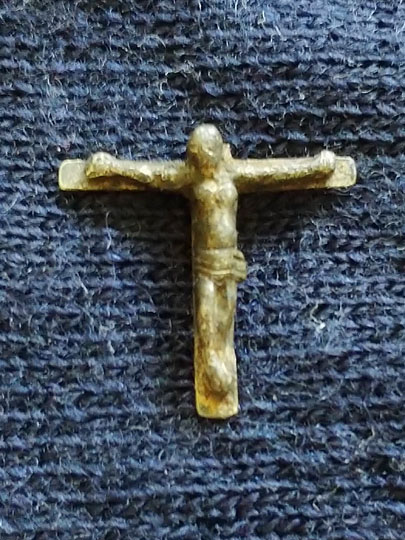
Though few Anglo-Saxon crucifixes are extant, many Thor's Hammers remain : their Norse significance described and recorded extensively in academic and archaeological records.
This Crucifix was recovered from Repton, Derbyshire : the location of a major monastery, where were buried Mercian kings, and of the 873-4 Viking Army winter encampment. The figure of Christ, wrought from heavily gilded tin alloy, is applied to a Cross that is 3/4" high and wide that also is gilded. The reverse is decorated, in camera-defying obscurity, with dragons, runes and a drakkar : in order to represent a Thor's Hammer. The motivation for creating this duality will have been to portray religio-cultural dominance or, perhaps less likely, simply to have reused a physically appropriate and available object.There are other extant examples of similar reuse of religious or mundane objects to create Thor's Hammers : for example, one recovered also from Repton made from period 'scrap' metal and one in the British Museum apparently formed from an element of a 'balance arm' weighing device.
Determination of the actual or intended original use perhaps is aided by its notably very small size. As with at least one other extant Anglo-Saxon example, that it was for sewing to funerary clothing is not untoward. Interest in the adaption does not detract from the artistic presence and rarity of the original Crucifix.
The Crucifix is dedicated to the memory of Fiona (here renamed Julian), a young hedgehog to whom Sanctuary was provided on 16.05.20 following an accident or incident during which she lost a foot. Following having her leg amputated on 18.05.20, she received loving, intensive care until, following days of her brave struggle, she died at 12.08 on 24.05.20. During the period between death and burial on 25.05.20, the Crucifix was kept within her winding sheet. "Feed my lambs".
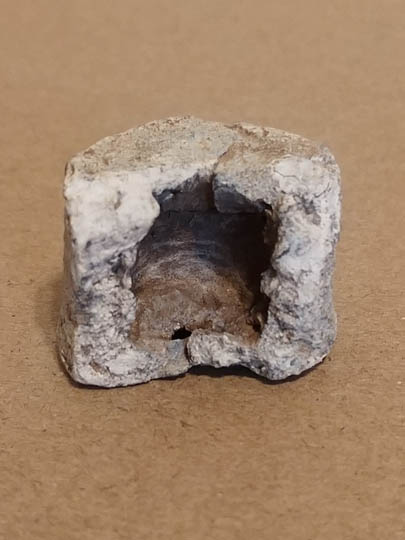
Although Easter was celebrated in this way within each English medieval church, that it also took place on a wholly smaller scale within many small monasteries and individual anchorages/hermitages appears not to be evidenced in writing or in surviving artefacts : excepting this Tomb. However, that such devotional practise did not take place (albeit perhaps in varying levels of detail and scale) is improbable.
Made of lead and measuring 1 x 3/4 x 3/4", the Tomb is complete but for one small hole in the underside. Found 'near Tadcaster', North Yorkshire during the 1960's by the archaeologist Gordon Hardcastle, the probable source of such a function-specific artefact is the former Healaugh Priory : situated very close to Tadcaster and then linked to it by parkland in the same ownership as the village of Healaugh. The Priory was notable for the appointment of St. Hieu (the first woman to 'take the veil' in the Kingdom of Northumbria) as Abbess by St. Aidan of Lindisfarne : who earlier had appointed her Abbess of Hartlepool Abbey.
Uniquely for the Collection, the Tomb is a gift received with gratitude from a descendent of the 1960's finder.
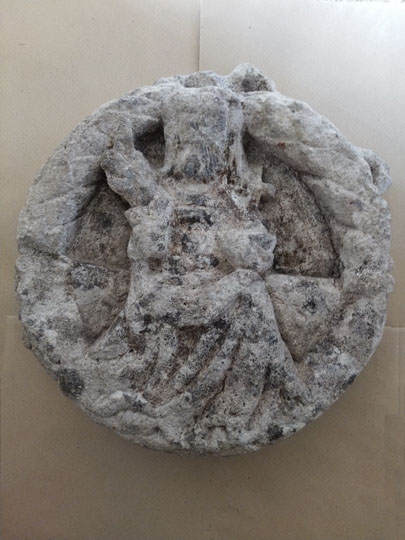
Sadly, the inaccessibility by reason of height of English roof bosses from the Anglo-Norman period did not protect them in the 1530's from attack by Henry's henchmen. By initially stripping the lead, eventually the whole roof, including bosses, succumbed to the weather: many buildings in the care of English Heritage providing evidence thereof.
Found in France and dating from the eleventh century, this 11"x3" granite boss has the risen Christ comfortingly displayed in benediction of his World.
It will of course have differed not at all from those of like form and subject affixed to the junctions of ribs of English monastery roofs. Even the stone used for construction during the period in both England and France is known often to have come from the same deposits.

In response to a request from St. Oswald, King of Northumbria to introduce Christianity to his Kingdom, St. Aidan left Iona in 635 to establish churches (initially constructed of timber) on the tidal Holy Island of Lindisfarne, in a position closely next to Bamburgh Castle, and elsewhere.
By reason of its nature, material, design, and decoration, the Seventh Century Finial will have originated from an ecclesiastical building of the period and, having been recovered by the archaeologist Gordon Hardcastle in 1984 from Spindlestone adjacent to Bamburgh, postulation that it originated from Aidan's Church there is not untoward.
Spanning 1 1/4", the silver from which the Cross is made was striated in an irregular manner to affect the wood of the True Cross. Whilst now fractional, some of the original gilding remains. Also just visible in the base is the broken end of the silver pin by which the Finial was secured to its Staff. it is unlikely that the Staff will have been of greater section than the 3/16" Finial base or that it will have been made of a material other than silver.
St. Bede wrote extensively and in detail about Aidan, Patron Saint of England, his ascetic piety and quietly dedicated service in ministering on foot throughout Northumbria. That the Finial combines richness of material and making with a seemingly overtly pious aesthetic suggests that it might have supported Aidan during his missionary journeying : use by a person of lesser status seeming to be unlikely.
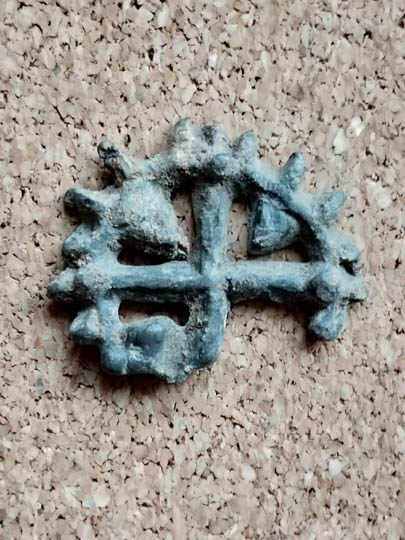
Adjacent to the ruins of St. Mary's Abbey, York is the site of the church built in 1055 and dedicated to St. Olaf, King of Norway by Siward, Earl of Northumbria. According to the Anglo-Saxon Chronicles, Siward, who died in that same year, was buried at the Church. It was replaced only 33 years later with a building of Norman form.
Its size at 1 1/8", design, and making from lead ascribe near certainty that the Cross was placed within the folds of a priest's garment when buried. Provenance of other like crosses, from other sources, affirms such typical use.
Recovered during formal excavation in the 1950s from the site of St. Olaf's, attribution to Siward is a possibility : but no more.

Evidenced in part by the manner of their interment in chapels in the Shetlands and the Channel Islands, porpoises were revered and treated with respect : most likely in response to the finding by Saint Cuthbert of three of them stranded ashore that afforded food at a time of critical need. This was recorded by Bede circa 731 and depicted in period manuscripts.
Made from a nodule of North Yorkshire Moors/Whitby-derived 181 million year-old mineraloid Jet, the Porpoise measures 3 3/4 x 1 1/4 x 5/8". Utilising a nodule of Jet naturally encased in a fine cortex of stone, the only work undertaken to form the Porpoise was to remove both a chip and a pinprick of the cortex in order there to expose the Jet core : hence representing the mouth and the eye. Except for damage that caused an extension of the chip (hence the mouth), a chip from the fin, and extensive patination from handling, the Porpoise is in original condition.
When found in the 1970s by the archaeologist Gordon Hardcastle whilst searching voluminous 'post-dig' spoil in Coppergate, York adjacent to the site of St. Mary's Abbey, the significance of porpoises to the Anglo-Saxons was then unrecognised. Half of the jawbone of a porpoise had been found in 1958, where buried with (otherwise only) 28 fine silver objects beneath the floor of a chapel on the very small St. Ninian's Isle, Shetland. Only later in 2017, following finding of a complete porpoise skeleton in a purpose-made stone grave on the similarly very small island of Chapelle Dom Hue, Guernsey, did the religious significance to the Anglo-Saxons of the porpoise start to be recognised.
There being no means of attachment for wearing invites the postulation that this Porpoise might have served a votive purpose. However, extensive patination from handling leaves no doubt that, even if buried for some time, it served also for some time as a devotional object invoking Cuthbert.